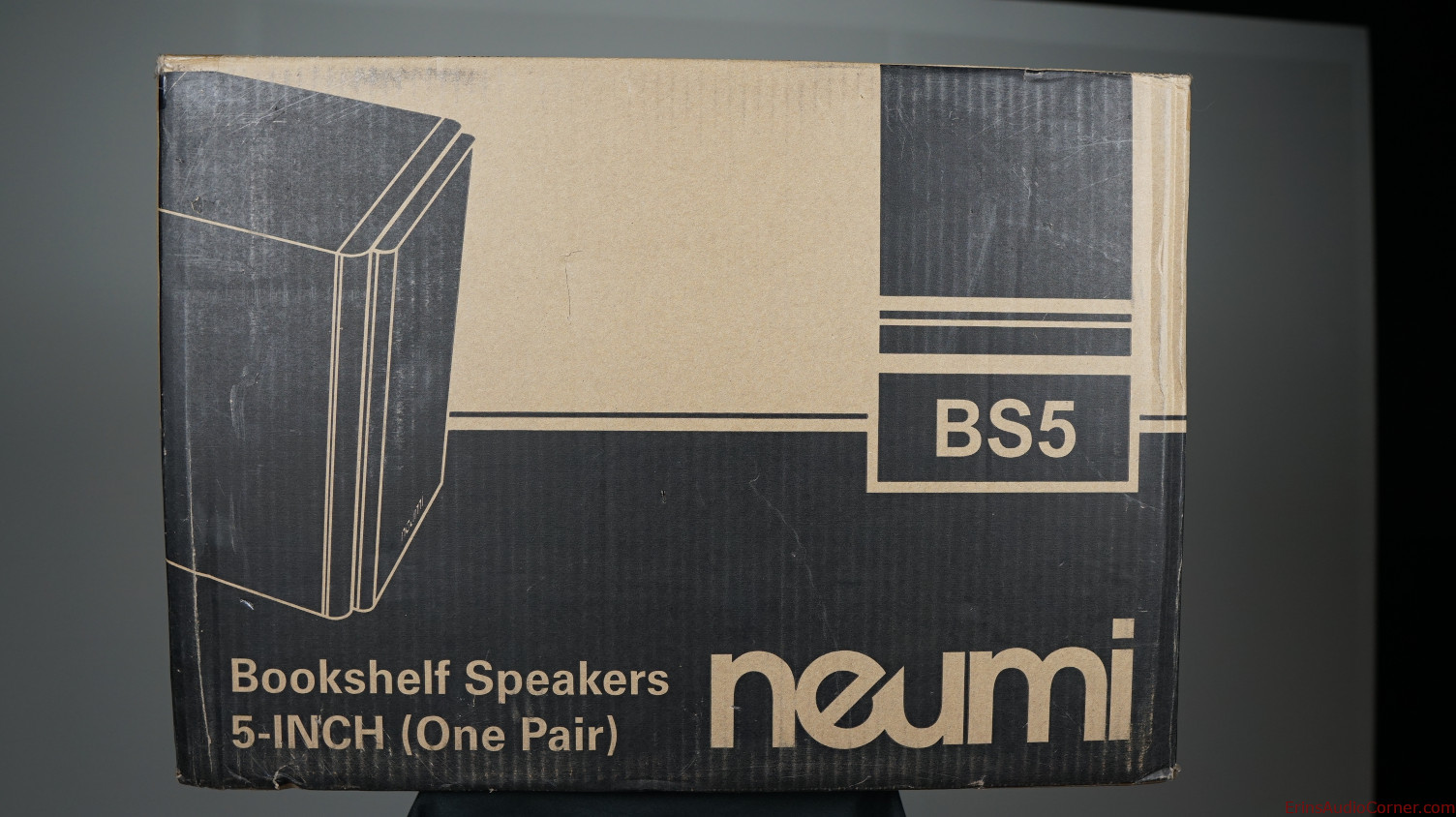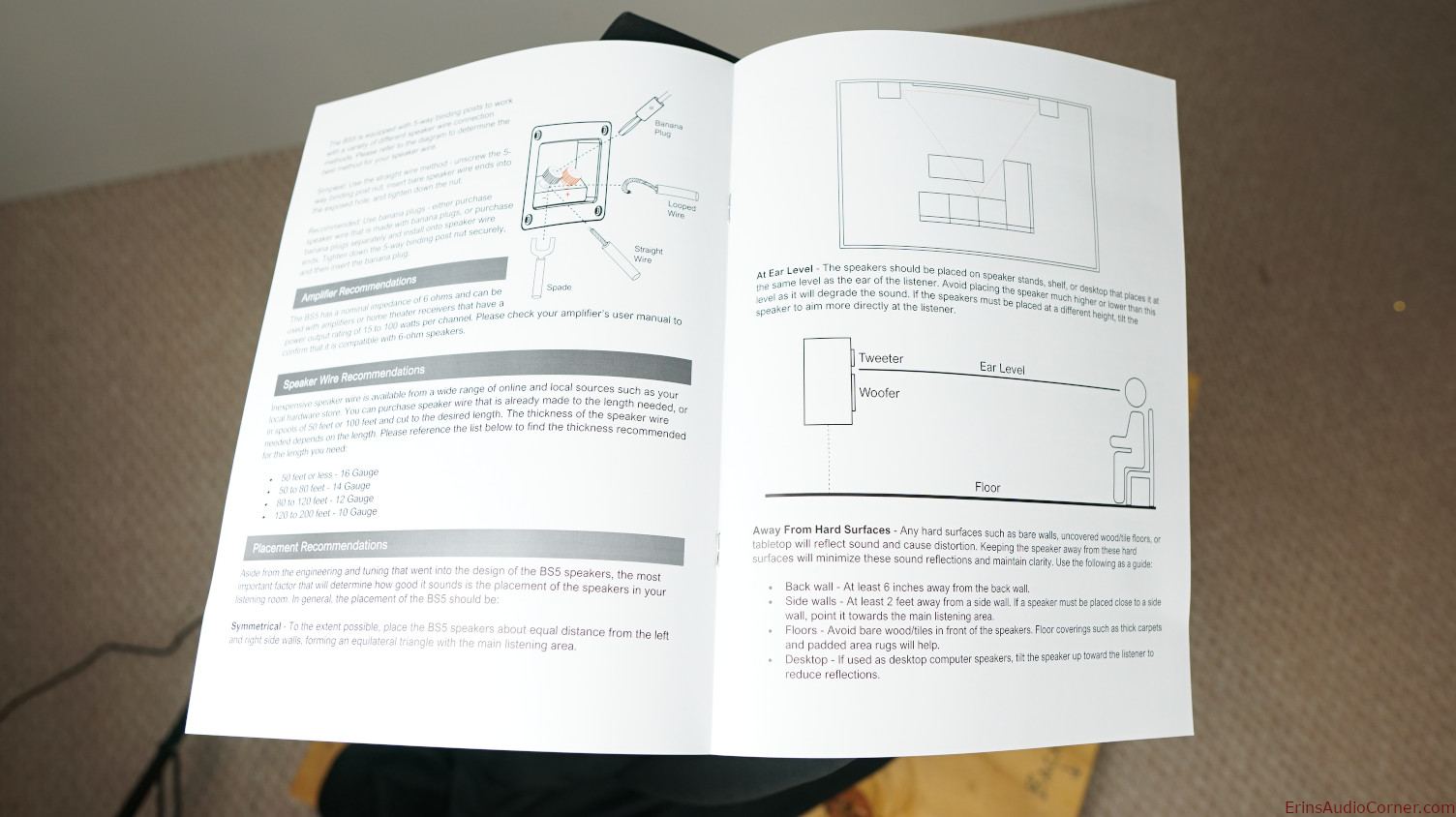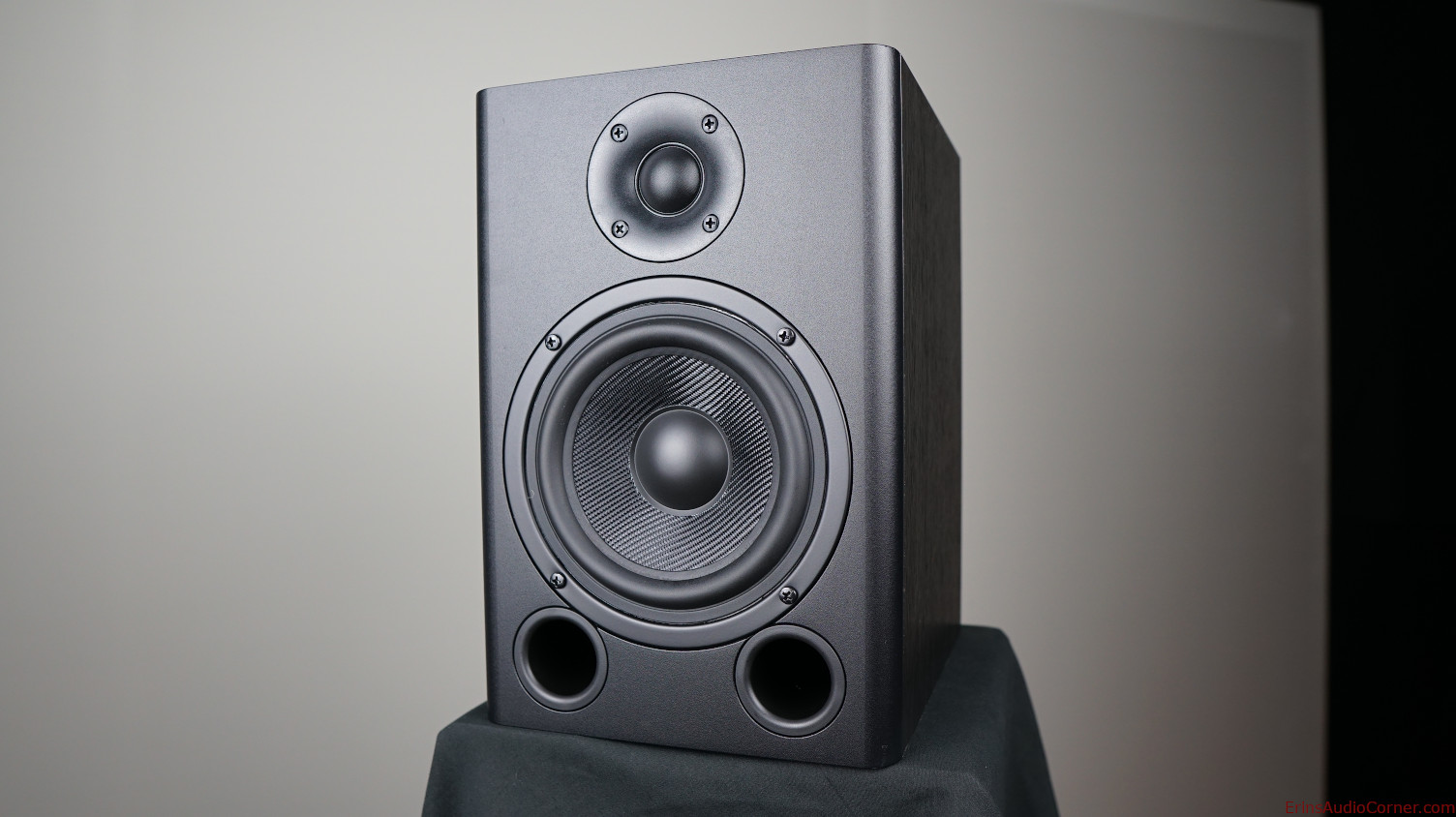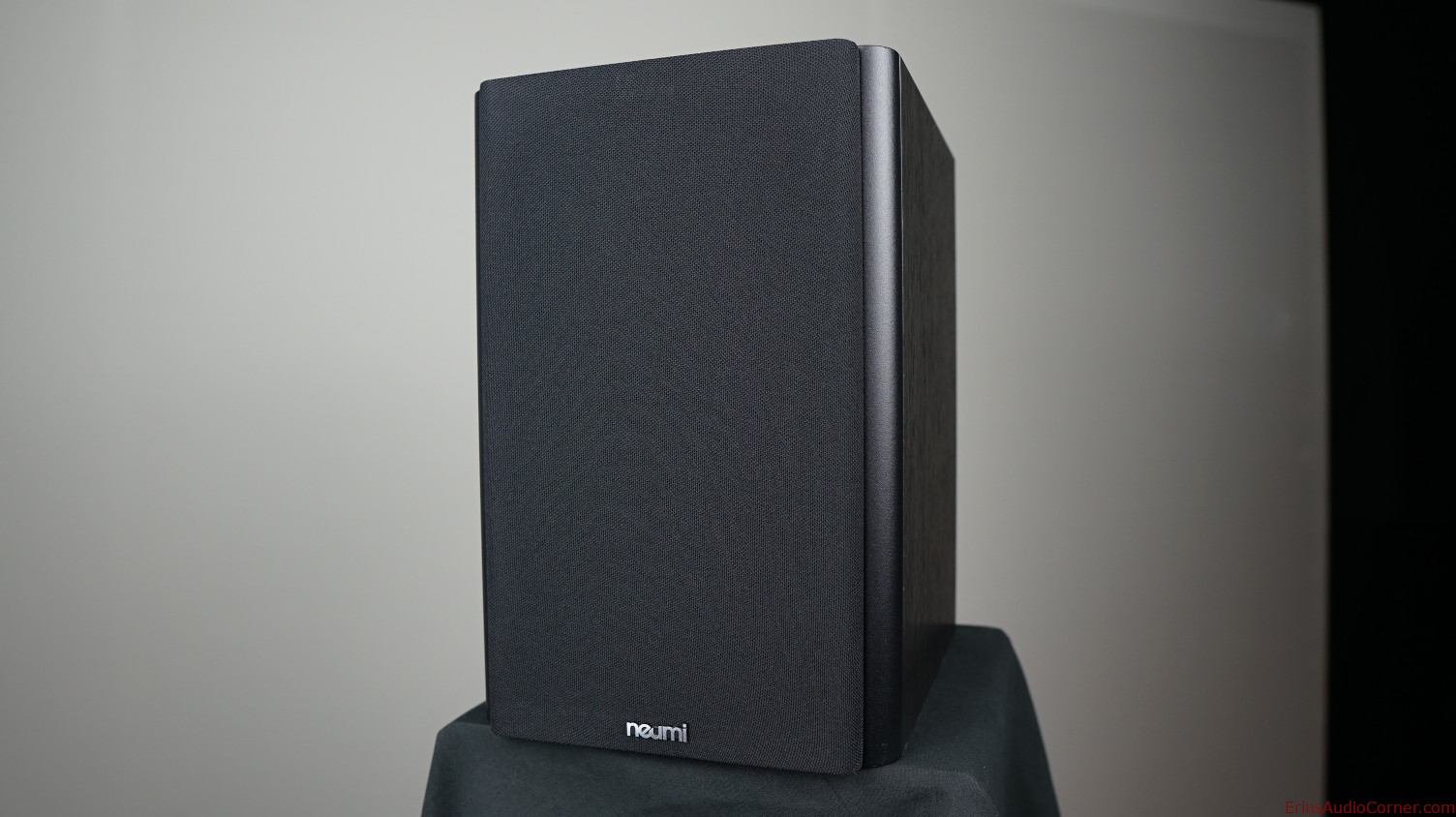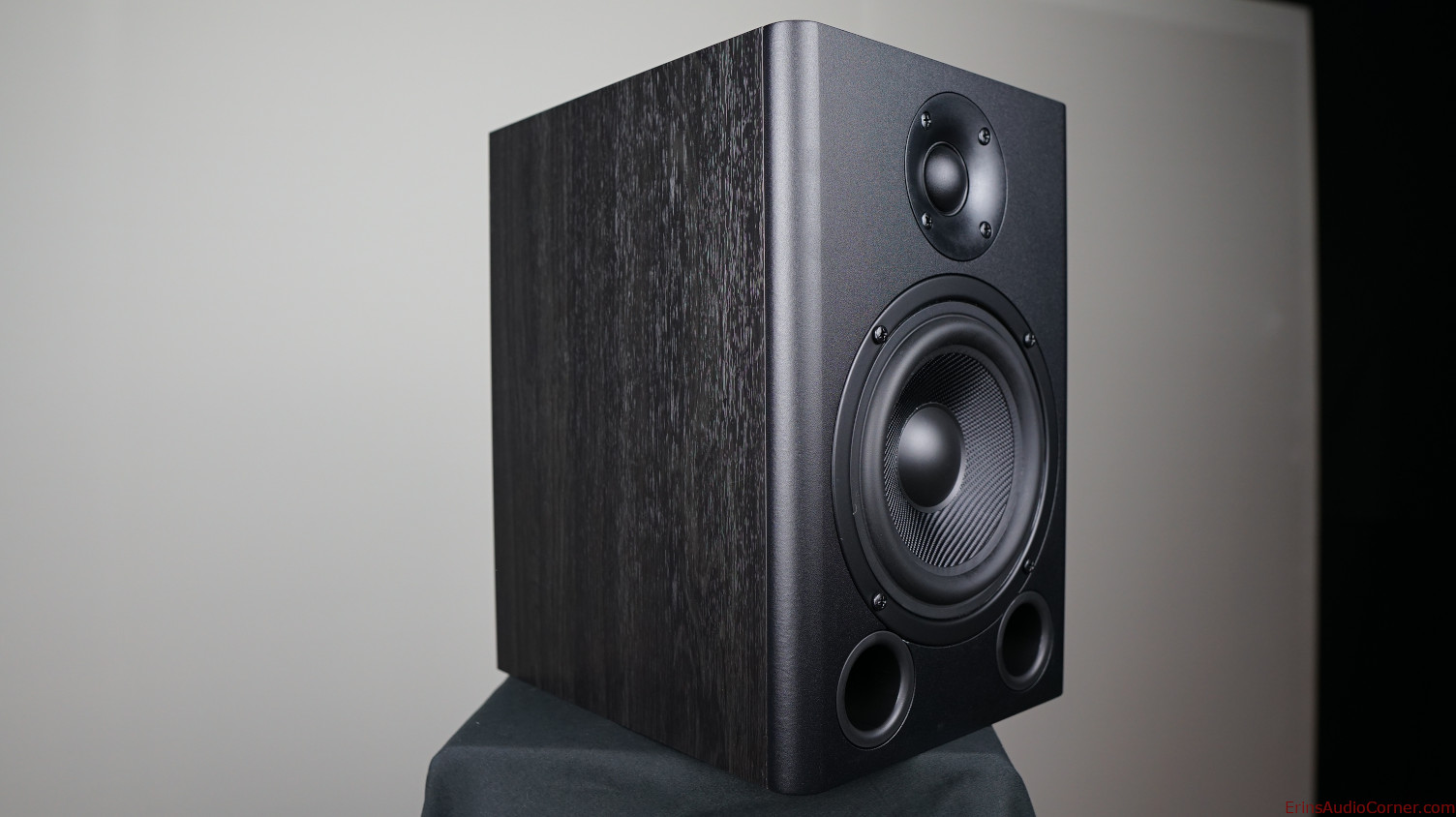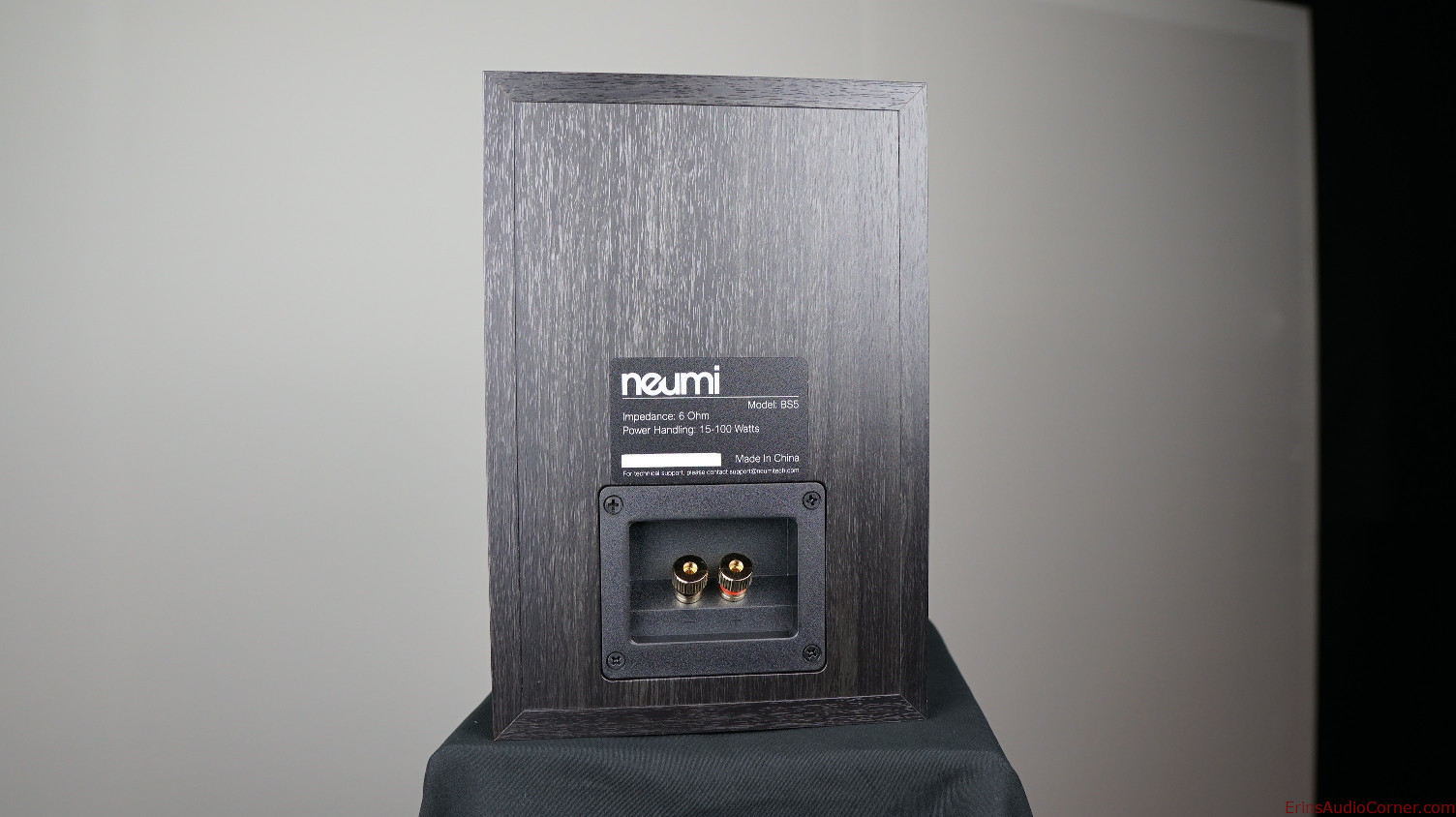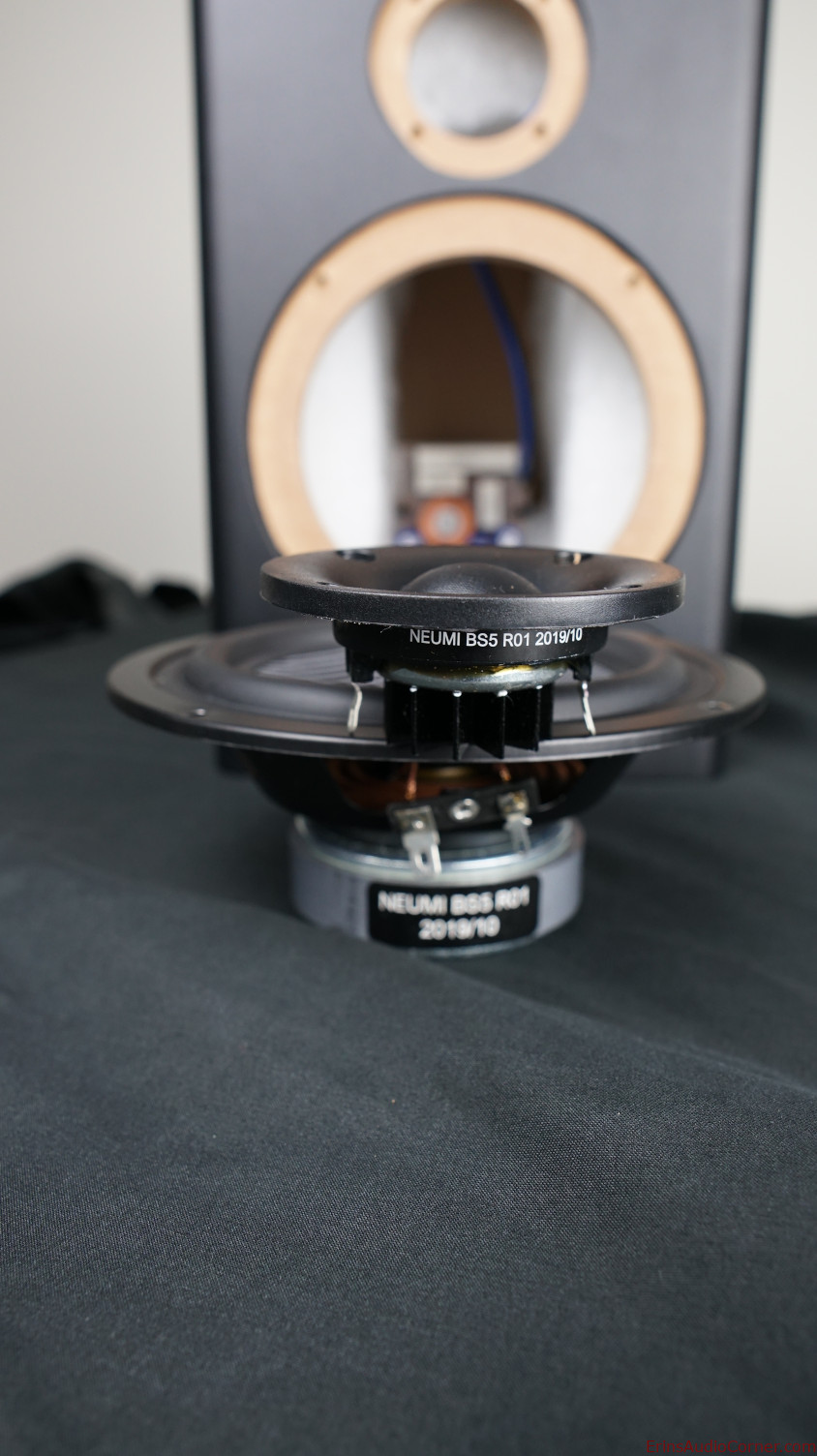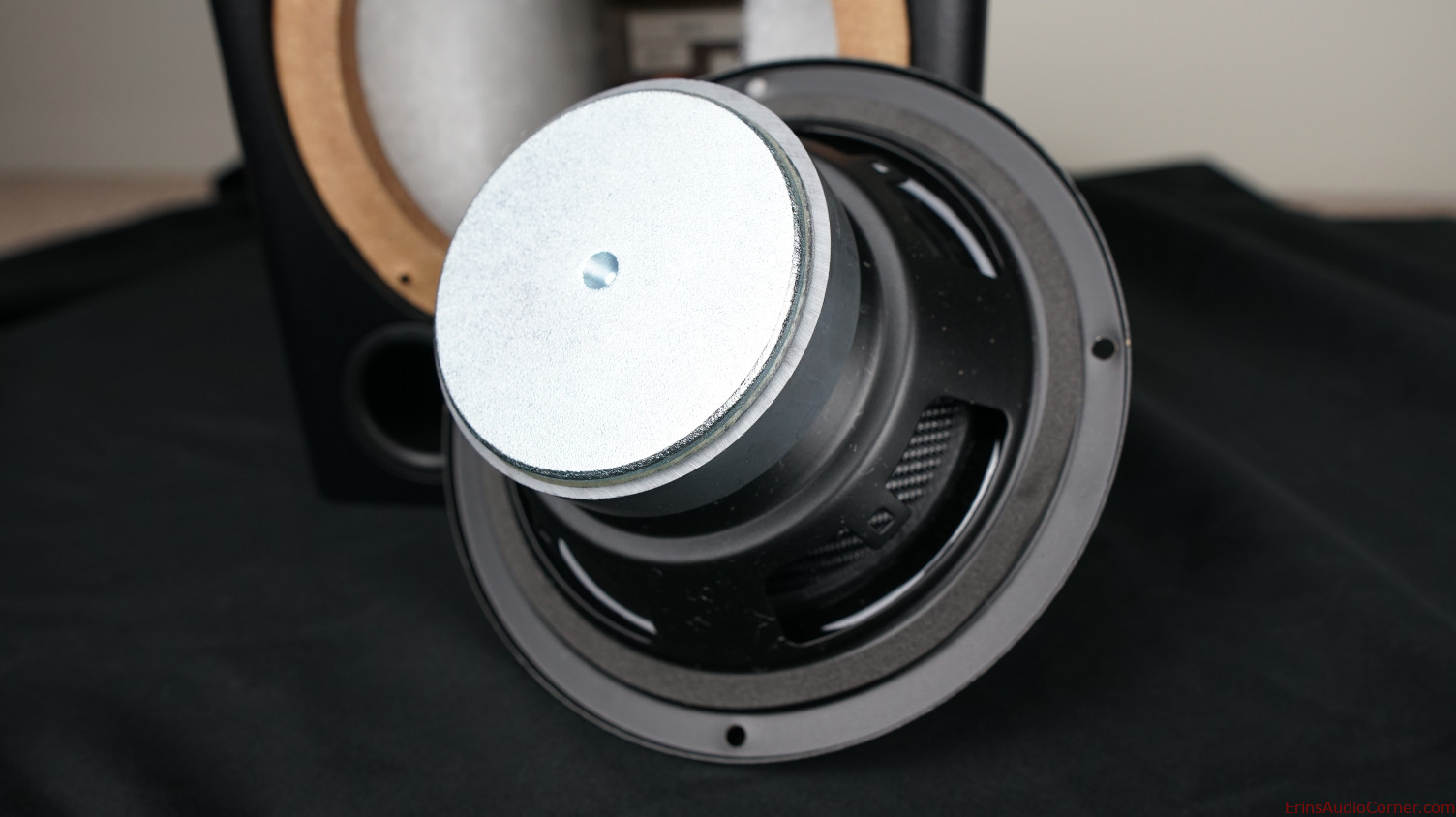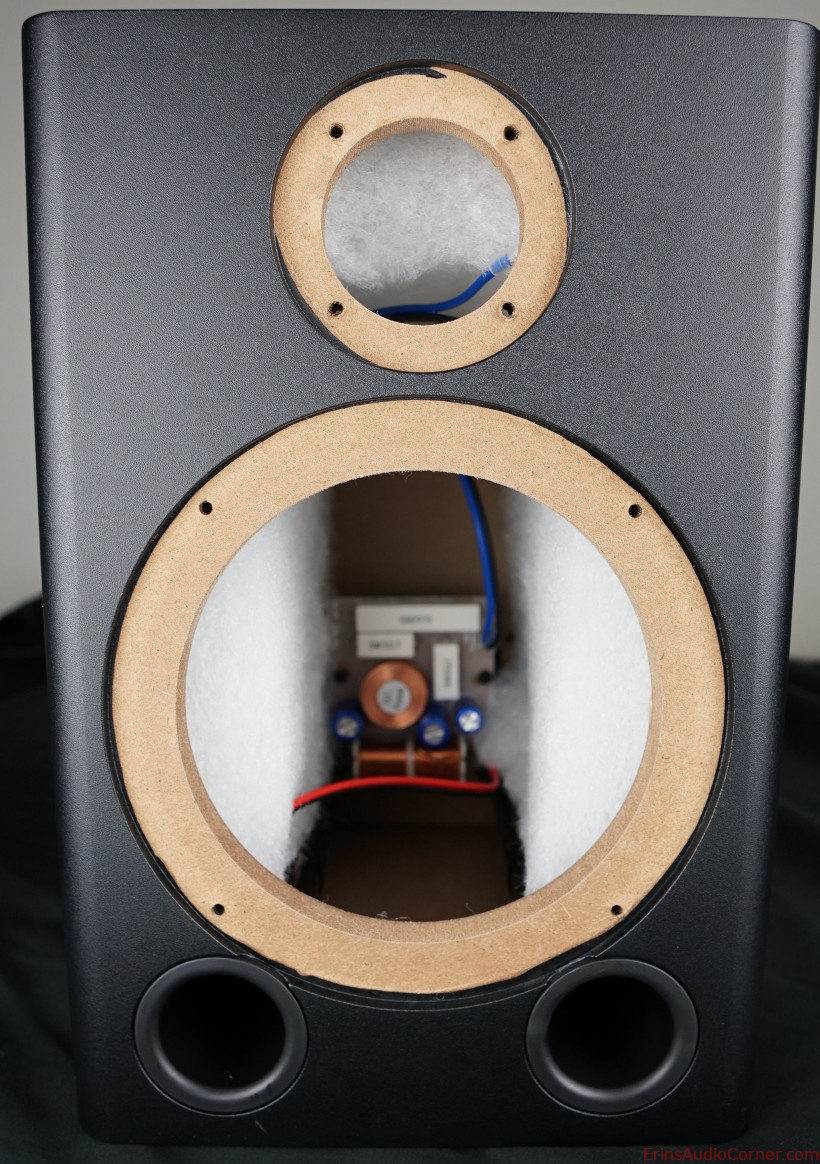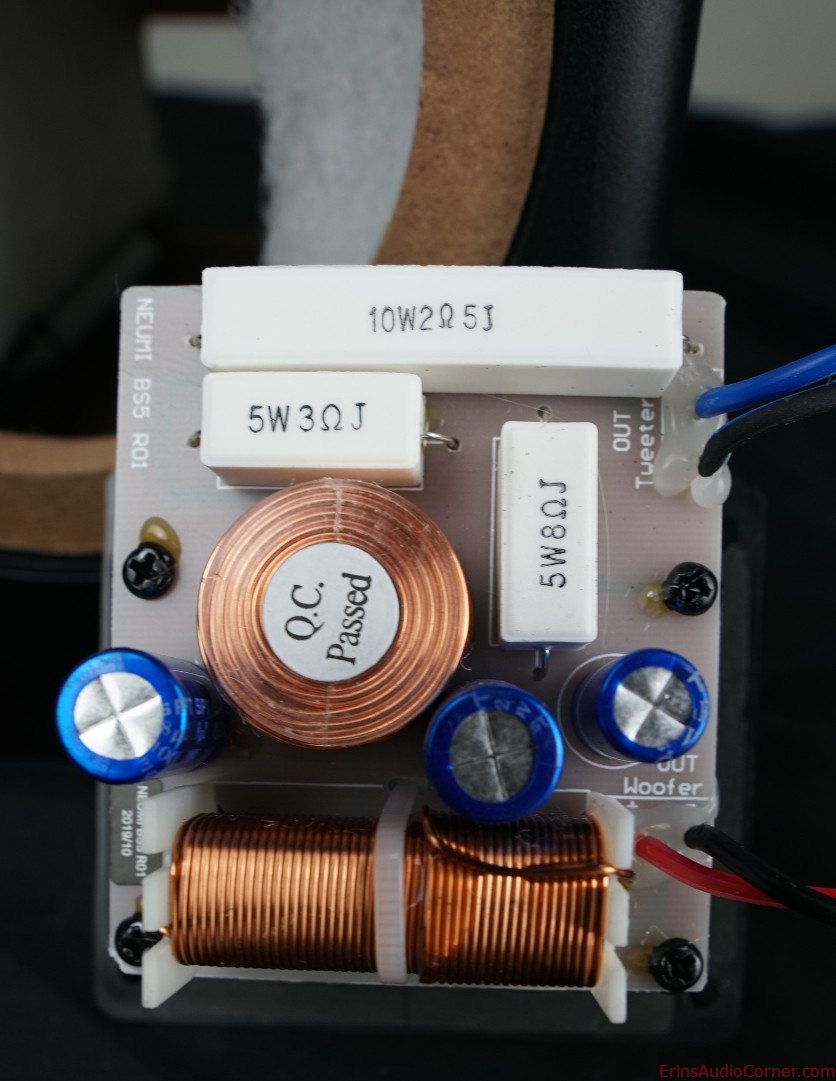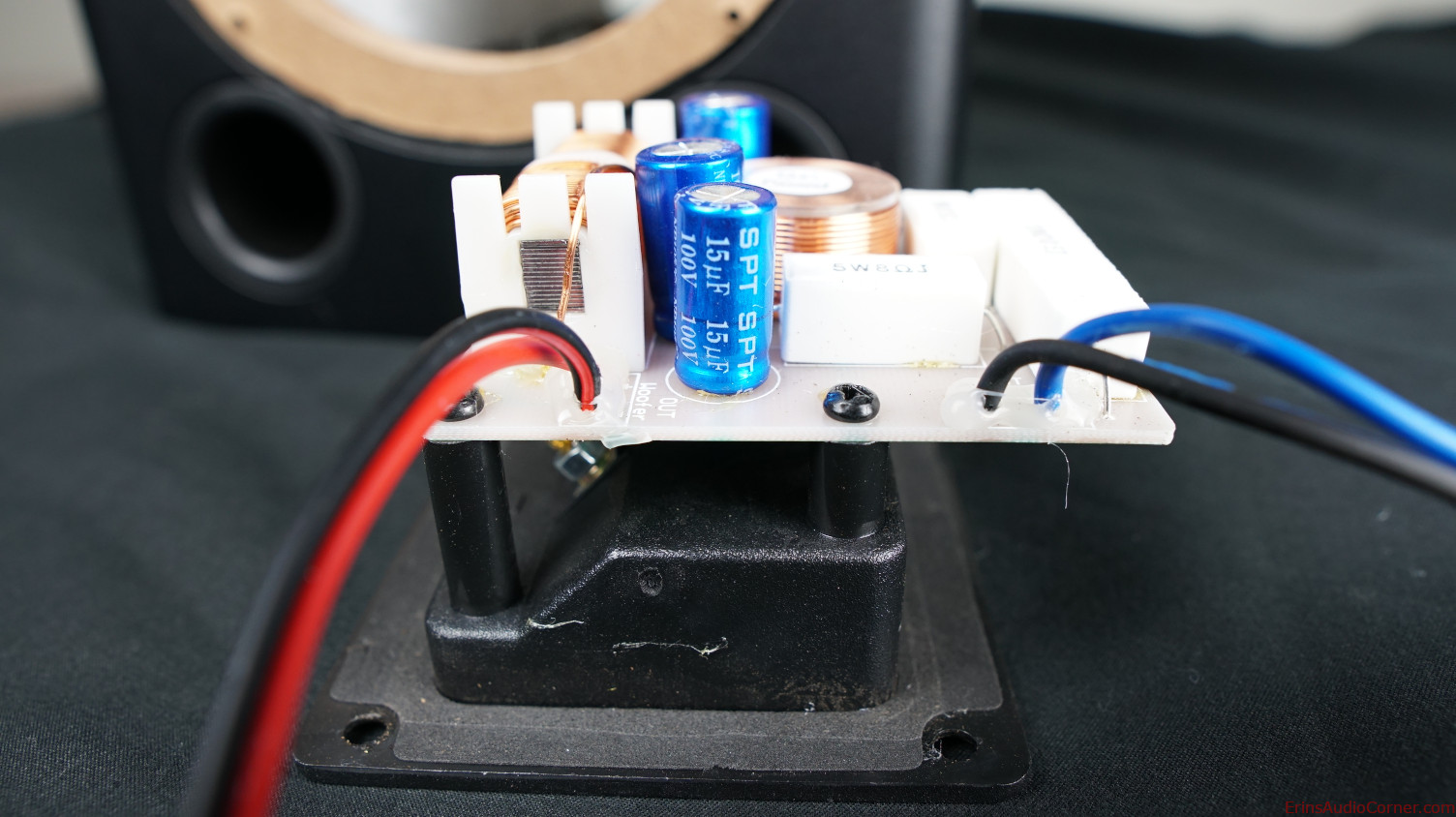YouTube Video Review version:
Intro
I stumbled on talk of the Neumi BS5 speaker recently in the context of a potential high-value speaker. Out of curiosity, I went to the product page on Amazon to check them out and liked what I saw. I then pulled up the Neumi’s BS5 manual here is the link where I saw placement recommendations, and some other bits of information which all gave me the impression the manufacturer cares about how the user listens to their product rather than the old “sink or swim” attitude low-cost products leave you with. Generally, when this information is laid out for the user it also implies the product is worthwhile. At least, that’s the impression I am left with in those cases.
At any rate, Amazon had them listed for $90/pair (at the time of purchase) and I figured they were worth buying to review and pass the information on to the audio community so you all could either avoid them or feel comfortable spending your hard earned money on. So, I did.
Ultimately, while these aren’t the best performing speakers I’ve tested or heard, I do believe these provide a good value to the budget-limited audiophile. And, with a few engineering alterations, could be made into an even better value. Read on for more detail.
Below is my Amazon affiliate link if you are interested in purchasing this speaker through it. Doing so helps me get a small (very small) percentage at no additional cost to you, which helps to keep this site up and running and me pumping out more reviews. I wouldn't provide the link in this fashion if I didn't recommend them based on price/performance.
Foreword: Subjective Analysis vs Objective Data (click for more)
If you have seen my past reviews, you know that I am of the mindset that objective data is at least as important as someone's subjective evaluation of a speaker. If not more. Why? Because every room is different. Every listener is different. Some know what to listen for. Others know what they want to hear based on their own preference (i.e., some prefer extended bass, some prefer more midbass punch between 120-150Hz, some prefer a response with a dip around 4kHz, etc., etc.). What one person wants or expects may be opposite of another. Additionally, the room will impact the performance and therefore what the listener hears. This means when you read another's subjective-only review you are left to resolve those variables on your own. That's not likely to happen. Unless there is objective data you can use to get an idea of the performance. With objective data you can begin to understand why the subjective review turned out the way it did. Notably, objective data keeps reviewers honest. It's hard for a reviewer to legitimately bash one product but elevate another when the two measure practically the same in every regard. Not to say two similarly measuring speakers cannot subjectively sound different. Though, odds are if they do measure the same then a huge subjective difference is most likely attributed to other issues such as setup conditions, bias, etc. Objective data is the key to accountability. Simply put: if the measurements are taken with care and you understand them, you can rely on data to help paint a more accurate description of performance than a few adjectives from your favorite reviewer (myself included). As you will see, objective measurements can provide a lot of insight in to how the speaker will perform in your room.However, when possible, it is always best to demo speakers in your own room. Not simply because of subjective performance. But because of other factors such as aesthetics, pride of ownership, etc. In my experience, all these factors play in to how the listener “connects” with the system. A good shop or manufacturer understands this and allows buyers to try items out at home before purchasing or they offer a reasonable return policy. If you question the performance and can demo the speakers in your own home, I suggest you take advantage of the opportunity.
For all the reasons listed above: What I provide here is objective-heavy analysis. I still provide my own subjective experience but with in-room measurements at my listening position(s) so we can understand why I heard what I heard. Is it the room, the actual speaker itself, my brain, or a combination?
Now that you understand my motives, let’s get started with the review.
Product Specs and Photos
Let’s look at the manufacturer’s specs pulled from their product page.
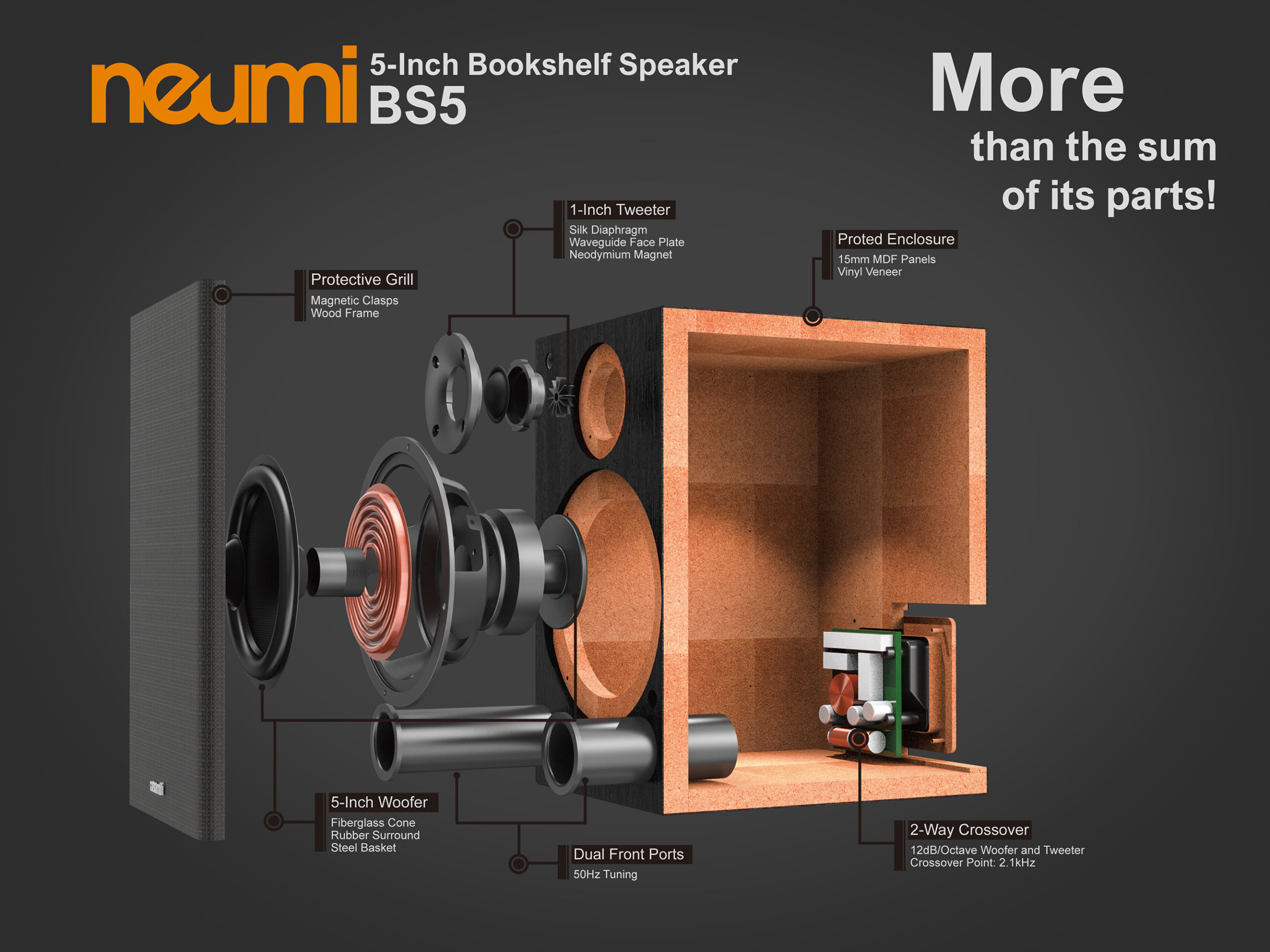
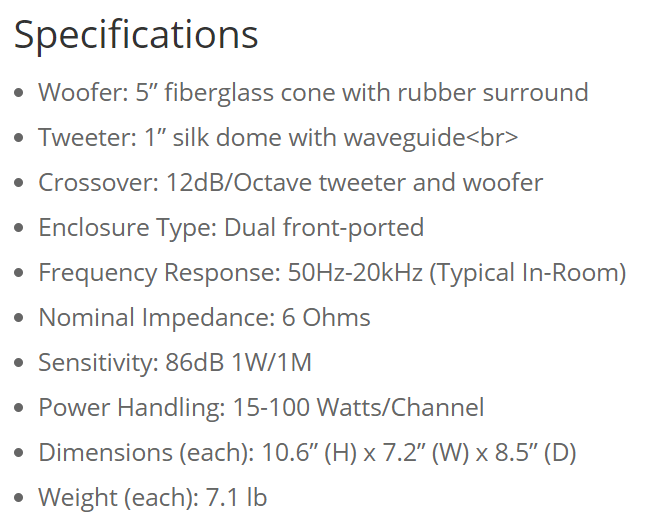
I’ll come back to some of these later. But since I feel I have to say something here… look how light these things are!
Moving on to the pictures…
Grille On:
Grille:
Drive Units:
Cabinet (1/2-inch thick MDF)
Crossover
The tweeter reminds me of this Peerless 1-inch dome tweeter: https://www.parts-express.com/peerless-by-tymphany-bc25sc06-04-1-textile-dome-tweeter--264-1028
Objective Data
Unless otherwise noted, all the data below was captured using Klippel Distortion Analyzer 2 and Klippel modules (TRF, DIS, LPM, ISC to name a few). Most of the data was exported to a text file and then graphed using my own MATLAB scripts in order to present the data in a specific way I prefer. However, some is given using Klippel’s graphing.
Impedance Phase and Magnitude:
Impedance measurements are provided both at 0.10 volts RMS and 2.83 volts RMS. The low-level voltage version is standard because it ensures the speaker/driver is in linear operating range. The higher voltage is to see what happens when the output voltage is increased to the 2.83vRMS speaker sensitivity test.
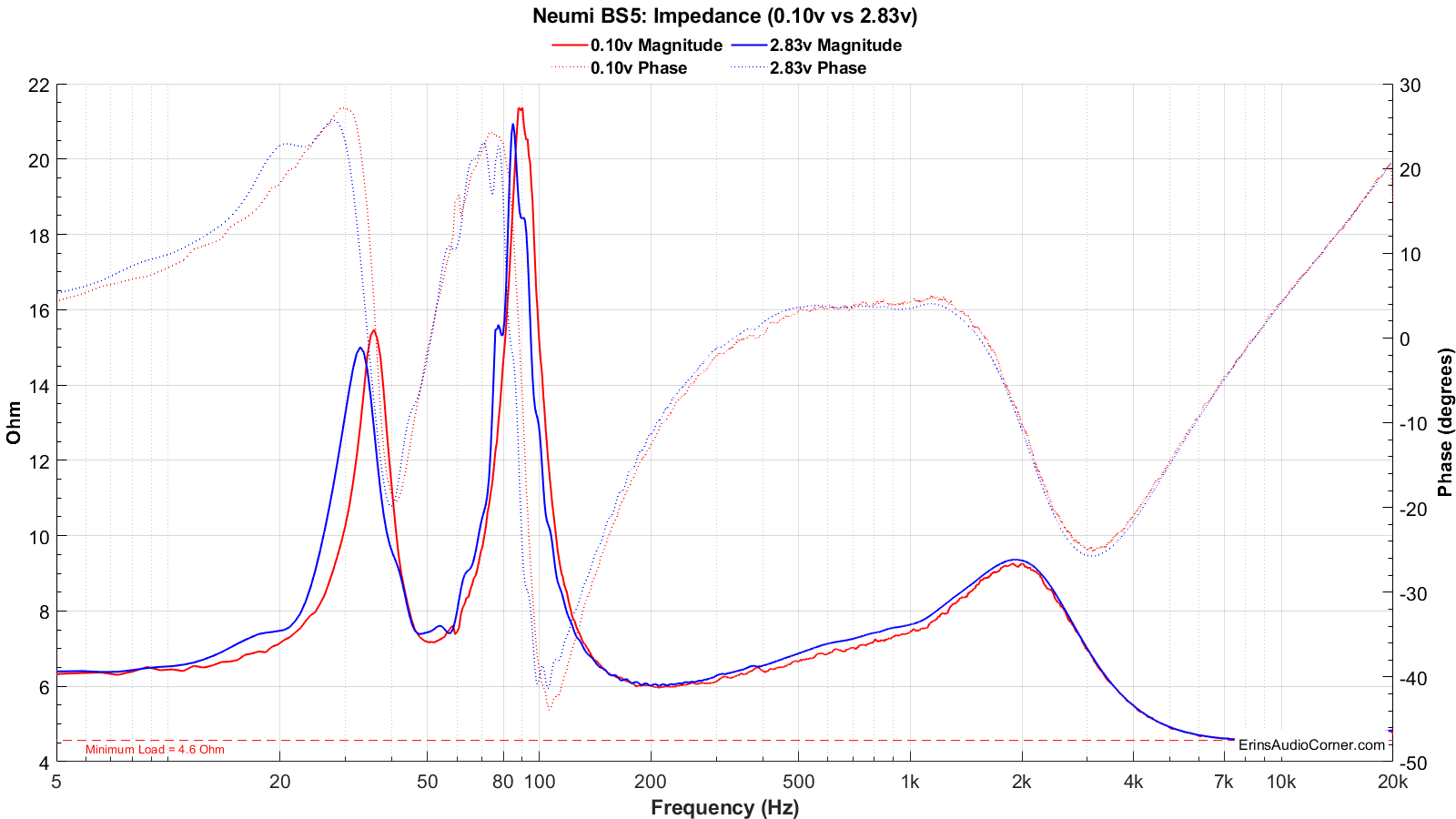
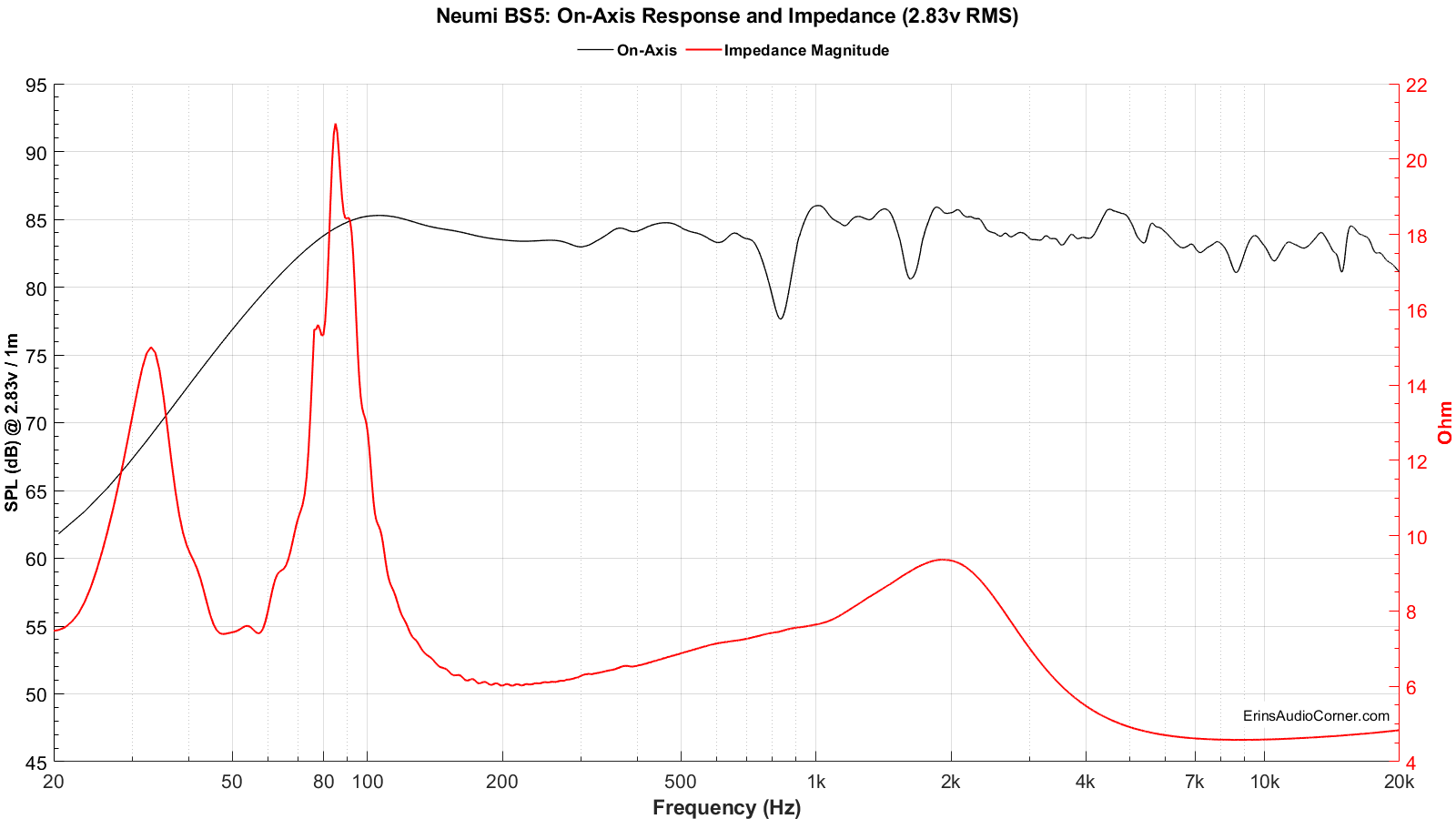
From the above data we can see the following:
- The tuning frequency of the enclosure is approximately 50Hz (jives with Numei’s spec)
- The minimum impedance dips to about 4.6 Ohms above 7kHz, almost assuredly meaning a 4-ohm tweeter was used here which is odd when you realize the HF treble. Below this, however, the minimum load is approximately 6 Ohms, as Neumi states. The 4-ohm high frequency section shouldn’t be an issue because power is so low here compared to bass, however, not all AVRs will handle a 6 Ohm load for an extended period. Double check your amplifier/receiver to make sure it will be compatible with a 6 Ohm (nominal) load.
- There are some funny things going on at approximately 90Hz; there is no smooth impedance peak here. Rather, it is marred. Below this there is also some funny business near the tuning frequency. These wiggles, for a lack of a more scientific word, typically indicate resonance that shows up in the frequency response. Unfortunately, I would need much higher resolution in my data to discern any resonances below 100Hz. My frequency resolution is in the 20-30Hz region. Less than 5Hz would be needed to see resonance at this frequency. However, there are two spots where the impedance wiggles that translate into modest dips in the frequency response around 200Hz and 280Hz (eyeballing these).
Frequency Response:
Notes about measurements (click for info)
Frequency response data (horizontal, vertical, “Spinorama”, polar, spectrograms, etc.) are all based on a 2.83 volts RMS logarithmic sweep at 1 meter to meet the standard sensitivity measurement spec. These data are captured using Klippel’s TRF module and a mixture of ground-plane measurement and 4-pi free-field measurement. Klippel’s In-Situ Room Compensation (ISC) module is then used with the ground plane measurement to provide a ‘reference’ curve to the 4-pi measurement which then corrects for the room’s influence and allows me to generate a reflection-free far-field response from an indoors measurement. Note: This is not a standard merge of nearfield and farfield nor a merge of ground-plane and farfield. Typical merged responses still suffer low resolution in the midrange where the response is merged due to the necessity of windowing the impulse response to remove reflections. One major downside to “gating” or “windowing” the impulse response is this low-resolution does not show resonance in the midrange. For example, most free-field measurements are only reflection-free until approximately 3 milliseconds, or about 300Hz. That means a data point every 300Hz. If you have a high-Q resonance at 450Hz the 300Hz resolution data will not show this resonance because the frequency resolution only has a data point at 300Hz and 600Hz; skipping right over the 450Hz. You would need a resolution of at least a half the width of the Q-factor; generally, 20Hz is adequate. However, 20Hz resolution is roughly 50ms of window-free response. The only way to achieve this is in a large parking lot or open field. Ground plane measurements are perfect for this but are subject to aiming/ground absorption (grass) and related issues above 400Hz. The ISC module permits results with as-close-to-anechoic as one can achieve without being anechoic. Thanks to the ISC module, the data I am providing here is higher resolution (~30Hz resolution) than an average person can provide without access to an anechoic chamber or the like.
The measurement below provides the frequency response at the reference measurement axis - also known as the 0-degree axis or “on axis” plane - in this measurement condition was situated in-between with the woofer and the tweeter per the product manual. While the manual does do a good job of directing the user how to set up the speakers, I emailed Neumi to ask about listening angle and the grille use. I wanted to make sure I used the speakers the way they were designed to be used. Below is our email exchange:
I purchased your BS5 bookshelf speakers and was wondering:
- Are these designed to be listened to on-axis (with the speaker aimed directly toward the listener) or at some angle off-axis? I assume the former.
- Are these designed to be listened to with the grilles on or off? I assume off, as most speakers perform worse with the grilles on. Thank you.
Hi Erin, Thank you for your inquiry! The BS5 are designed to be listened to pointed straight forwards. If you like to have a slightly brighter response, you can point the speakers more towards the center position. We also tuned the BS5 without a grill. The grill was made afterwards to minimize its effect on the speaker output. It is fairly transparent but does change the response slightly.
If the speakers are to be aimed facing forward, that would be approximately 30-degrees off-axis in my room. I can toe them in or out if you recommend using a different positioning angle than this.
Hi Erin, Thanks for the additional information. I would start out pointing straight, then try it with 10-15 degree toe-in and see how that sounds to you, more than that, the toe-in would be pretty extreme and is not recommended.
So, per Neumi’s direction I listened to the speakers both on-axis (0°) and off-axis (≤30°) horizontally. I found the best angle to be directly on-axis. Otherwise, the treble was too subdued. When it came time to measure the speaker, I verified that 0° gave the most linear response and conducted the rest of my analysis with the reference axis being at 0° horizontally and between the mid/tweeter vertically.
Also, per Neumi’s direction, the grille was off for these measurements. I do have comparison data of the grille on vs off in my Miscellaneous section below.
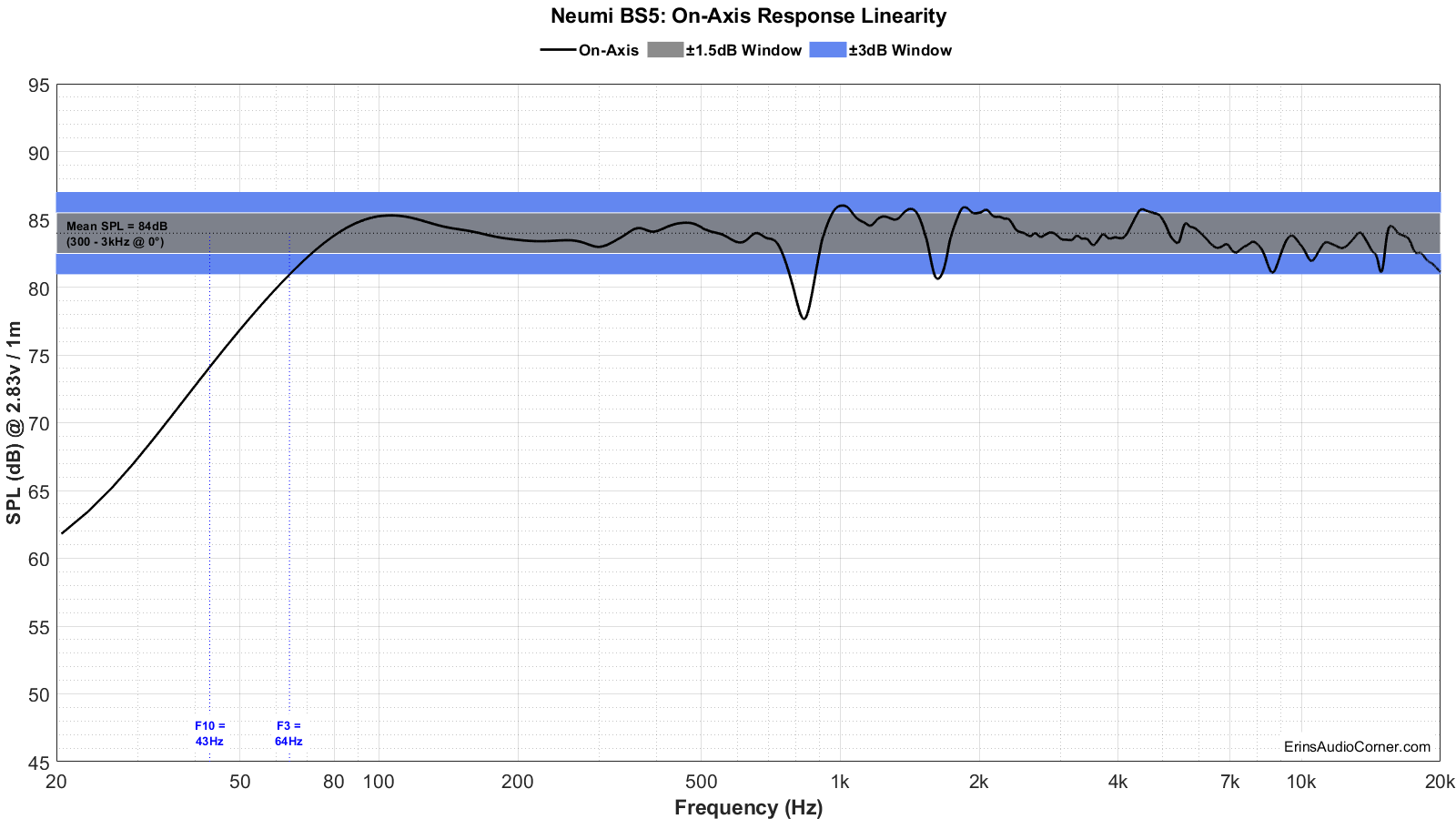
The mean SPL, approximately 84dB at 2.83v/1m, is calculated over the frequency range of 300Hz to 3,000Hz.
The blue shaded area represents the ±3dB response window from my calculated mean SPL value. As you can see in the blue window above, the Neumi BS5 has a ±3dB response from 64Hz - 20kHz but only if you ignore the dip in response around 800Hz. Neumi claims a ±3dB window of 50Hz - 20kHz (typical in-room). I don’t believe their spec is a reach but obviously the notch at ~800Hz throws things off. Unfortunately, this notch is pervasive and is brought on by the port, as far as I can tell (more discussion in the Near-Field measurements portion further down). A tighter window of linearity is provided in gray as ±1.5dB from the mean SPL and this speaker does a decent job of trying to stay within that range but the port noise at 800Hz and ~1600Hz make things fall out of that window fast. The treble above 8kHz also begins dipping/peaking enough to keep it out of the tighter window.
The speaker’s F3 point (the frequency at which the response has fallen 3dB relative to the mean SPL) is 64Hz and the F10 (the frequency at which the response has fallen by 10dB relative to the mean SPL) is 43Hz. For a small, and super light bookshelf speaker with a 5-inch woofer this is on par with what you would expect. You’re going to need a subwoofer if you want low bass and/or decent output below 100Hz.
Below are both the horizontal and vertical response over a limited window (90° horizontal, ±40° vertical). I have provided a “normalized” set of data as well. The normalization simply means that I took the difference of the on-axis response and compared the other axes’ measurements to the on-axis response which gives the viewer a good idea of the speaker performance, relative to the on-axis response, as you move off-axis.
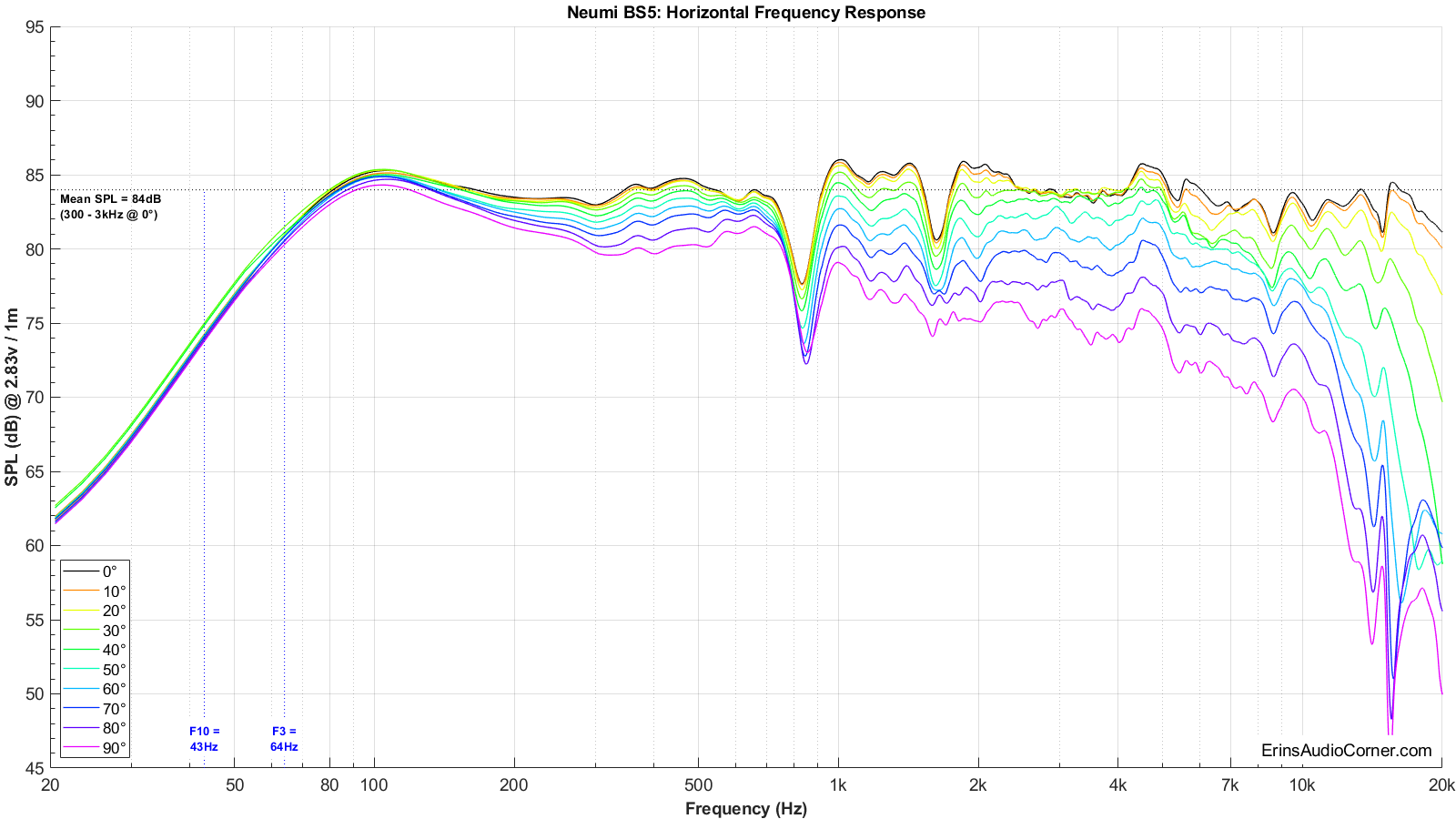
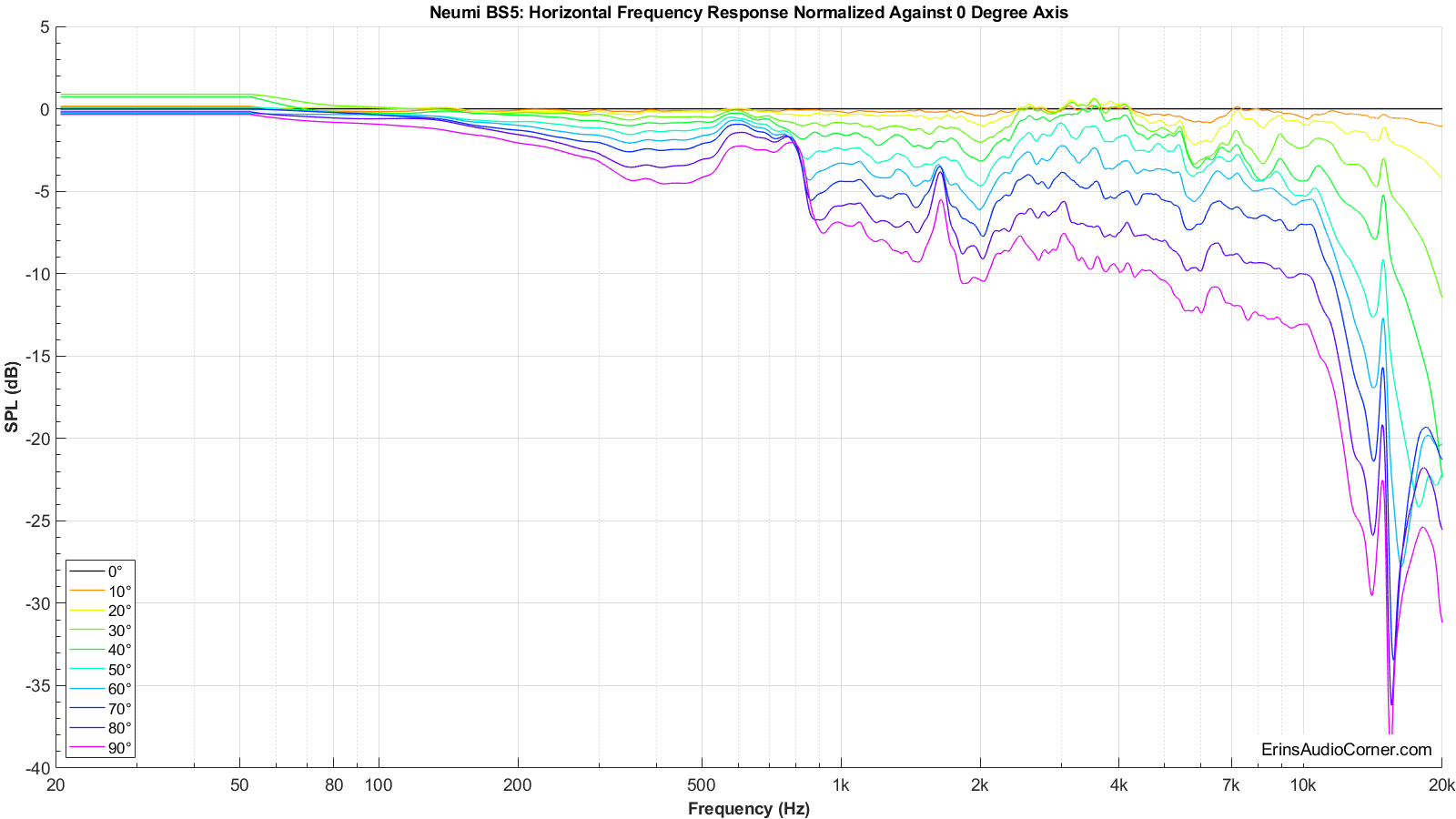
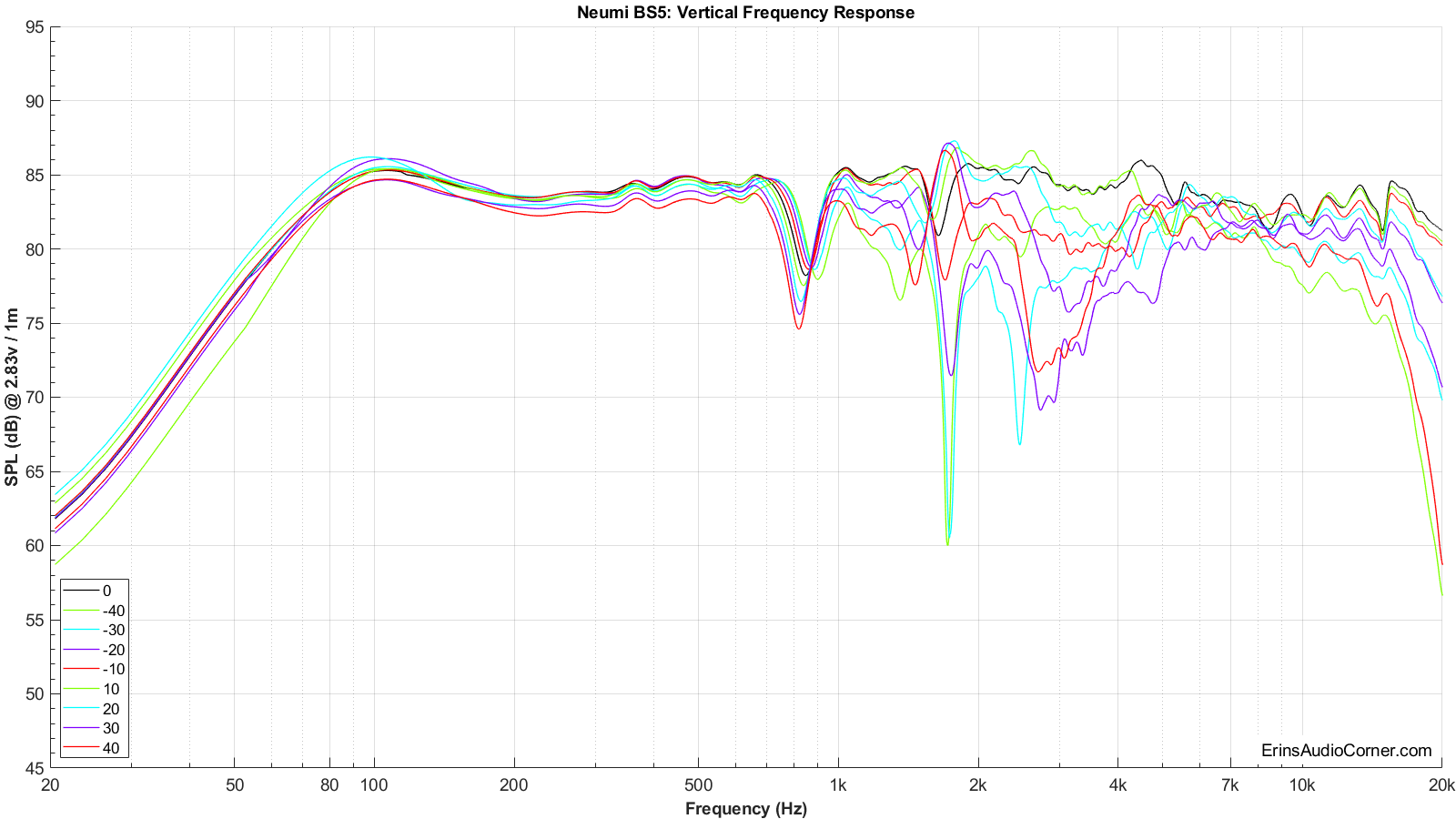
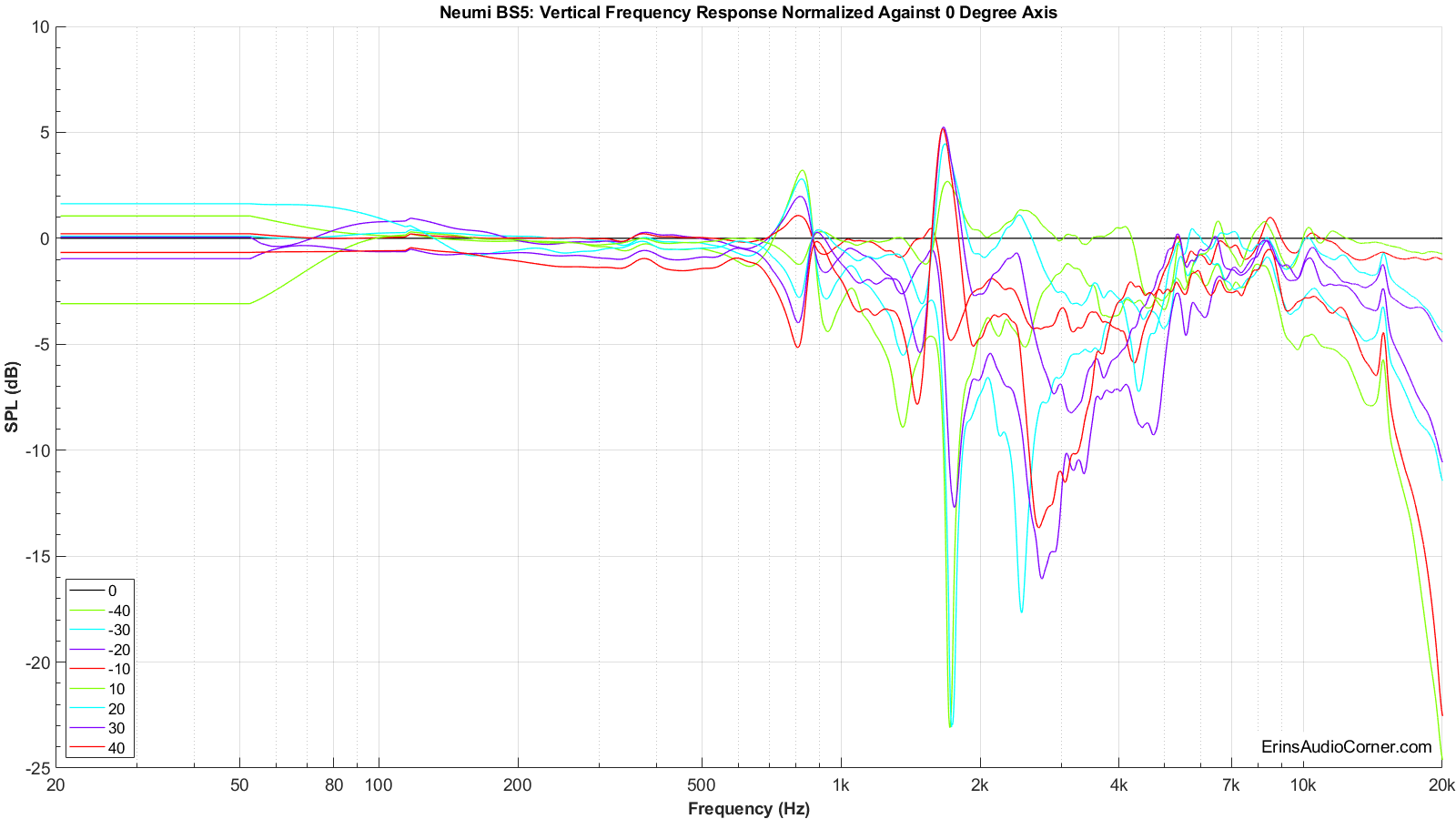
As I said above, the provided frequency response graphs were given with a limited set of data. I measured the response of the speaker’s vertical and horizontal axis in 10-degree steps over 360-degrees. Nearly 70 measurements in total are represented in my data. As you can imagine, providing all those data points in a single FR-type graphic below is a bit overwhelming and confusing for the viewer. A spectrogram is an alternate way to view this full set of data. This takes a 360-degree set of data and “collapses” it down to a rectangular representation of the various angles’ SPL. I have provided two sets of data: one set for horizontal and one for vertical. Each set consists of 3 graphics:
- Full response (20Hz - 20kHz with the angles from 0° to ±180°) with absolute SPL values
- Full, “normalized” response (20Hz - 20kHz with the angles from 0° to ±180°) with SPL values relative to the 0-degree axis
- Normalized, “zoomed” response (200Hz - 20kHz with the angles from 0° to ±90°) with SPL values relative to the 0-degree axis
Normalized plots make it easier to compare how the speaker’s off-axis response behaves relative to the on-axis response curve.
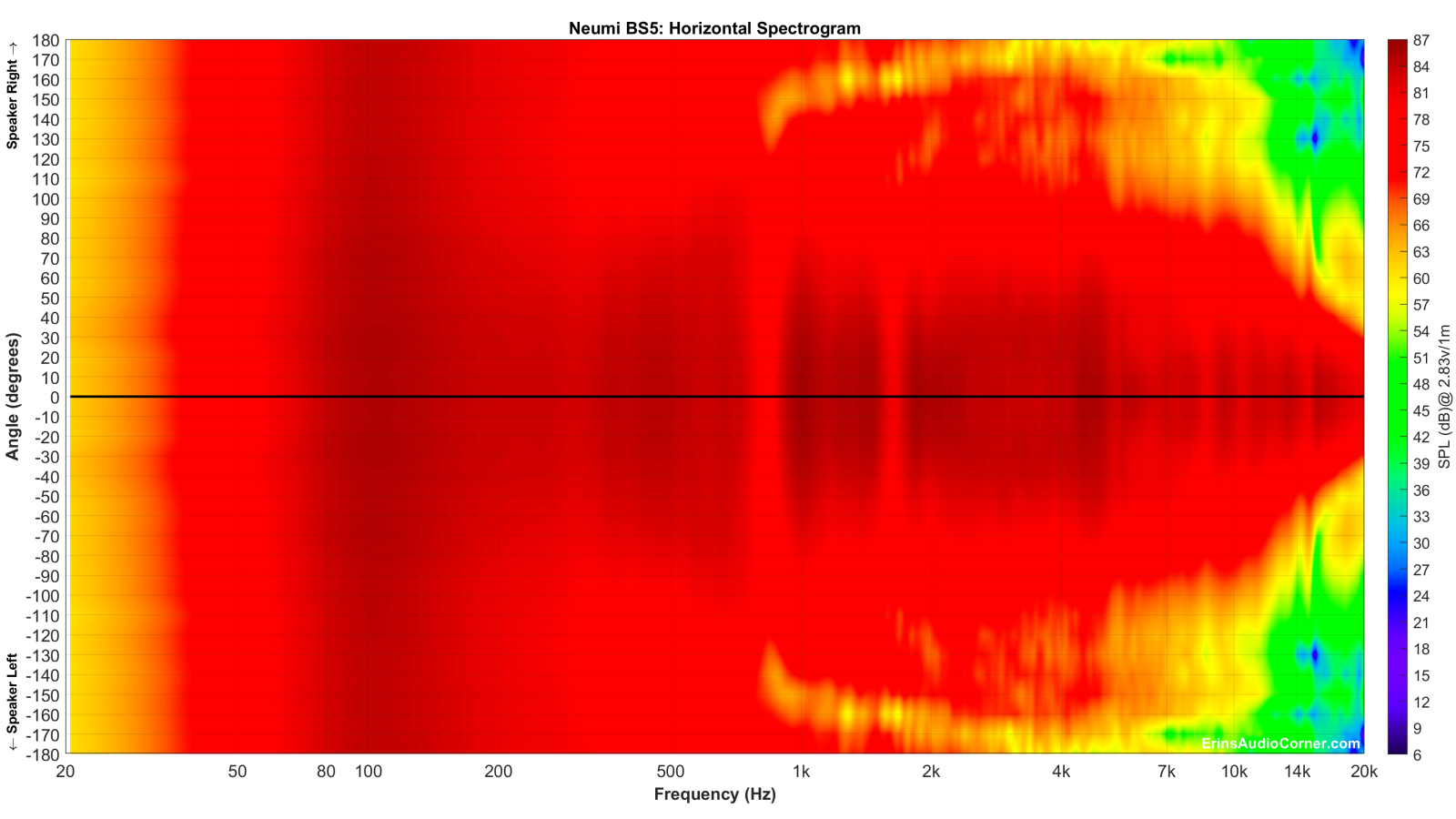
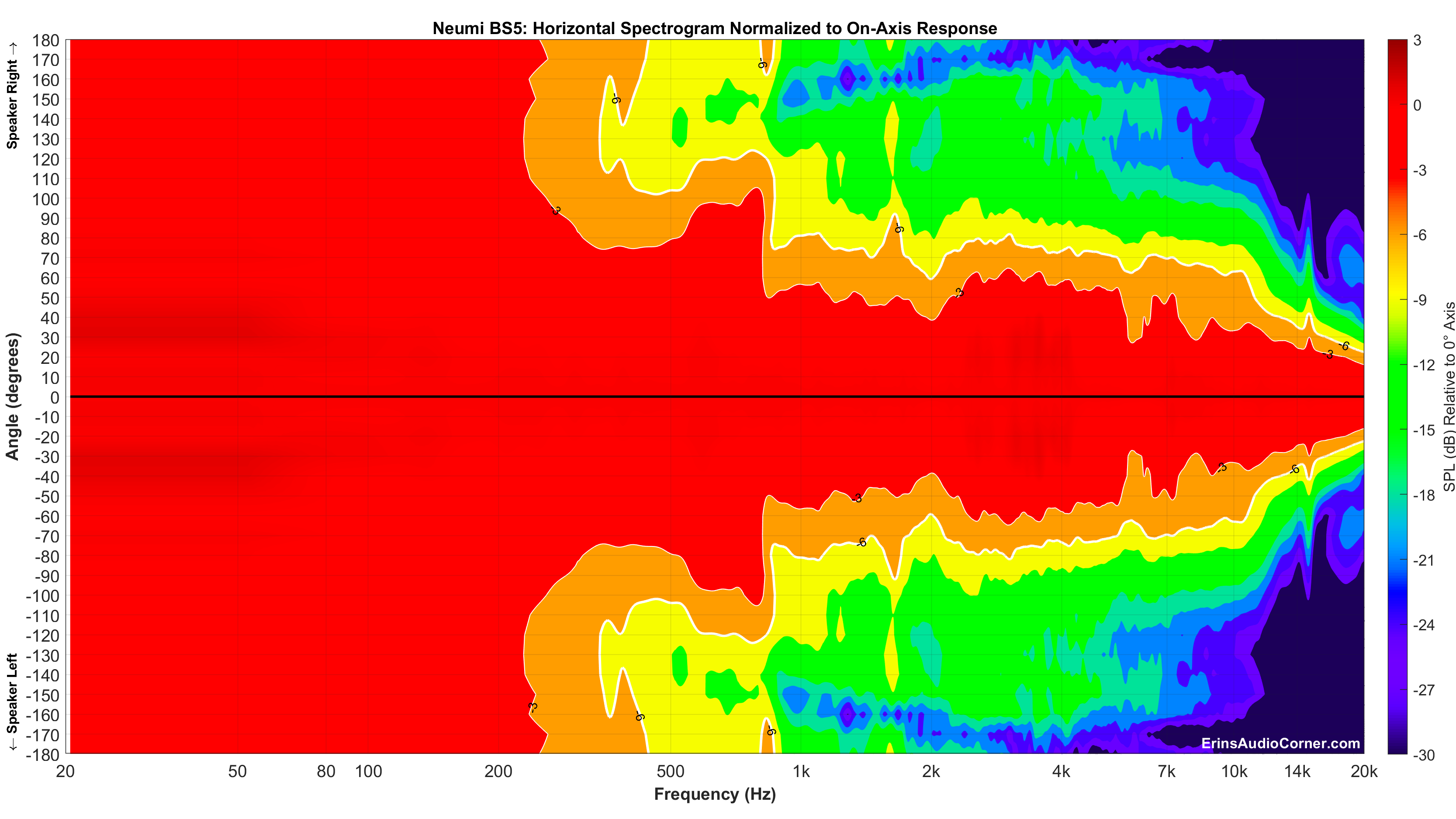
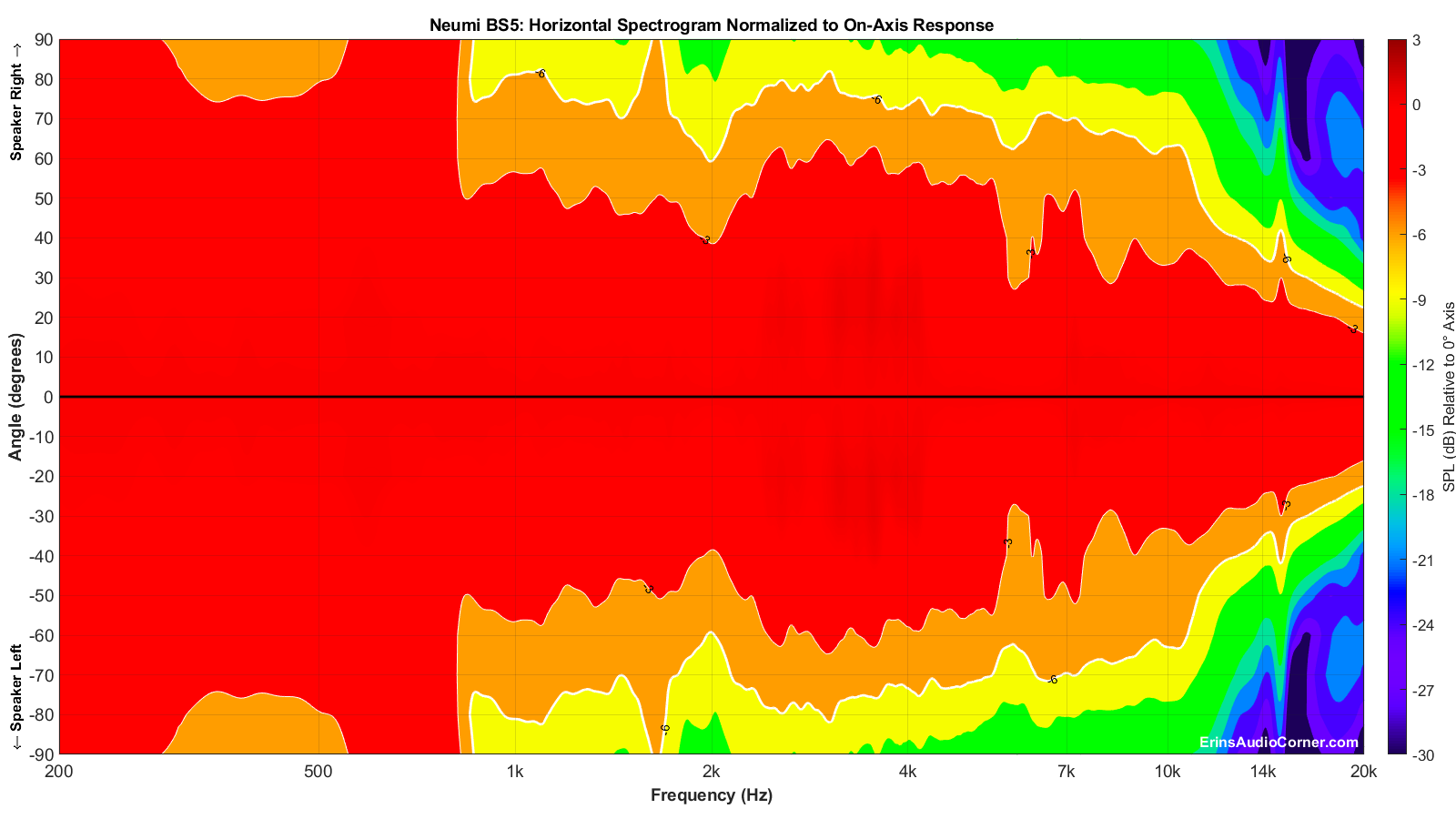
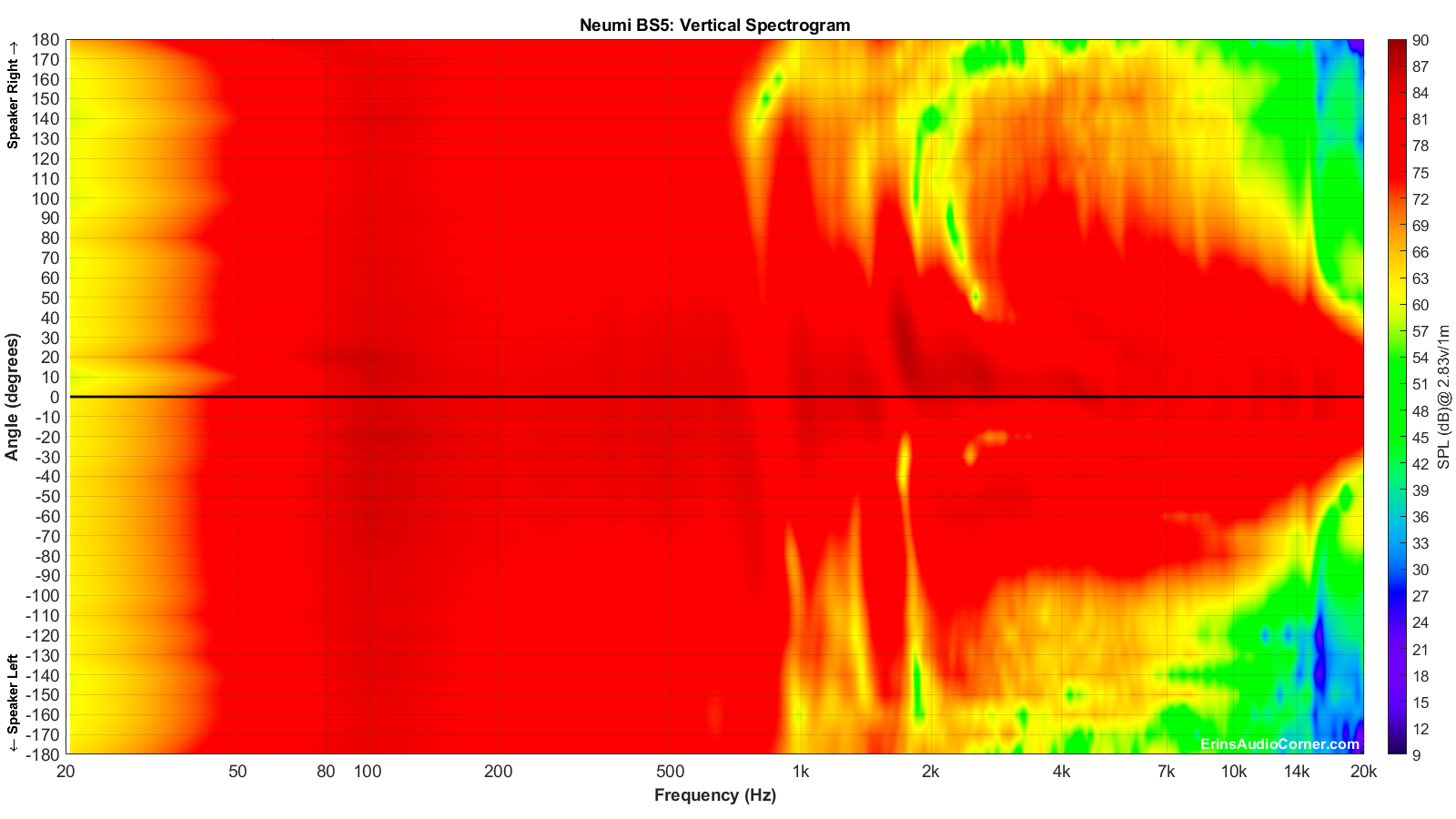
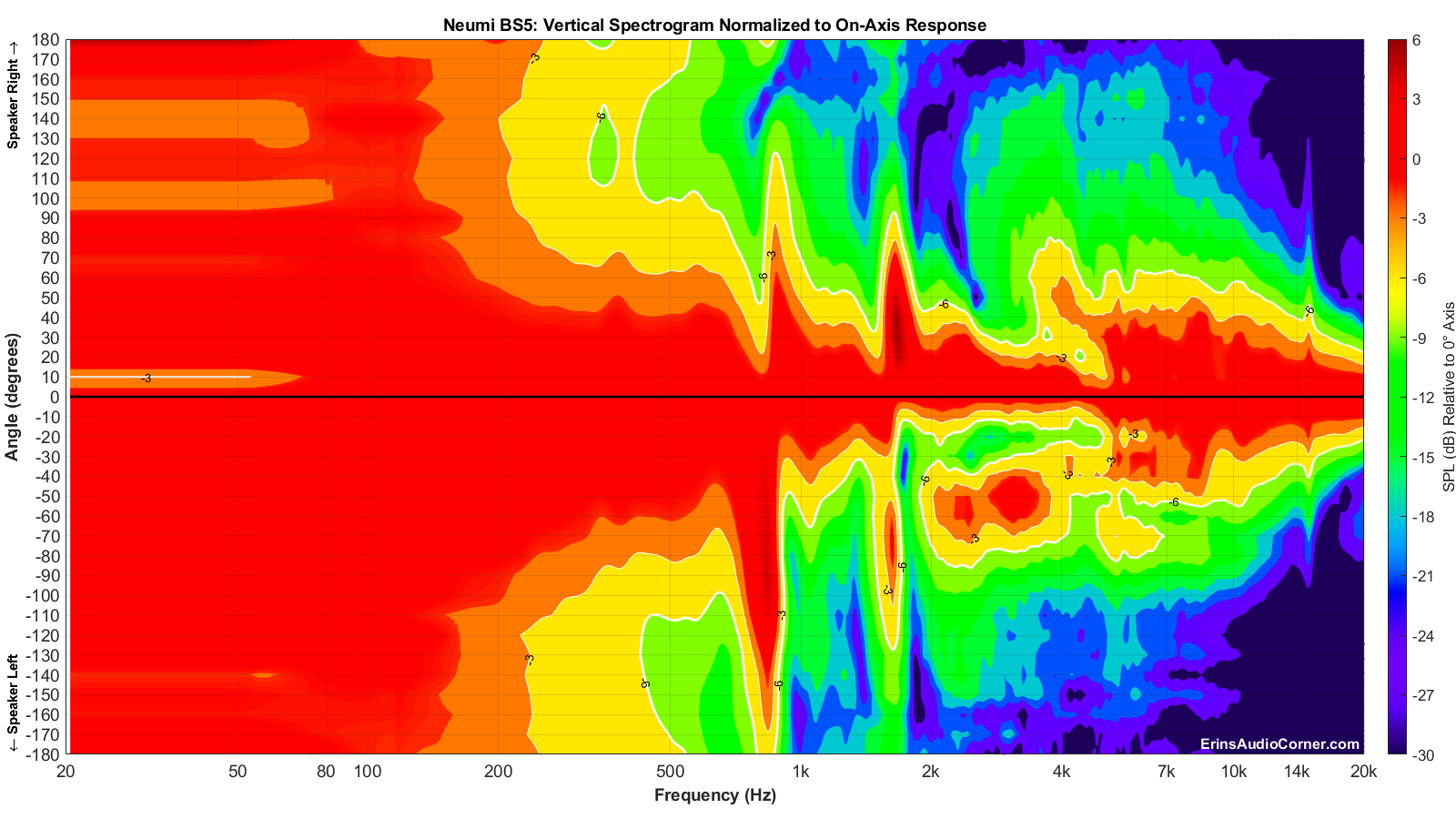
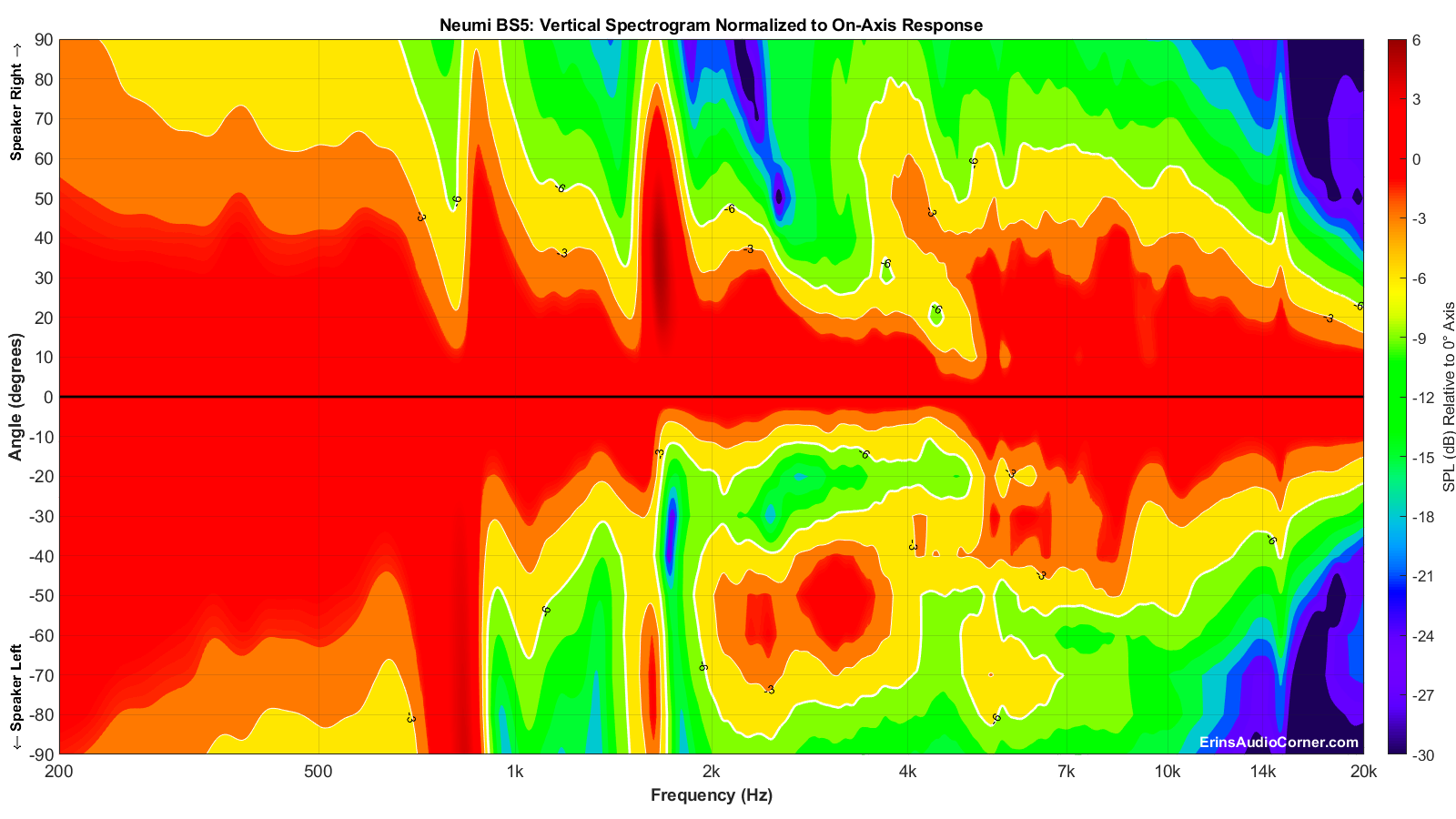
The above spectrograms are the standard way of providing directivity graphics by most reviewers. Some prefer not to normalize the data. Some prefer to normalize the data. Either way, it’s a useful visual to get an idea of the directivity characteristics of a speaker or driver.
However, these “collapsed” representations of the sound field are not very intuitively viewed. At least not to me. So, I came up with a different way to view the speaker’s horizontal and vertical sound field by providing it across a 360° range in a globe plot below. I have provided both an absolute SPL version as well as a normalized version of both the horizontal and vertical sound fields.
Note the legend provided in the top left of each image which helps you understand speaker orientation provided in my global plots below.
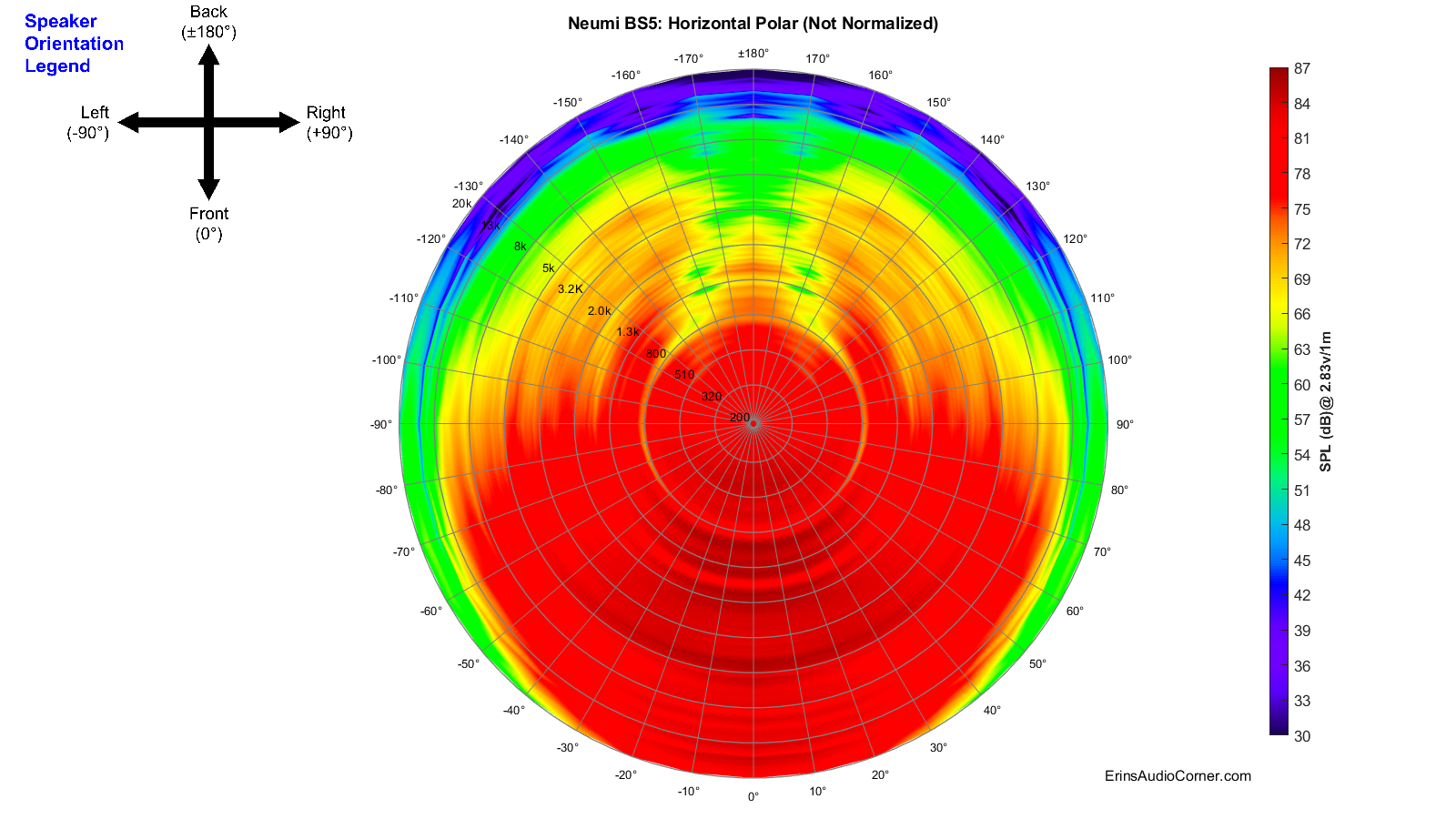
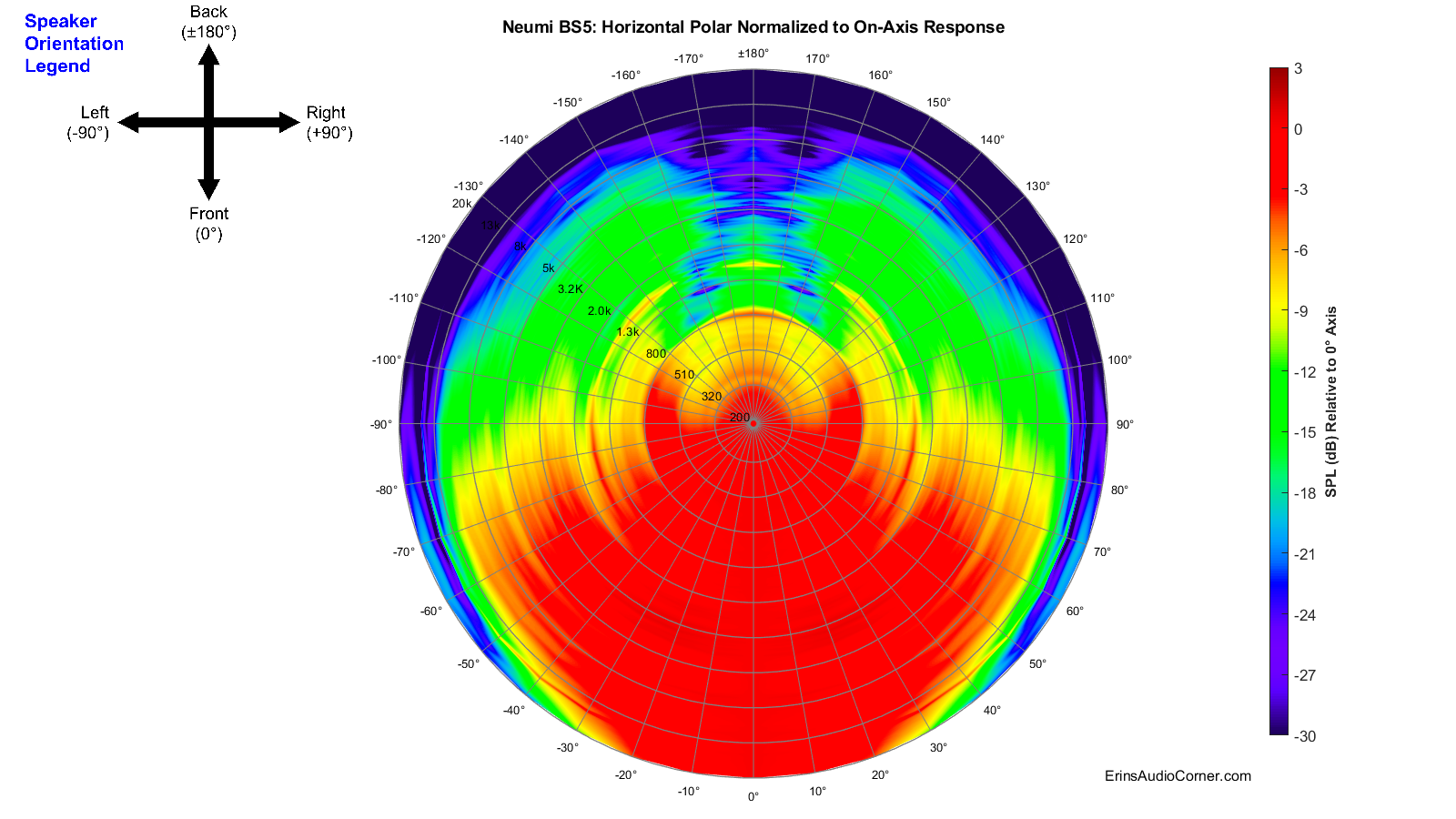
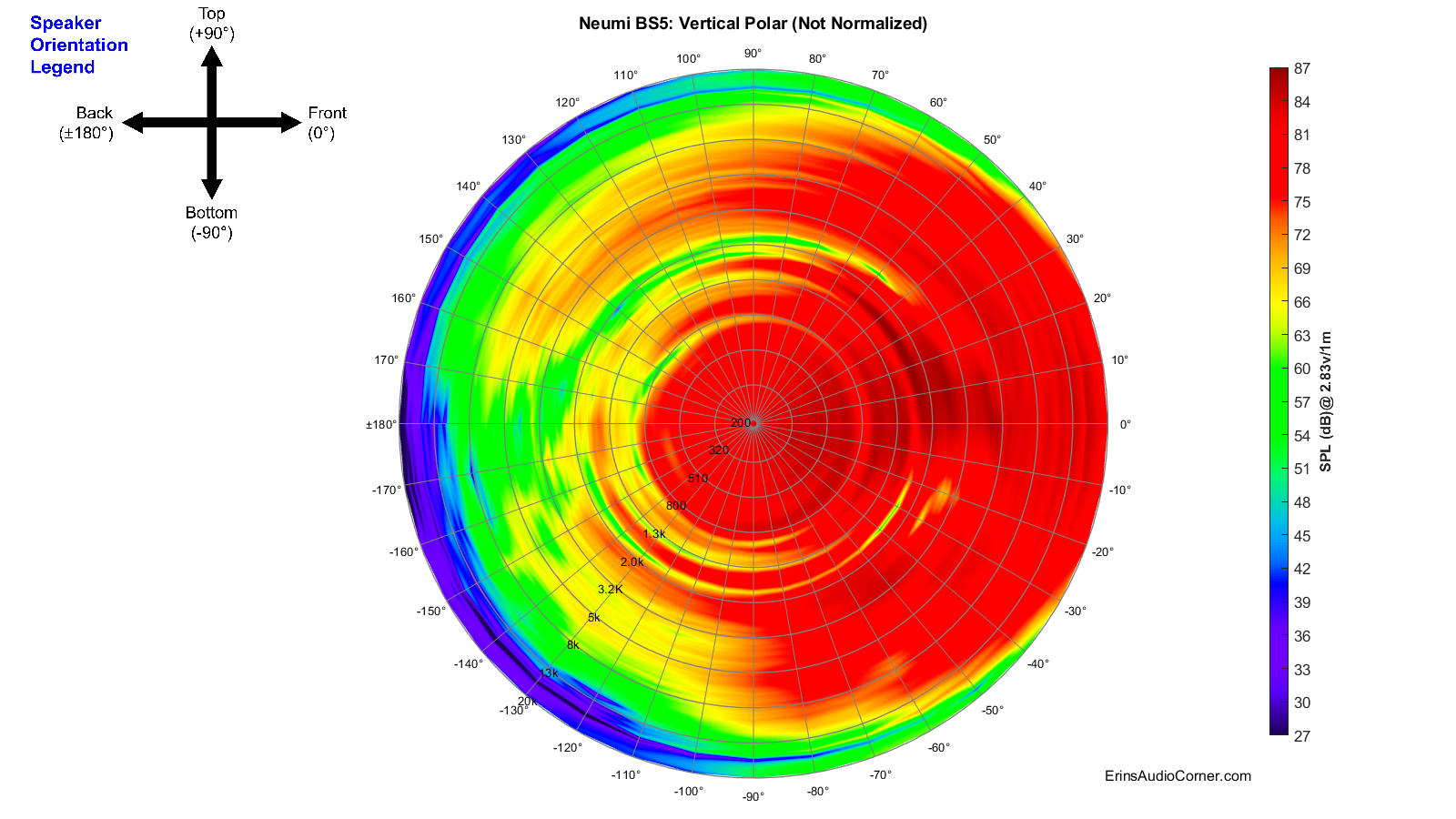
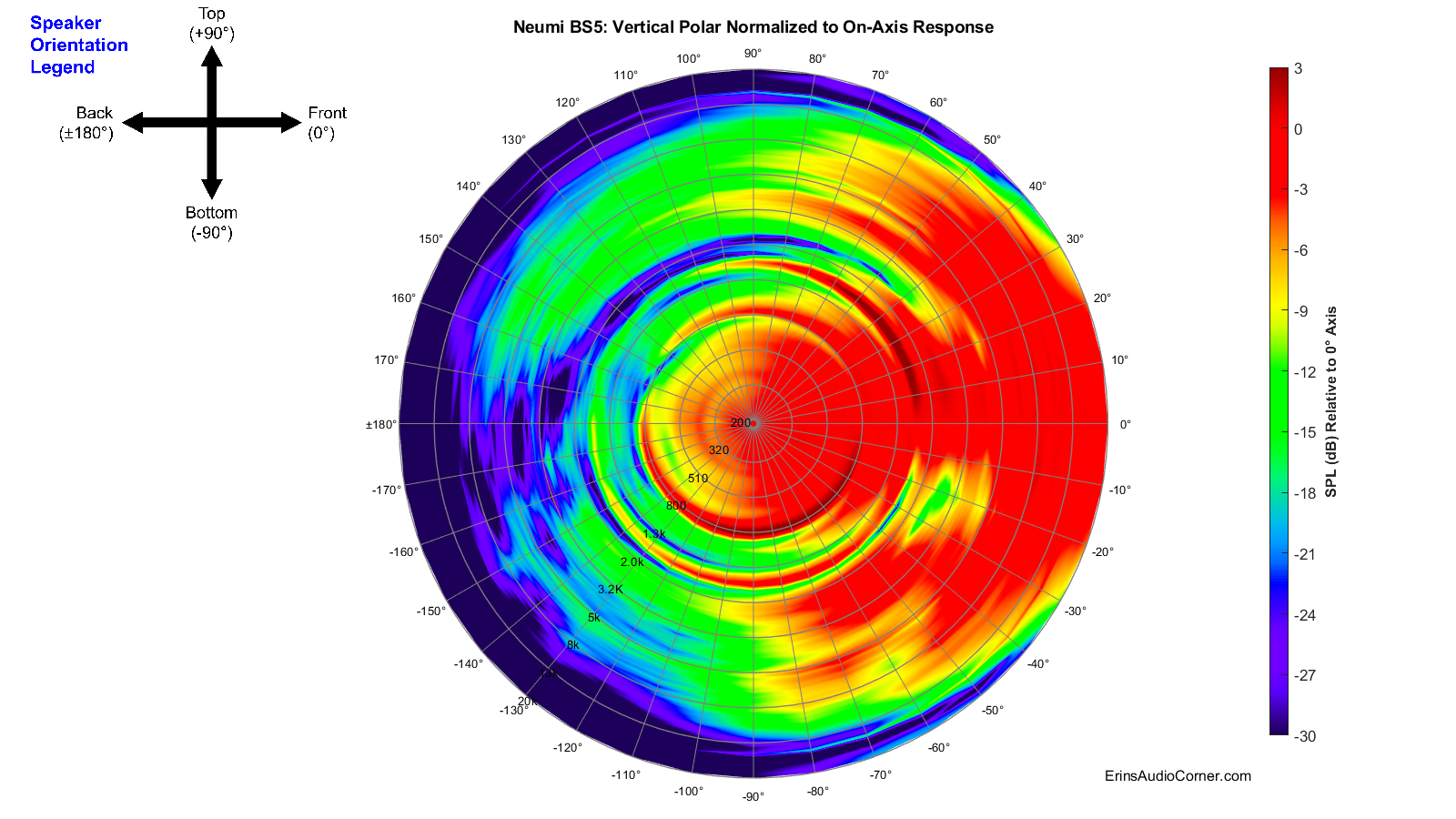
CEA-2034 (aka: Spinorama):
The following set of data is populated via 360-degree, 10° stepped, “spins” from vertical and horizontal planes resulting in 70 unique measurements. Thus, this is sometimes referred to as “Spinorama” data. Audioholics has a great writeup on what these data mean (link here) and there is no sense in me trying to re-invent the wheel so I will reference you to them for further discussion. However, I will explain these curves lightly and provide my own spin on what they mean (pun totally intended). Sausalito Audio also has a good write-up on these curves here. Furthermore, you can find discussion in Dr. Floyd Toole’s book “Sound Reproduction”. Here’s my Amazon affiliate link if you want to purchase it and help me earn about 2% of the price. And, finally, here is a great video of Dr. Toole discussing the use of measurements to quantify in-room performance.
In short, the CEA-2034 graphic below takes all the response measurements (horizontal and vertical) and applies weighting and averaging to sub-sets and can help provide an (accurate) prediction of the response in a typical room. If there is a single set of data to use in your purchase decision, this is probably it.
Alternatively, click this arrow, if you want my quick take on what these curves mean without going to another site.
- On-Axis is simply the on-axis response. This is the 0-degree response curve.
- Listening Window is an average of the 0° to ±30° horizontal and 0° to ±10° vertical response curves and is used to understand what listeners typically hear in a home at the sweet spot, or Main Listening Position (MLP). The reason for this extended window of sound is simply because your room makeup might differ from another’s. This curve is an attempt to quantify a speaker’s performance over a smaller window that is often the norm for listening angle differences in various homes. It is important for this curve to very closely mimic the on-axis response. Deviations of the Listening Window curve relative to the on-axis response curve indicates a compromise in the speaker; often caused by directivity changes (as a speaker transitions from one drive-unit to another a la midwoofer to tweeter, or as a tweeter’s response becomes highly directional).
- Early Reflections is very useful because it helps us determine how the room’s influence will alter (corrupt, most of the time) the direct (on-axis) response. Ideally, the speaker radiates sound uniformly with no aberrations; no resonance, no directivity changes as the speaker transitions from the mid to the tweeter and so on. Because speakers often have these issues, however, what is reflected to us from the walls, ceiling and floor is not the same as what we hear from the on-axis, direct sound. And that’s a problem. Why is that a problem? As stated in Dr. Toole’s book “these are very influential in establishing timbral and spatial qualities”. Large deviations in this relative to the on-axis response also indicate areas where the room is of consequence. Also, it is important to understand the Early Reflections response is made up of rear-firing sounds. A speaker drive-unit is omnidirectional (radiating in all angles evenly) until the half-wavelength equals that of the drive-unit diameter. When the diameter is larger than the wavelength being played, the sound transitions from omnidirectional to directional; also known as “beaming”. Even tweeters beam. For example, a 1-inch dome tweeter will beam at approximately 6750Hz (speed of sound ÷ 2 ÷ diameter). In most speakers you have a single tweeter, firing forward. You can imagine that the high-frequency response in the front of the speaker would therefore be quite different than what is measured behind the speaker. So, being that the Early Reflections curve includes rear-hemisphere measurements you can understand that the high-frequency response would slope downward vs the on-axis response. This is understood and accepted.
- Predicted In-Room Response curve has the benefit of showing directivity mismatches at the crossover as well as resonances easily by comparing them to the overlaid Target curve (further down).
- Directivity Index (DI) curves are the difference in the Listening Window and the respective Early Reflections or Sound Power curves. My understanding, currently, is the Sound Power and Sound Power DI aren’t quite as useful for typical homes. However, there is emphasis placed on the Early Reflections DI curve. The right Y-Axis provides a value associated with the DI curves. The higher the number, the more directional the speaker. For example: a “0” DI curve - a curve which is completely flat - would be a speaker that is purely omnidirectional; radiating uniformly in all angles vertically and horizontally. A speaker that increases over frequency means that it is radiating in a tighter window as you increase in frequency. This is typical because, as I discussed above, even tweeters beam… and most speakers have a single tweeter facing the front and therefore, the speaker becomes directional at whatever the tweeter’s beaming frequency is. There isn’t necessarily a one-size-fits-all DI curve value. Though, it seems people (myself included) prefer a speaker with a wider soundstage which is found in lower directivity speakers (because more sound is bouncing off the side walls; which confuses the use of side-wall absorption but that’s for a later debate). However, what is important is that the curve, however tall you may prefer it to be, is smooth; almost linear. Dips and peaks mean that something, not good, is going on. But a linear curve indicates excellent transition through crossover regions, no resonance, etc. Since speakers are not perfect, though, linear DI curves are not the norm. Speakers become directional as they increase in frequency, around strong resonances, and as the sound transitions at the crossover from one drive-unit to another and you wind up with areas with peaks and/or dips whether they’re spread through a wide frequency range (low-Q) or very sharp/drastic (high-Q). But when you’re looking at the Early Reflections DI curve, look for this: smooth.
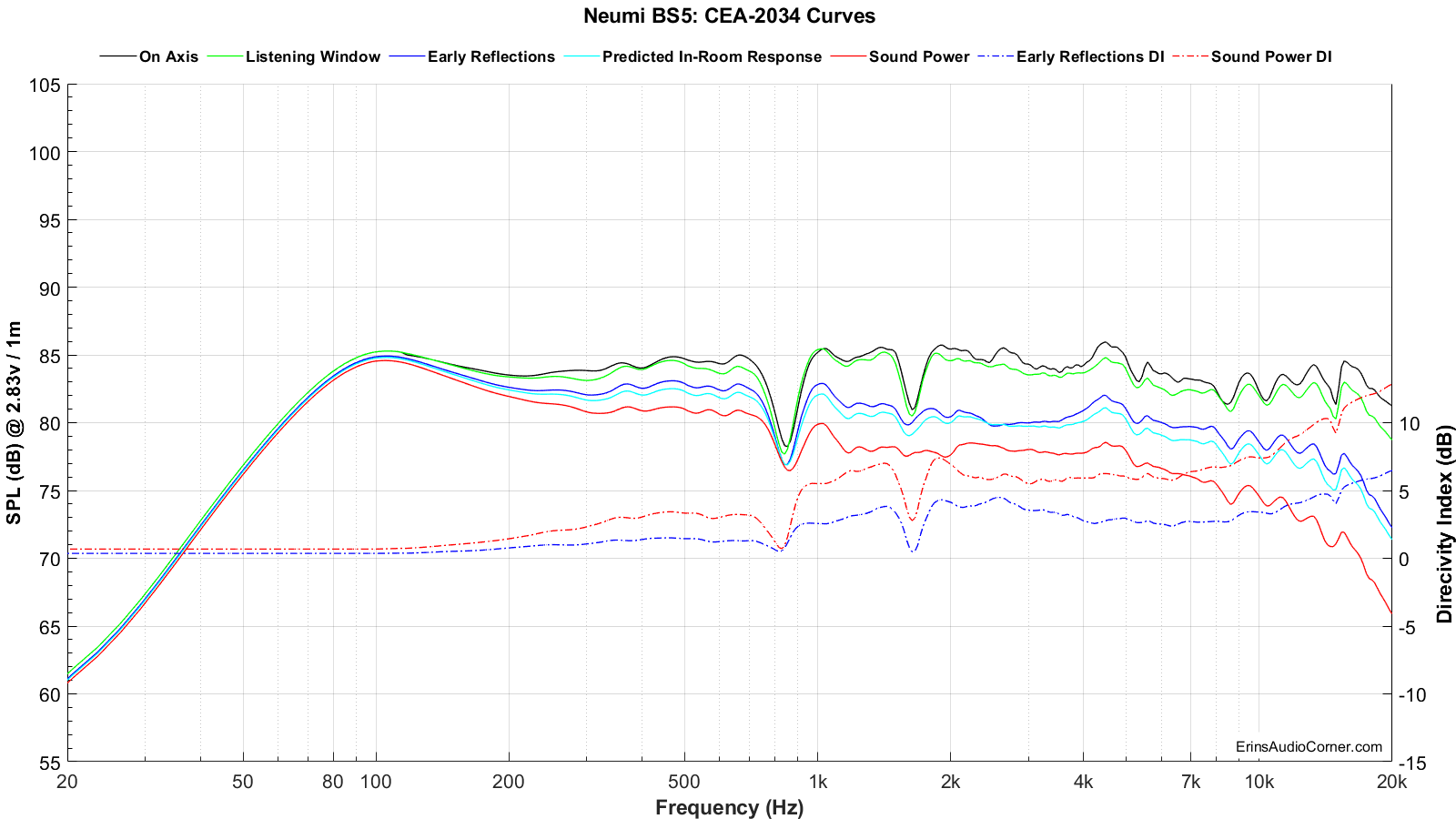
What we can learn from this data is that this speaker has significant directivity problems thanks to the deep nulls at ~800Hz and ~1600Hz. You can see it in the above spectrogram and globe plots as well as in all the measurements in the above graphic. The crossover is stated as 2.1kHz by Neumi and the nearfield data backs this up. Therefore, in this region you can see the directivity mismatch. Looking at 1kHz you see a rising DI until approximately 2.5kHz where the Early Reflections DI dips back down again. This is a sign the transition from mid to tweeter is occurring as the woofer is beginning to beam (radiate more forward than omnidirectional) and the tweeter is taking over, omnidirectional until approximately 6.5kHz (calculated based on dome size of 1 inch). The DI flattens out a bit through here but as the tweeter begins to radiate more directionally the DI increases again above ~7kHz. The tweeter rolls off sharply above 16kHz, causing directivity to increase further. What does this all mean to you? Well, mismatches in what is coming directly at you, on-axis, vs what is reflected around you can cause issues in stage and tonality cues.
Below is a breakout of the typical room’s Early Reflections contributors (floor bounce, ceiling, rear wall, front wall and side wall reflections). From this you can determine how much absorption you need and where to place it to help remedy strong dips from the reflection(s). Notice the strong dips again at 800Hz and 1600Hz.
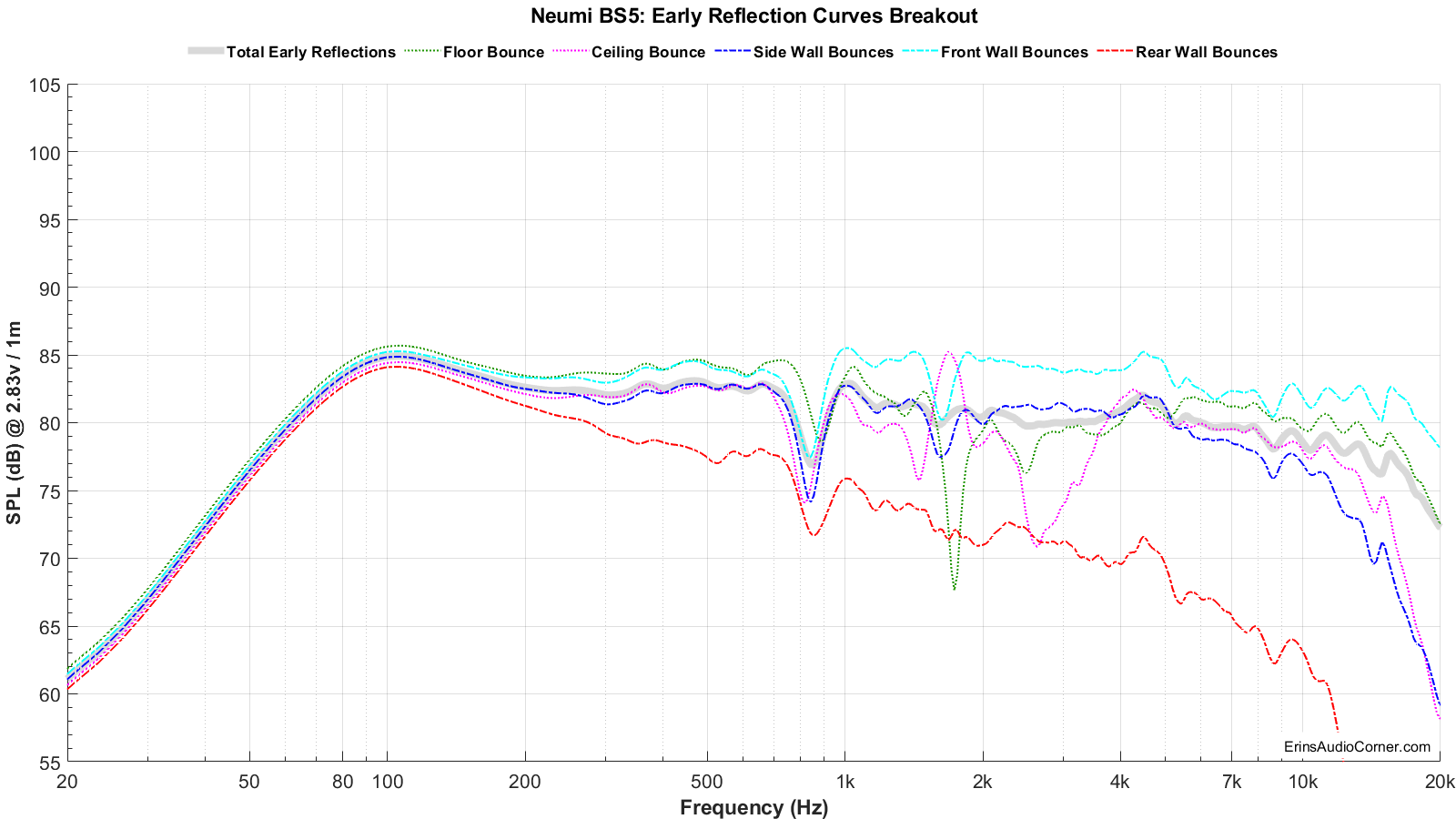
And below is the Predicted In-Room response compared to a general Target curve equaling -1dB/octave.
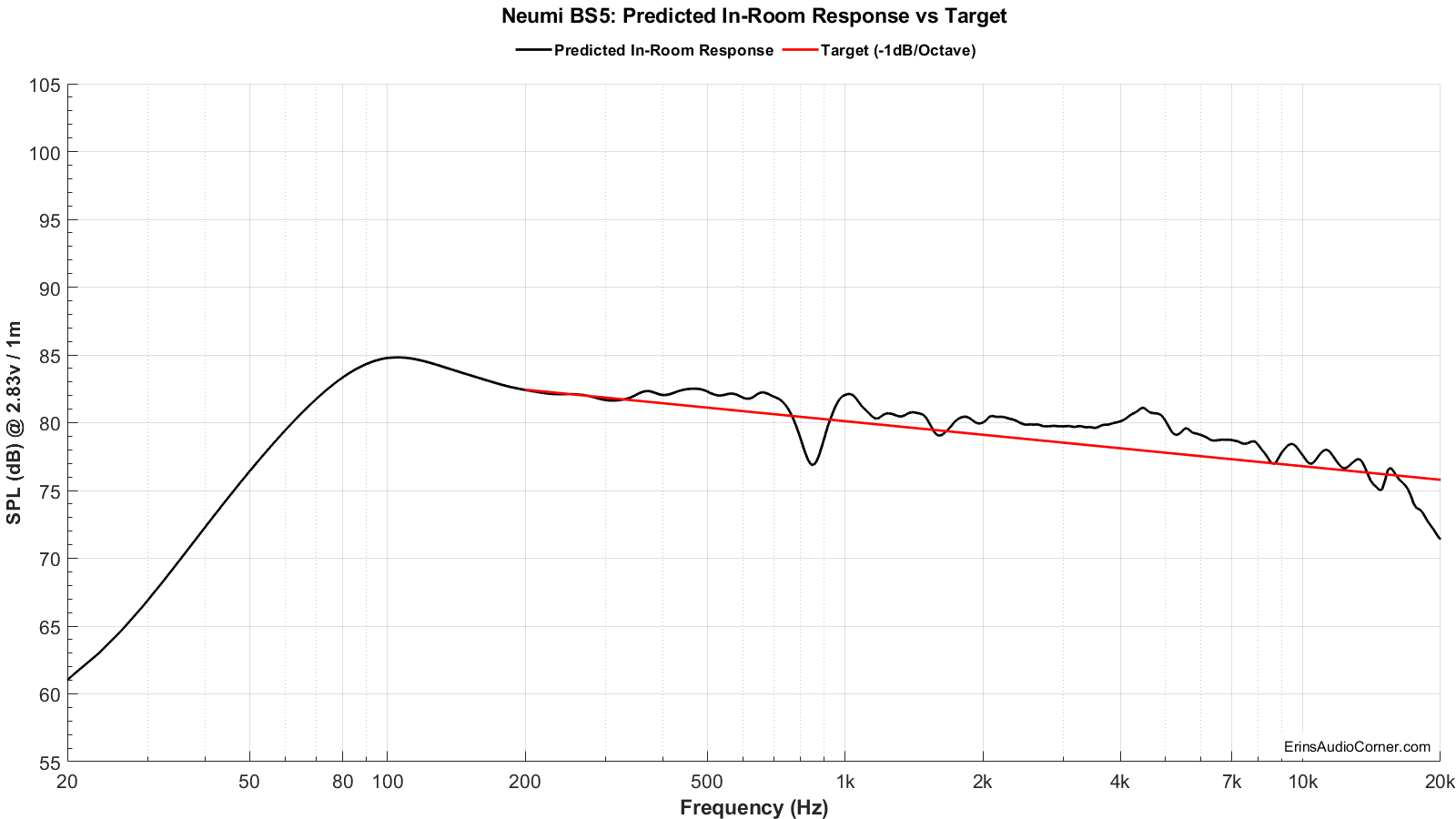
You may ask just how useful the above prediction is. Well, I’d be remiss for not delving in to that a little bit here. Please see my Analysis section below for discussion on this. :)
Total Harmonic Distortion (THD) and Compression:
Distortion and Compression measurements were completed in the nearfield (approximately 0.3 meters). However, SPL provided is relative to 1 meter distance.
Harmonic Distortion and Compression: What does this data mean? (click me for info)
Harmonic Distortion and Compression are provided at varying levels to get an idea of what happens as the voltage into the speaker is increased and overall output volume increases. The “mean spl” values associated with each voltage provided in the legend is based on a calculation of expected volume assuming linear volume at the 300-3kHz region. Meaning, if a speaker is ideal and you tell your stereo to increase by 6dB by turning the volume knob +6dB, the output will increase by 6dB. In the real-world, however, a speaker is a mechanical device and there are compression effects that can limit the output volume and, therefore, you could possibly only get an actual increase in volume of 5dB. A good speaker will have little compression (< 1dB), where poorer speakers may suffer greater compression (> 2dB). Generally speaking, higher sensitivity speakers (like pro-audio speakers with 100dBSPL @ 2.83v/1m spec) suffer relatively no compression while lower sensitivity speakers (low 80’s dBSPL @ 2.83v/1m) suffer more compression. When a crossover is used the compression near the speaker’s Fs is attenuated and overall the compression effects are mitigated. With that in mind, what you see below is first the Total Harmonic Distortion at varying output levels.
What you see below is first the Total Harmonic Distortion at varying output levels. At 2.83vRMS the mean SPL is about 84dB at 1 meter (over 300-3kHz). Distortion at this output is under mostly under 1% which isn’t good for such a relatively low volume level. As you’d expect, the distortion increases as volume increases.
However, based on a poll I conducted, most people’s in-room listening distance is between 3 to 4 meters from their speakers at a volume of about 85dB to 90dB. Few people realize just how loud 90dB is. I’ve often found people tend to overestimate their listening levels by a fair bit. But, for the sake of determining how these speakers perform at the higher end of music listening, let’s assume the following: 1) you are in your room and about 4 meters (~ 13 feet) from the speakers and 2) you listen to these speakers at about 90dB at the listening position. The pair of speakers causes a 3dB increase, the room typically adds 6dB, but the change in distance from 1 meter to 4 meters results in a 12dB drop. This equals a total of +3dB from single speaker anechoic 1 meter response to in-room speaker pair at 4 meters. Therefore, in this scenario, you will need to look at the 93dB (7.62vRMS) measurements for THD and Compression.
Using the 93dB measurement tells you the measured low-frequency distortion at about 80Hz is near 3% THD and 6% at 40Hz. Will you hear that? Pure distortion is more subjective and depends not just on the listener but also no the program material.
I typically use distortion to tell me where mechanical failures are because the distortion I hear is typically either a rattle, buzz, plop from a woofer extending too far, or something along those lines. The bass is usually the problem. But in this speaker the midrange exhibits distortion at higher output levels and was also audible in my listening (primarily with male vocals).
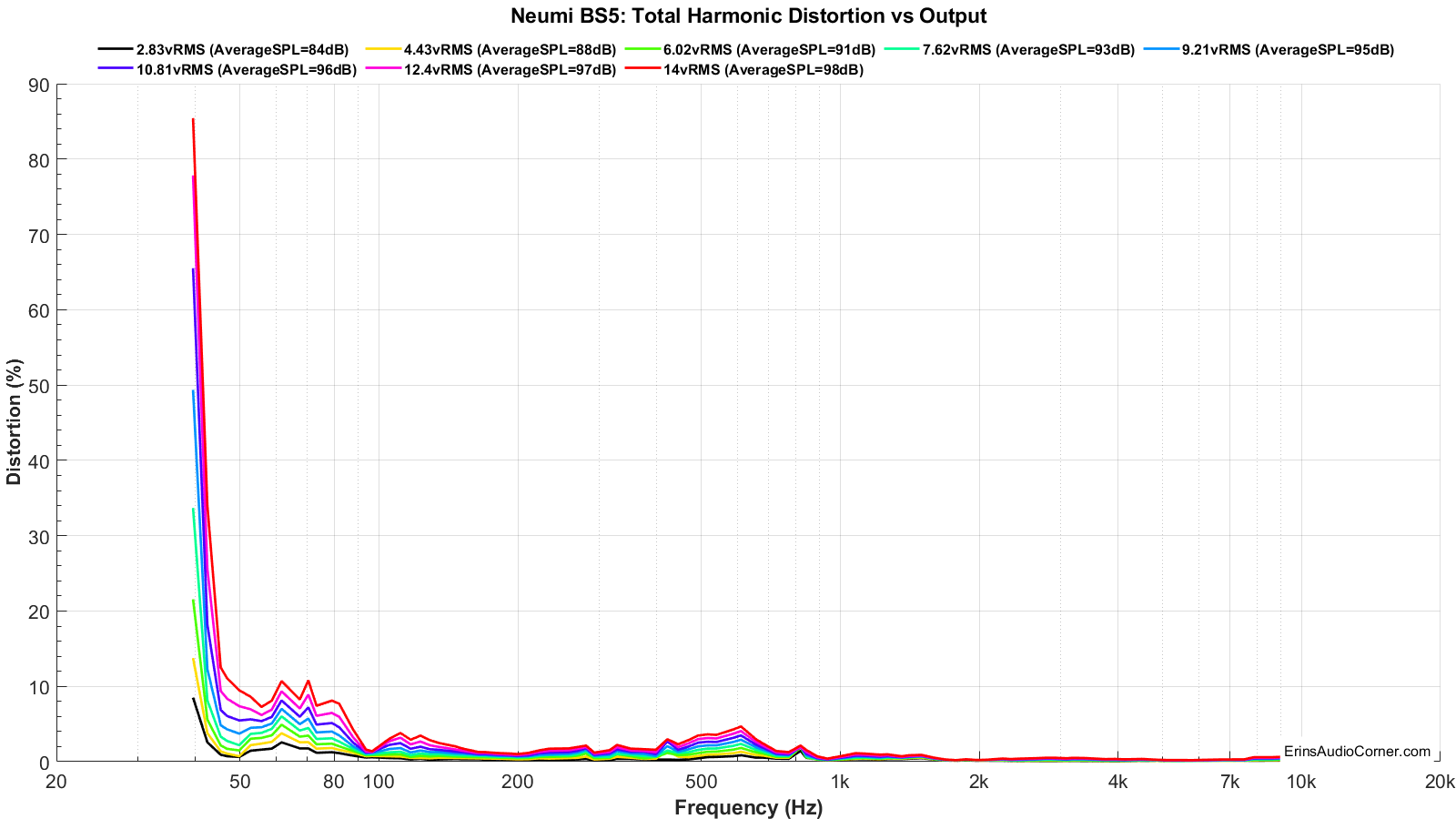
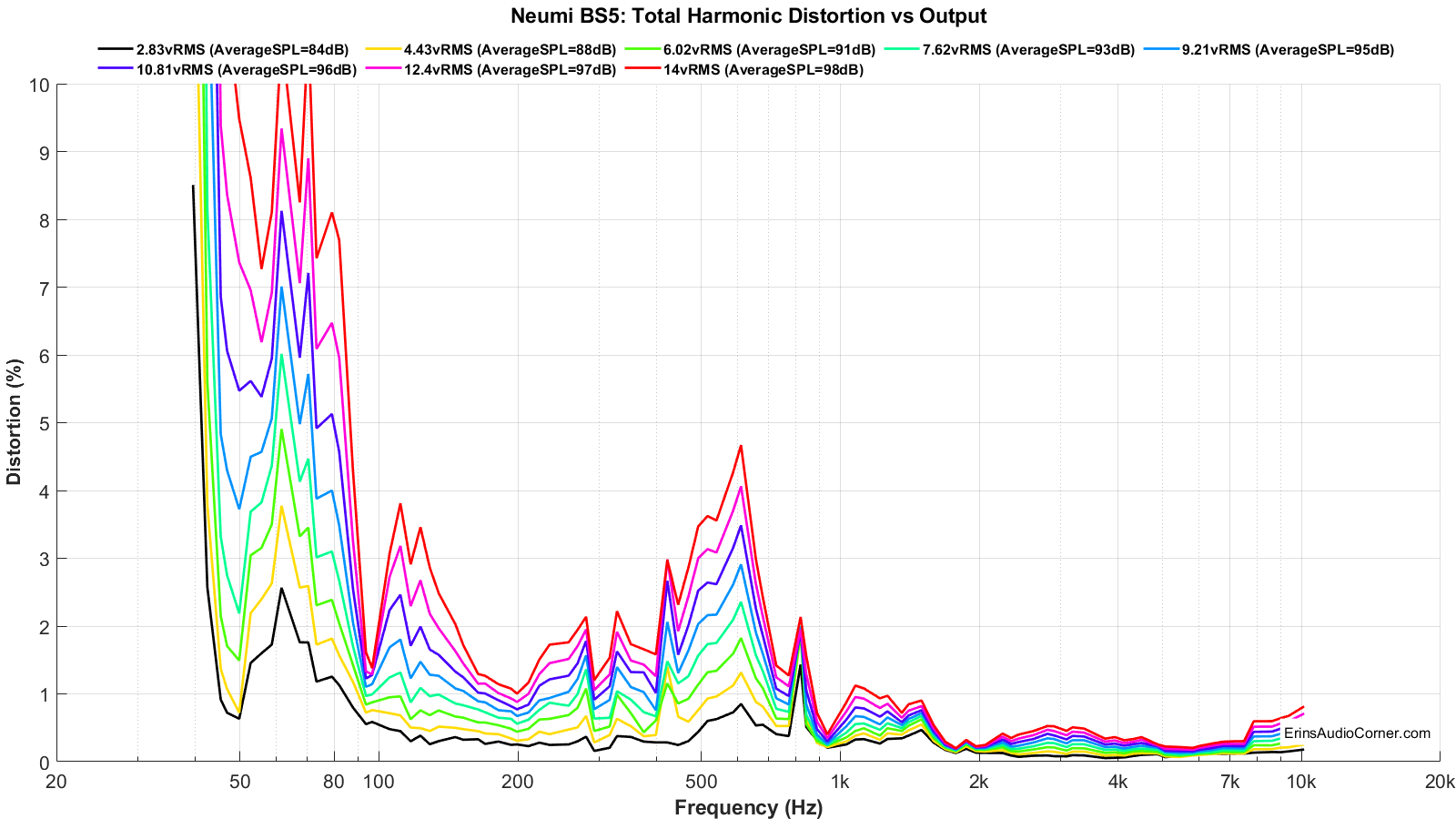
Compression always sounds like a bag of yuck… It’s hard to describe it… but it just sounds very strained and as you increase the volume you get nothing in return of output. Hopefully with the data I provide you can get a clearer understanding of what this means.
The compression effects shown in the image below are a visual way of seeing just what happens as the volume is increased. This one is straight-forward. Take the legend’s SPL value and add or subtract the data from the graphic. This tells you if you’re losing or gaining output (yes, you can gain output from compression; as un-intuitive as that seems). Mostly, the compression results in a loss due to temperature increase in the voice coil of the drive unit. Let’s look at a specific example. Take the 90dB at 4 meters target listening volume provided above. Again, you need 93dB’s (7.62vRMS) data. At that volume, the highest amount of compression measured is about 1dB at 40Hz and about 0.25dB at 50Hz, decreasing until about 200Hz. At some points the speaker suffered >2dB compression at 40Hz with 14vRMS. Overall, the compression results tell you what common sense would tell you: don’t try to use this speaker in place of a subwoofer at anything other than lower volumes. Otherwise, at louder listening volumes you lose over 1dB of output. And it is audibly present as a very grainy and “limited” sound; there are no dynamics at this output and that’s exactly what I heard in my listening tests when I pushed the speaker to uncomfortable levels.
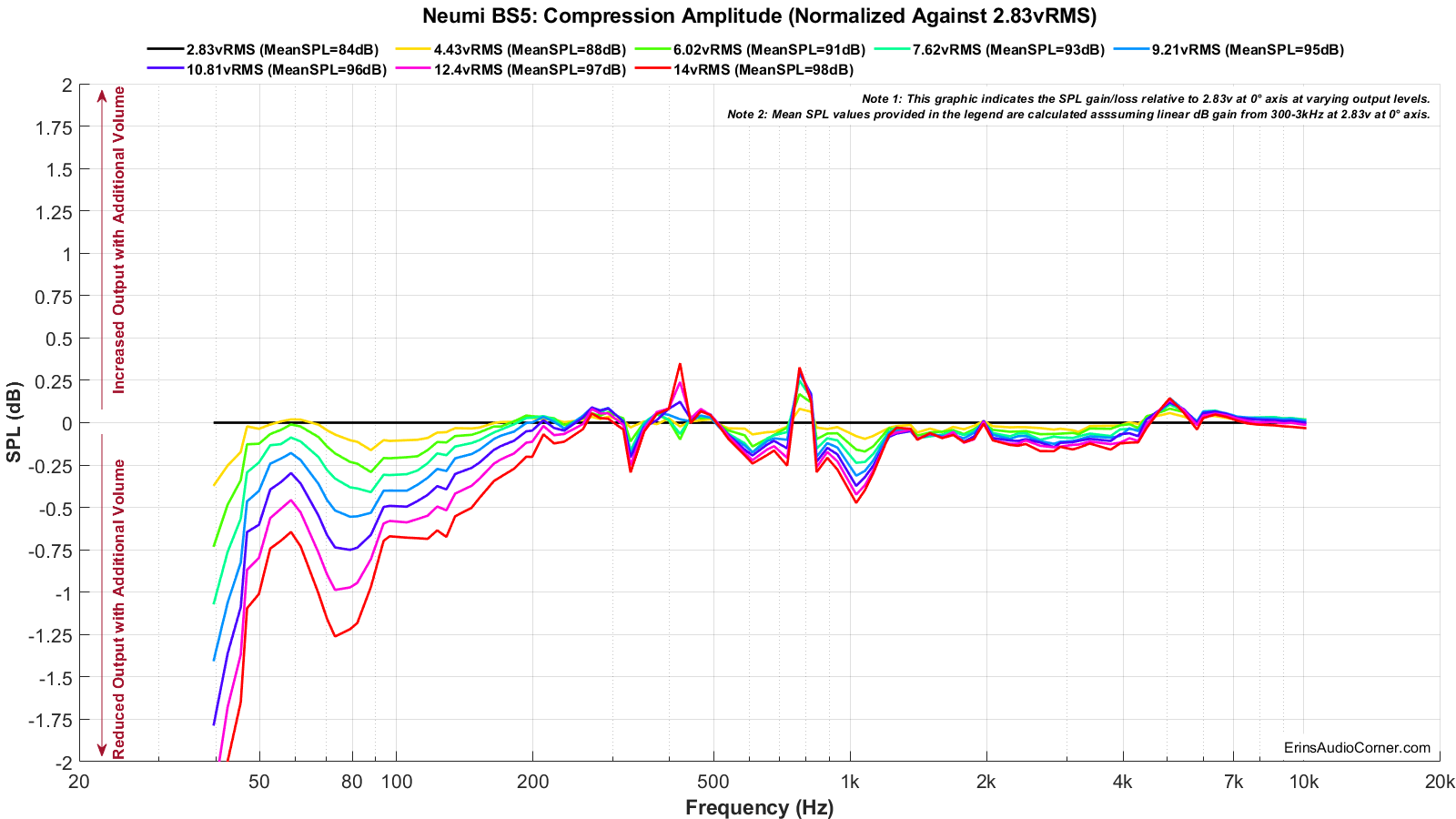
Maximum Long Term SPL:
The below data provides the metrics for how Maximum Long Term SPL is determined. This measurement follows the IEC 60268-21 Long Term SPL protocol, per Klippel’s template, as such:
- Rated maximum sound pressure according IEC 60268-21 §18.4
- Using broadband multi-tone stimulus according §8.4
- Stimulus time = 60 s Excitation time + Preloops according §18.4.1
Each voltage test is 1 minute long (hence, the “Long Term” nomenclature).
The thresholds to determine the maximum SPL are:
- -20dB Distortion relative to the fundamental
- -3dB compression relative to the reference (1V) measurement
When the speaker has reached either or both of the above thresholds, the test is terminated and the SPL of the last test is the maximum SPL. In the below results I provide the summarized table as well as the data showing how/why this SPL was deemed to be the maximum.
This measurement is conducted twice:
- First with a 20Hz to 20kHz multitone signal
- Second with a limited 80Hz to 20kHz signal
The reason for the two measurements is because it is unfair to expect a small bookshelf speaker to extend low in frequency. Applying both will provide a good idea of the limitations if you were to want to run a speaker full range vs using one with a typical 80Hz HPF. And you will have a way to compare various speakers’ SPL limitations with each other. However, note: the 80Hz signal is a “brick wall” and does not emulate a typical 80Hz HPF slope of 24dB/octave. But… it’s close enough.
You can watch a demonstration of this testing via my YouTube channel: https://youtu.be/iCjJufvW0IA
Test 1: 20Hz to 20kHz
Table Results:
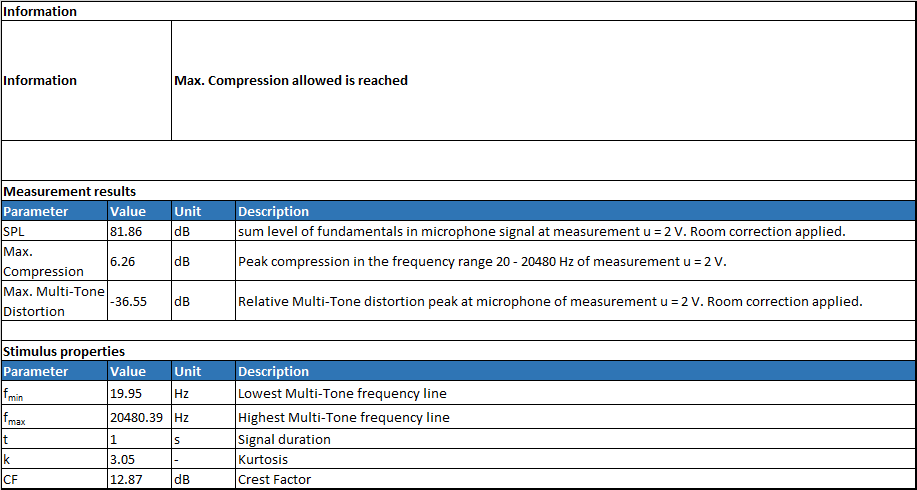
Multitone compression testing. The red line shows the final measurement where either distortion and/or compression failed. The voltage just before this is used to help determine the maximum SPL.
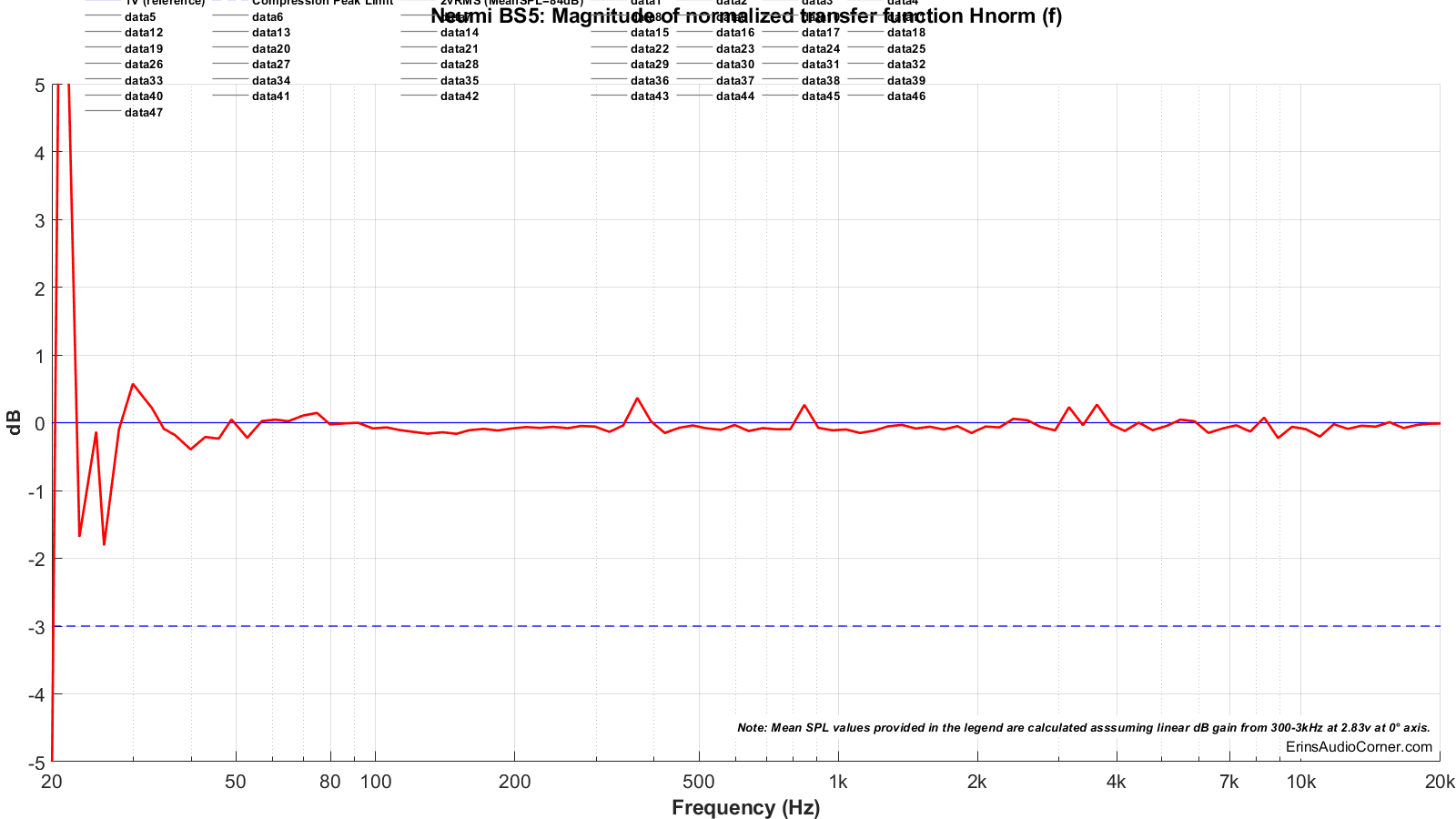
Multitone distortion testing. The dashed blue line represents the -20dB (10% distortion) threshold for failure. The dashed red line is for reference and shows the 1% distortion mark (but has no bearing on pass/fail). The green line shows the final measurement where either distortion and/or compression failed. The voltage just before this is used to help determine the maximum SPL.
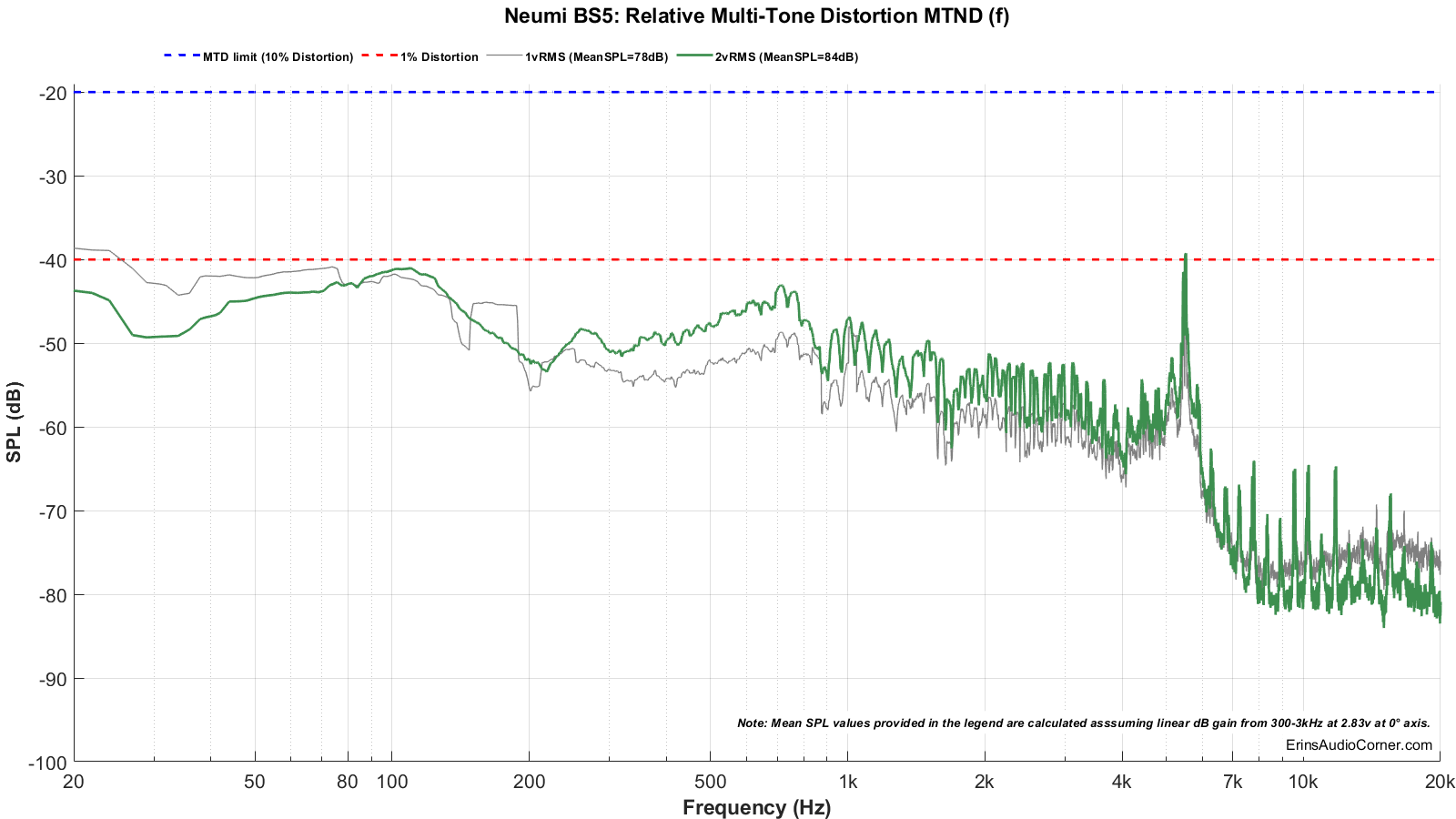
Test 2: 80Hz to 20kHz
Table Results:
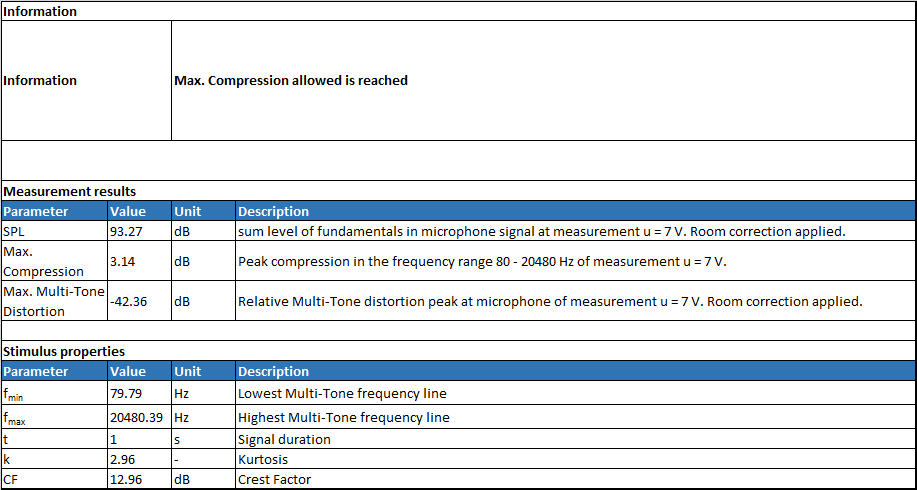
Multitone compression testing. The red line shows the final measurement where either distortion and/or compression failed. The voltage just before this is used to help determine the maximum SPL.
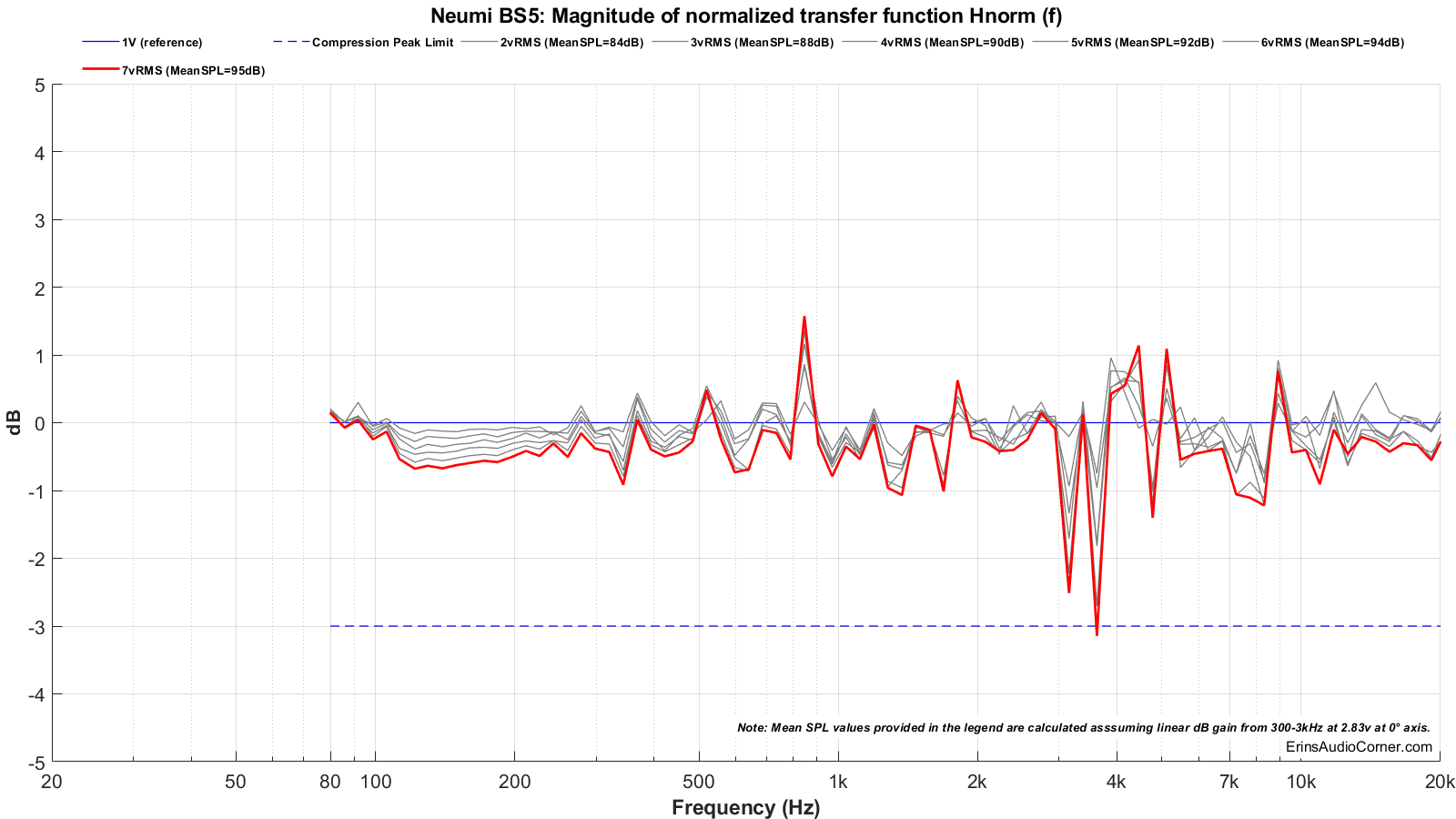
Multitone distortion testing. The dashed blue line represents the -20dB (10% distortion) threshold for failure. The dashed red line is for reference and shows the 1% distortion mark (but has no bearing on pass/fail). The green line shows the final measurement where either distortion and/or compression failed. The voltage just before this is used to help determine the maximum SPL.
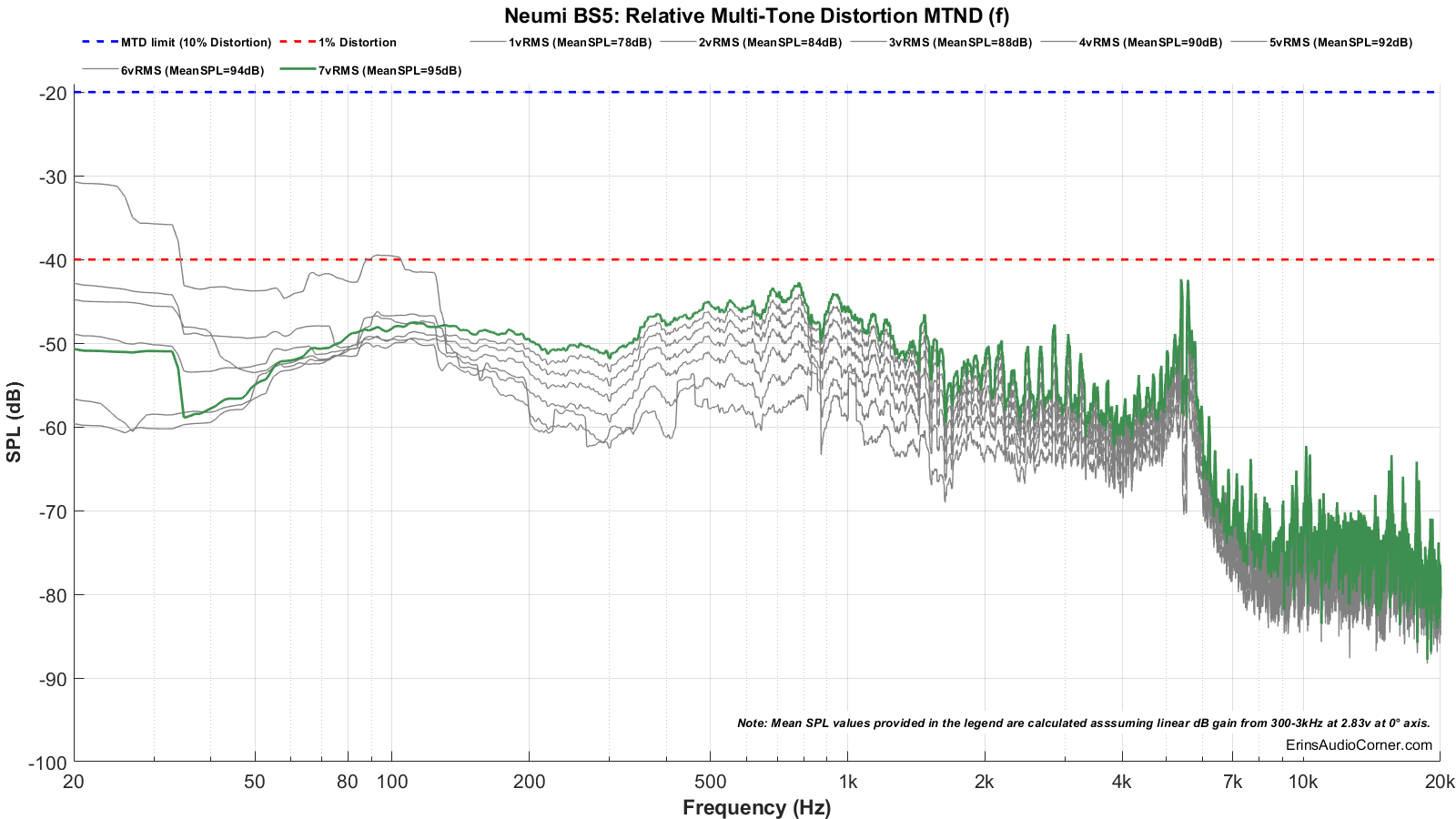
The above data can be summed up by looking at the tables above but is provided here again:
- Max SPL for 20Hz to 20kHz is approximately 82dB @ 1 meter. The compression threshold was exceeded above this SPL.
- Max SPL for 80Hz to 20kHz is approximately 93dB @ 1 meter. The compression threshold was exceeded above this SPL.
Extra Measurements:
These are just some extra sets of measurements I completed. Some, I didn’t process through my MATLAB scripts so they’re kind of raw. But I know some would like to see them so here you go.
On-Axis Response comparison between Speaker A and Speaker B.
This result shows the difference between the two speakers I received as a pair.
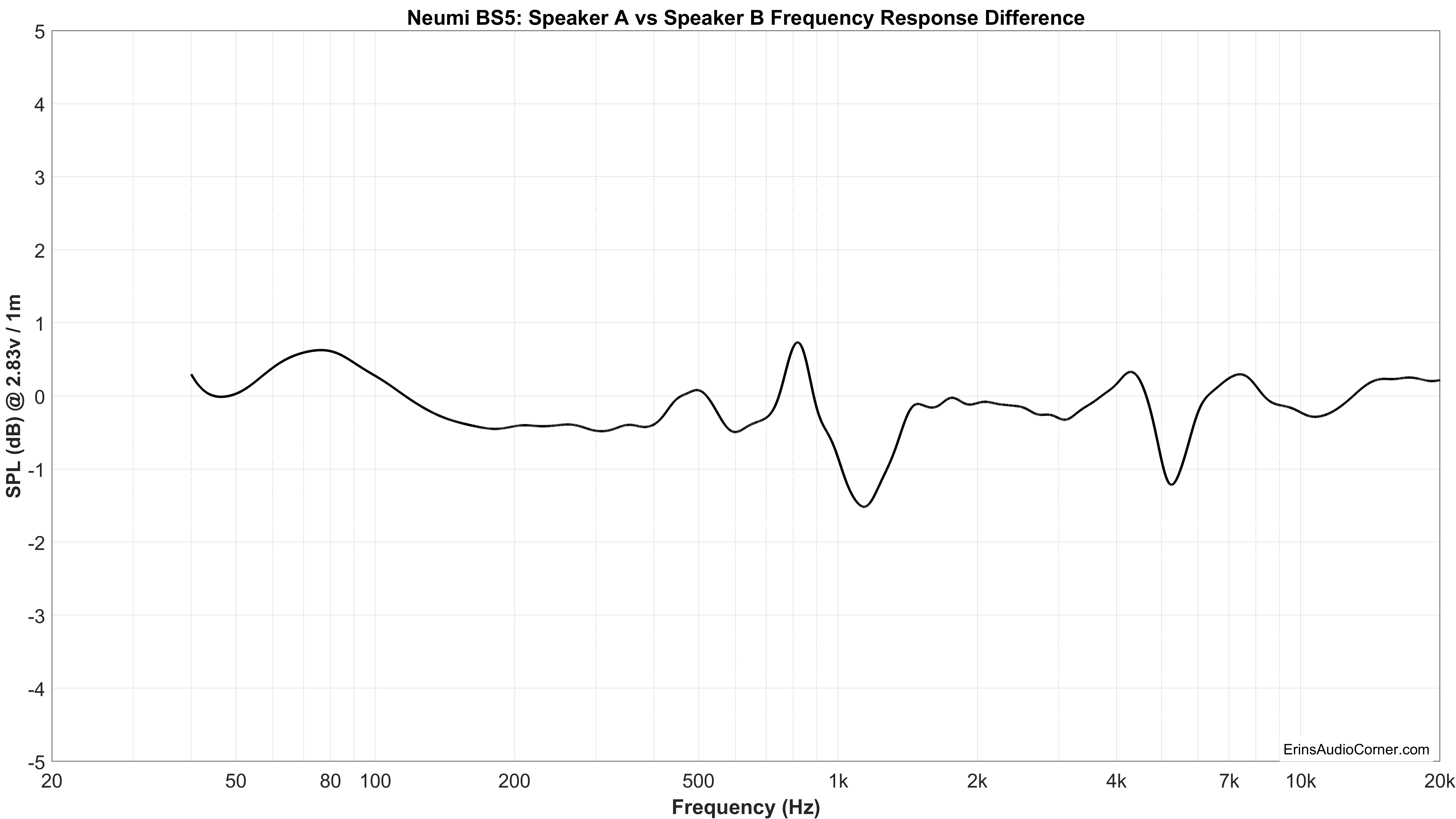
Grille on vs Grille off at 0° and 45°.
The grille on case results in an increase in comb filtering (higher amplitude peaks/dips). Leave the grille off.
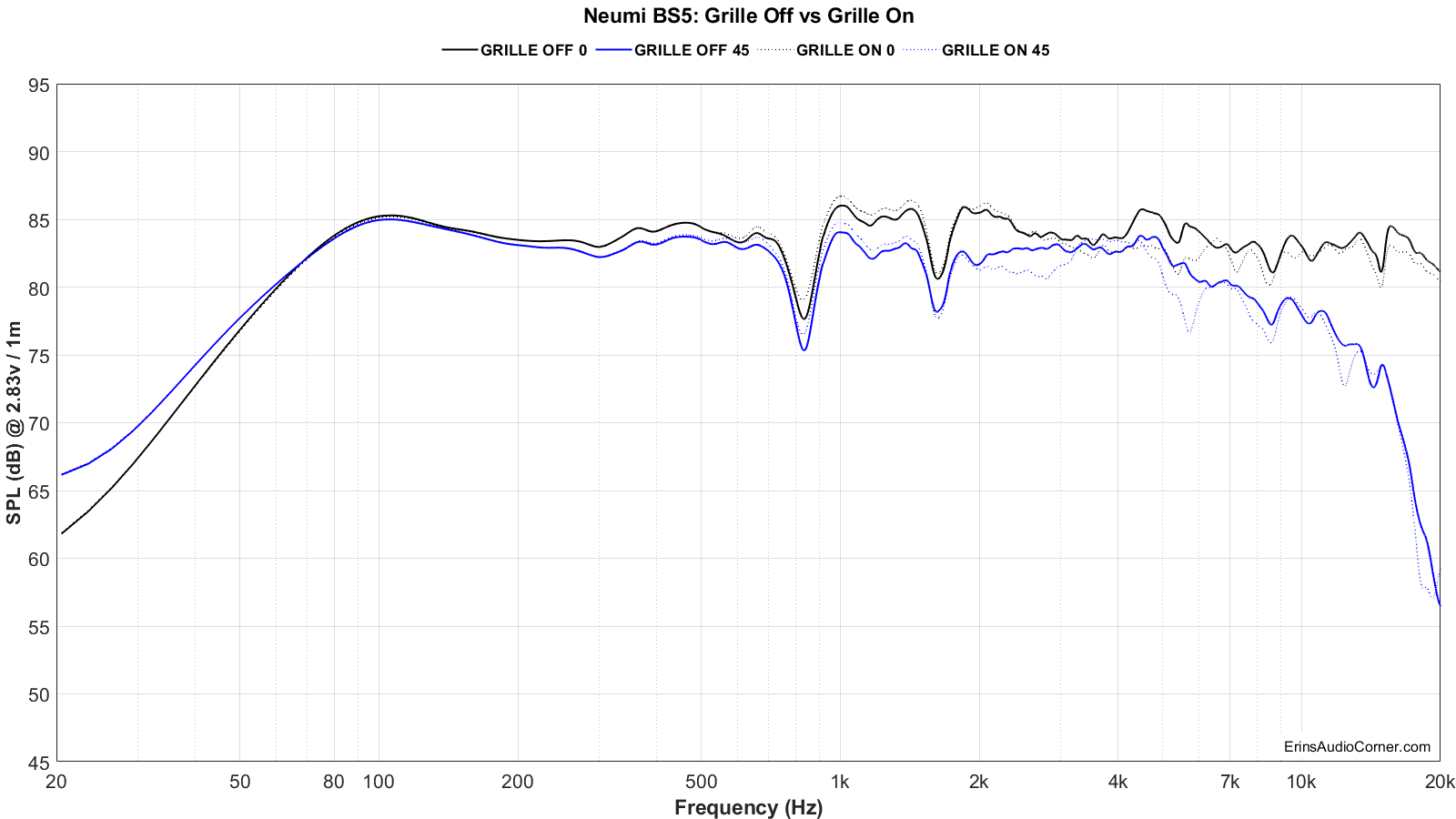
Accelerometer Cabinet Resonance Test.
I used an accelerometer. I attached the accelerometer to the side (top, middle, bottom), back and front of the cabinet and fed a 2.83vRMS signal through the speaker.
I have overlaid all these results against the on-axis response as well. Note, however, the accelerometer is NOT calibrated for level and therefore is only intended to show relative changes. What you look for in this data is large peaks that would indicate a resonance. I’m seeing a lot of mountains and molehills, but I don’t think this data is conclusive enough to do anything other than make a mountain out of a molehill. Others may disagree.
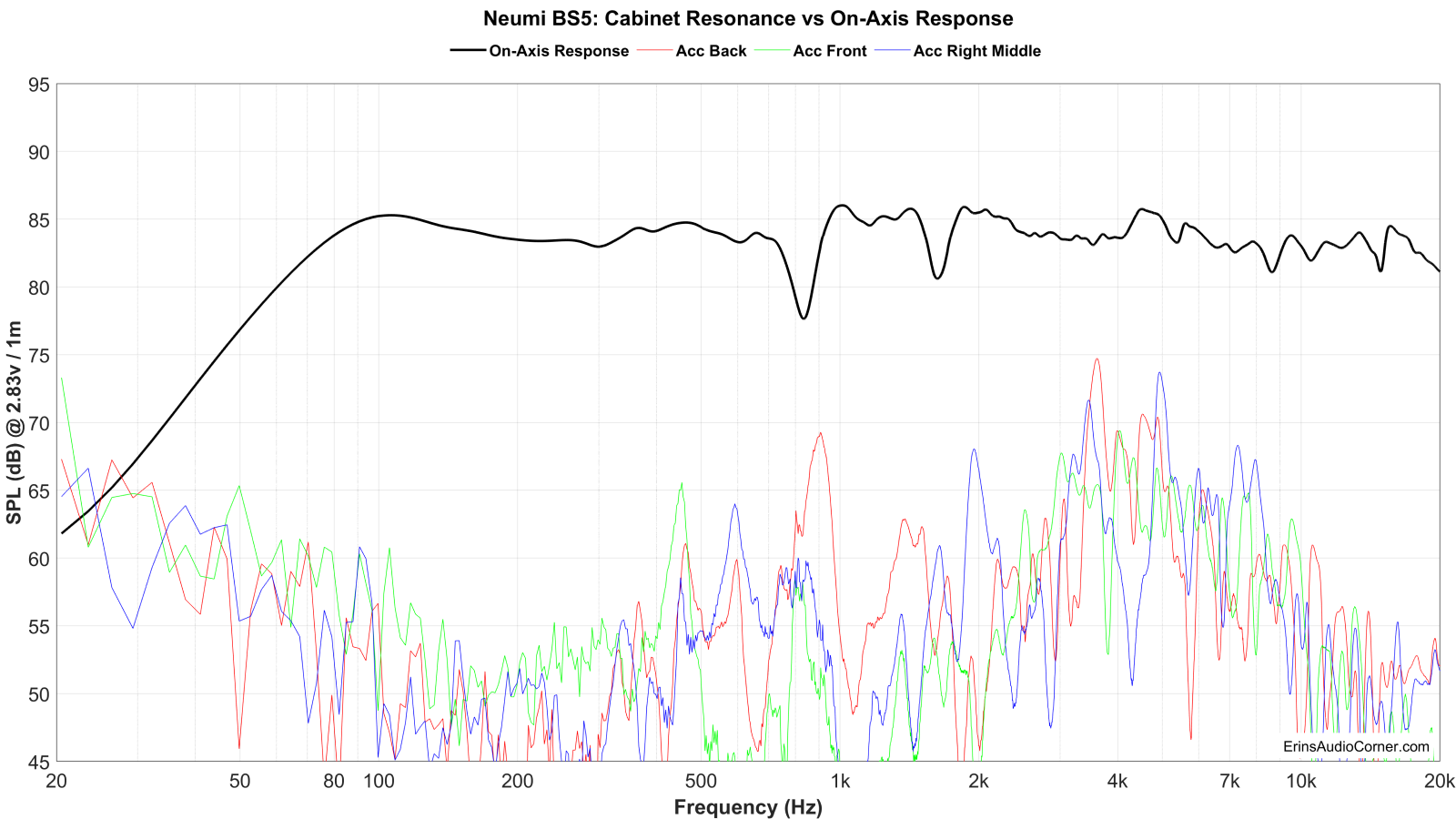
Since the accelerometer is not calibrated for voltage in the above graphic, I chose instead to view the results via a Sonograph, shown below. This shows a long decay for 800Hz - 900Hz. This seems to line up with a resonance of the ports, shown in the next section.
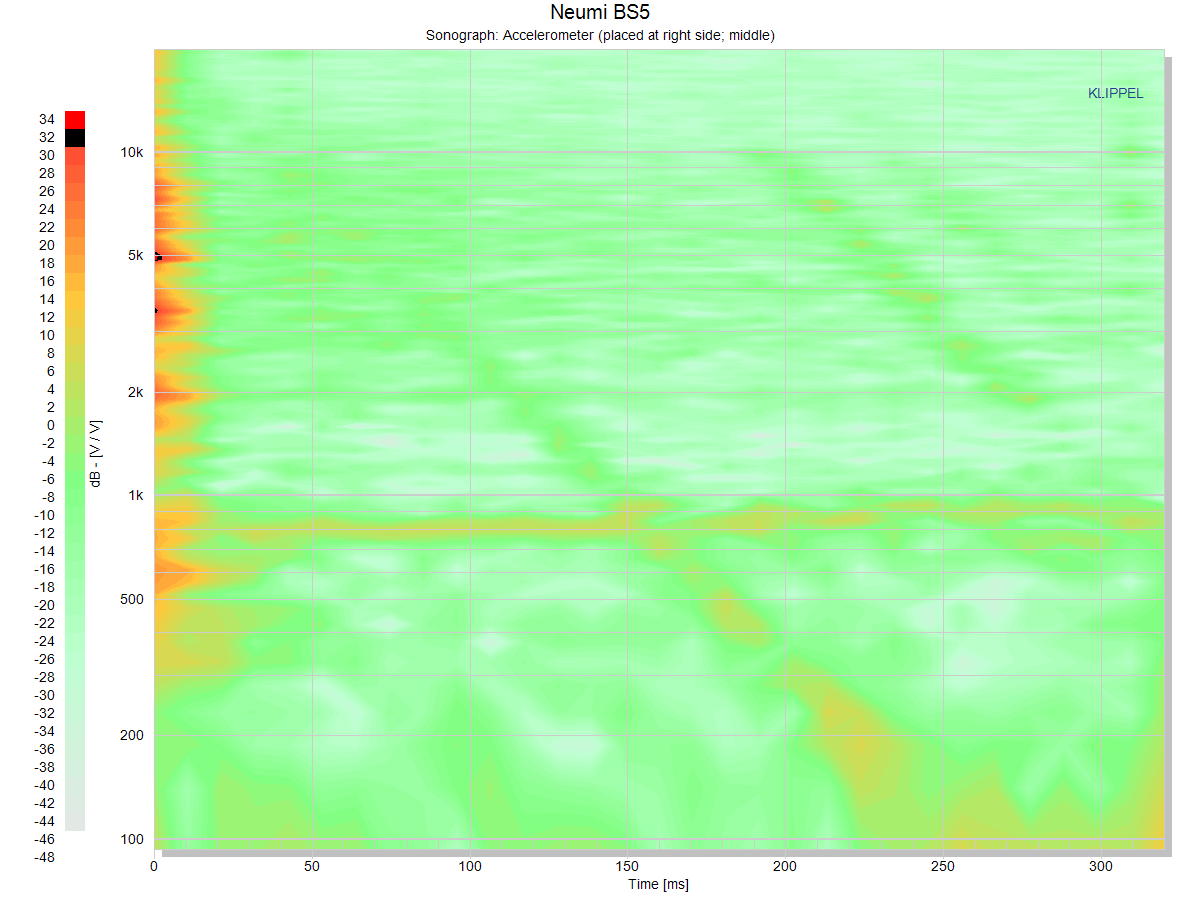
Nearfield measurements.
Mic placed about 0.50 inches from each drive unit and port. While I tried to make these as accurate in SPL as I could, I cannot guarantee the relative levels are absolutely correct so I caution you to use this data as a guide but not representative of actual levels (measuring in the nearfield makes this hard as a couple millimeters’ difference between measurements can alter the SPL level). Got it? Good.
There are a few noteworthy things here:
- Port resonance is very, very strong and clearly contributes to the on-axis response dips at ~800Hz and ~1600Hz.
- The area between 300Hz to 700Hz (just before the 800Hz dip) is elevated slightly. This area also lines up with the increased THD levels I discussed earlier. This could be coincidence. But I believe they are related. Maybe the port is having more of an effect in this region than it needs to?
- Woofer break-up contributes to a few on-axis resonances we see. Particularly, 4.5kHz.
- There are other things going on here but I don’t have the time to reverse engineer this speaker. Not that I could.
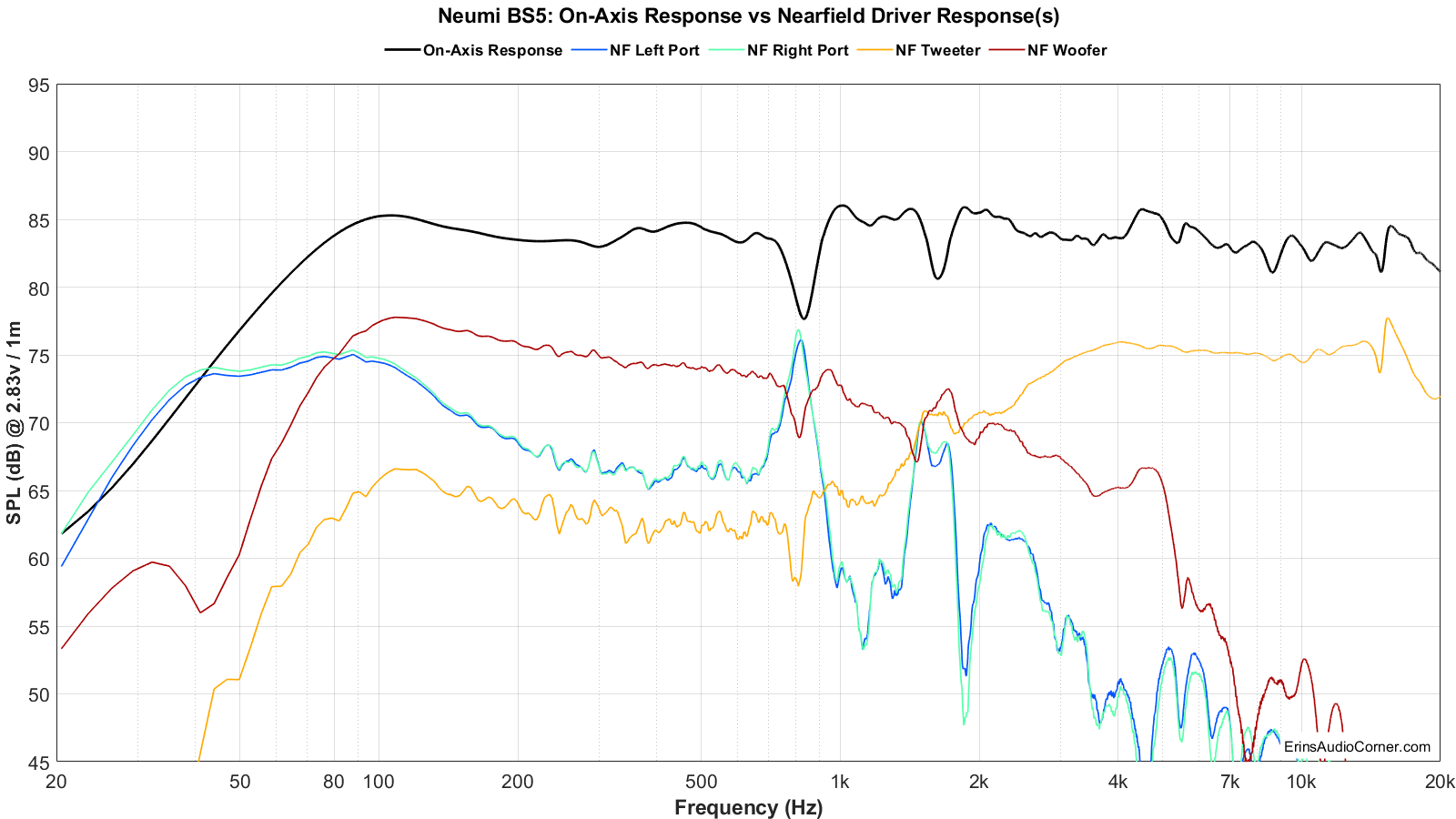
Step-Response.
One not zoomed and one zoomed.
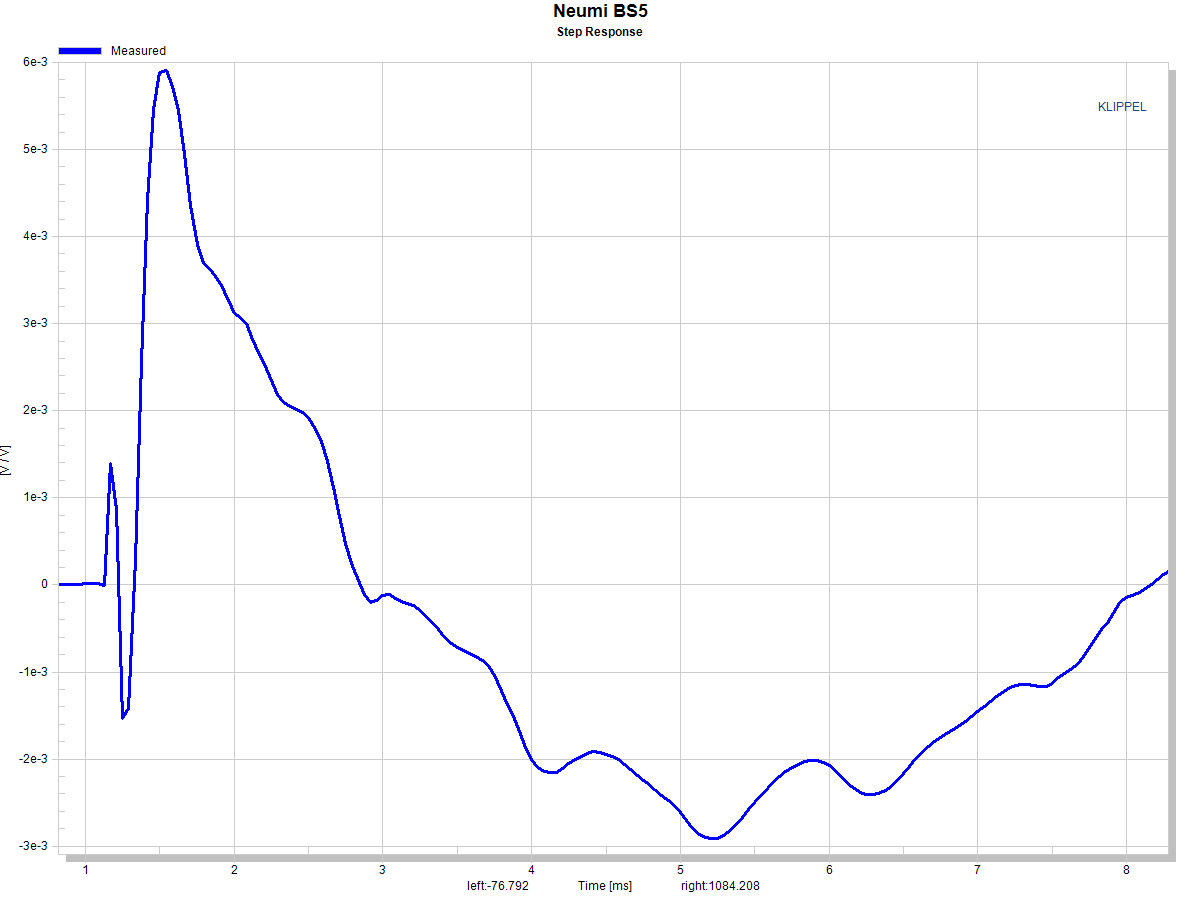
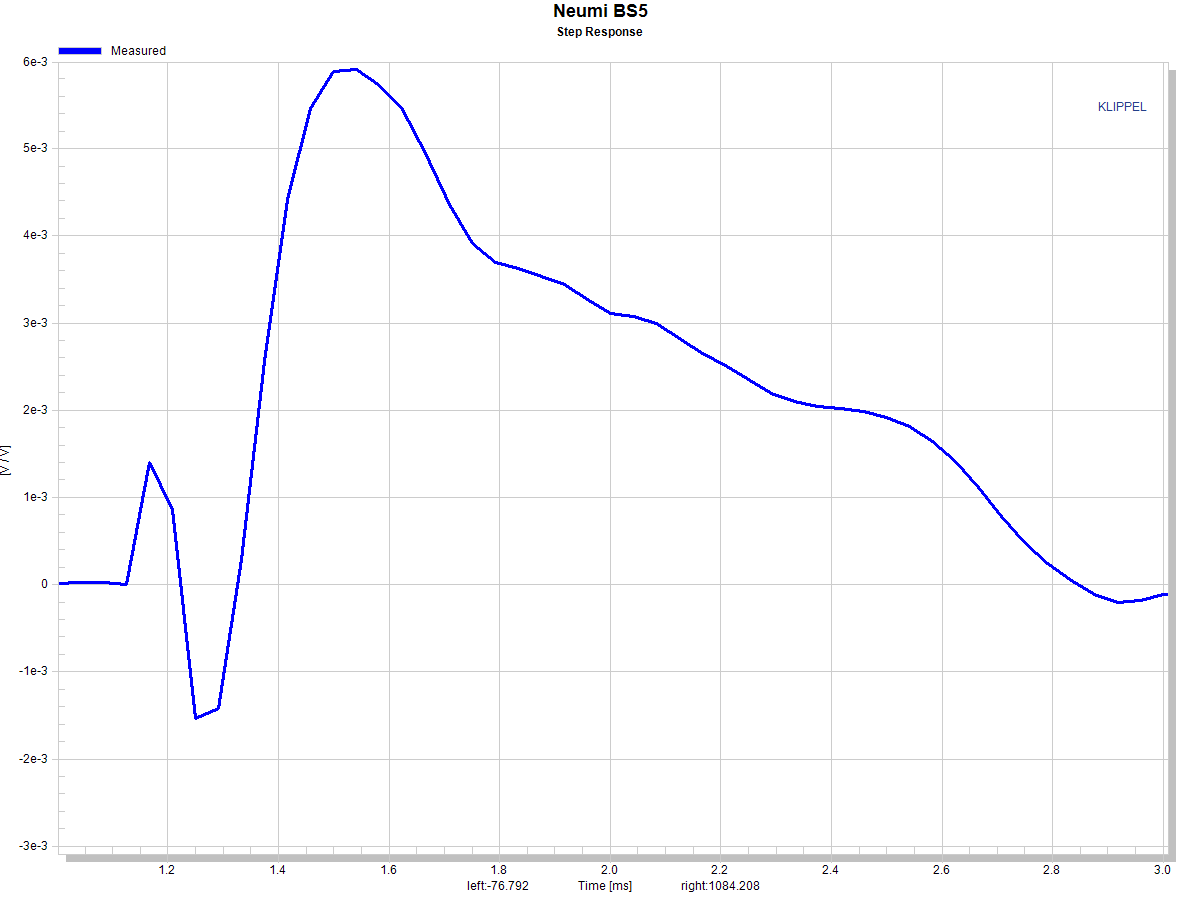
Plugging the port (making the speaker sealed).
To test whether the ports were, indeed, the culprit of the deep nulls I took my socks off and plugged the ports. Don’t worry, I had only been wearing the socks for 3 days. Sure enough, plugging the ports filled in the nulls. But it also decreased the low frequency output by about 2dB below 300Hz.
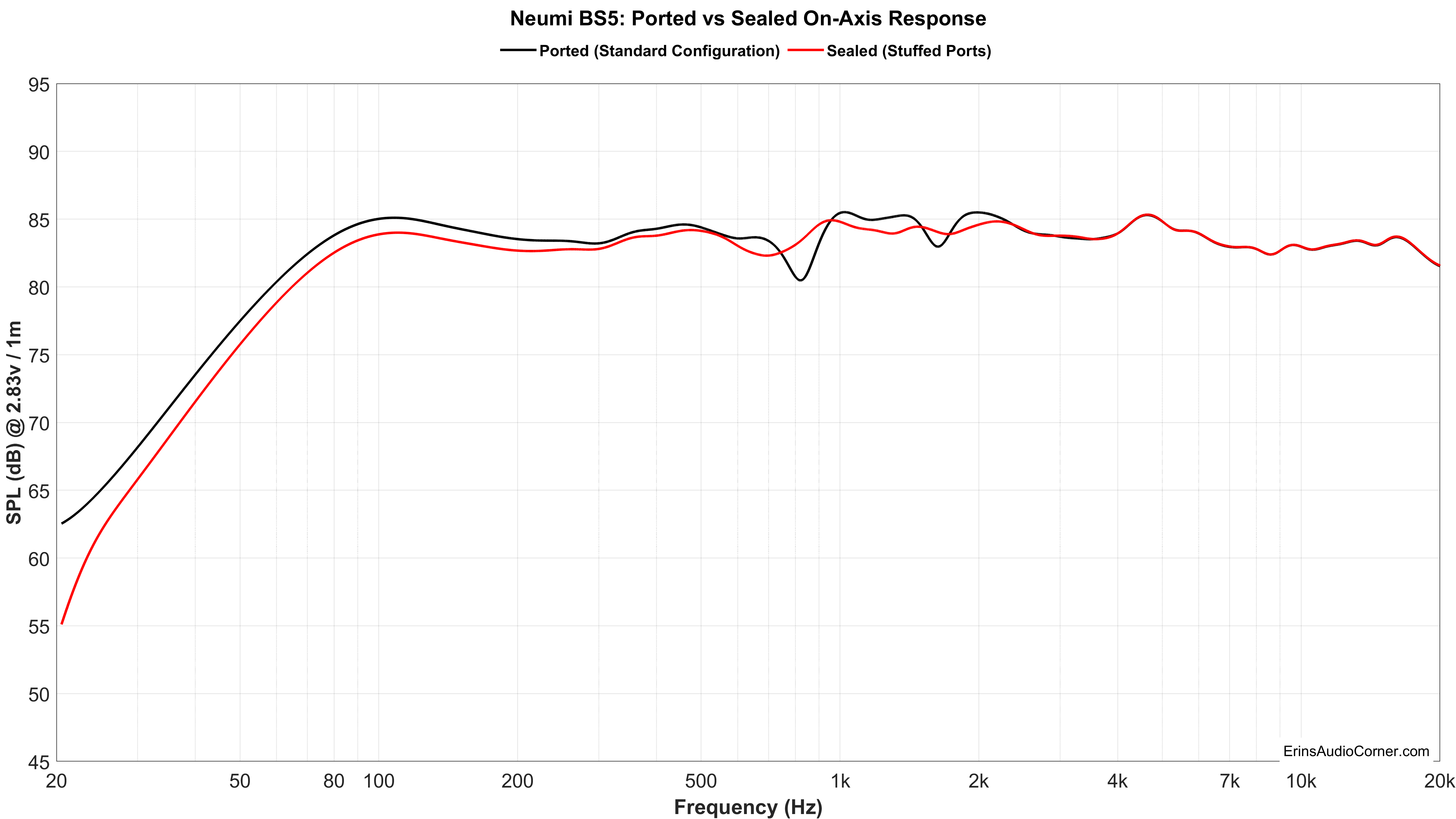
Objective Evaluation:
Much of what I am about to say I have already touched on under the data. But to recap:
Impedance:
- Minimum load of about 4.6 Ohms. But mostly > 6 Ohms. Check your receiver or amplifier’s spec to make sure it can drive a 6 Ohm load without issue.
- Wiggles around 200Hz and 280Hz indicate resonance which also shows up in frequency response.
Frequency Response/Spectrograms/Globes/Spinorama:
- I measured an average of 84.2dB @ 2.83v/1m.
- I measured a ±3dB response from 64Hz - 20kHz but only if you ignore the dip in response around 800Hz. Neumi claims a ±3dB window of 50Hz - 20kHz (typical in-room). Buy a subwoofer if you want to listen loud and low.
- Numerous resonances; most caused by the port. Woofer breakup shows up in a few places as well.
- Directivity shifts caused by inadequate crossover order and resonances from the ports and woofer.
Distortion/Compression:
- High distortion at 40Hz but understandable given woofer size.
- High levels of compression at high output below 100Hz.
- Elevated midrange distortion (audible at higher volumes).
- These are both audible effects when listening full-range as I did.
- Don’t expect much bass below 80Hz out of these speakers. Buy a subwoofer for that.
If more time/money were spent on taming the resonances and break-up modes I think this speaker could be markedly improved. But, for $90, you kind of expect these things. Namely because higher order crossovers are not cheap and take up real-estate.
Subjective Evaluation:
Before I dive in to using hyperlatives (hyperbole + superlatives) let me first give you the layout of my room…
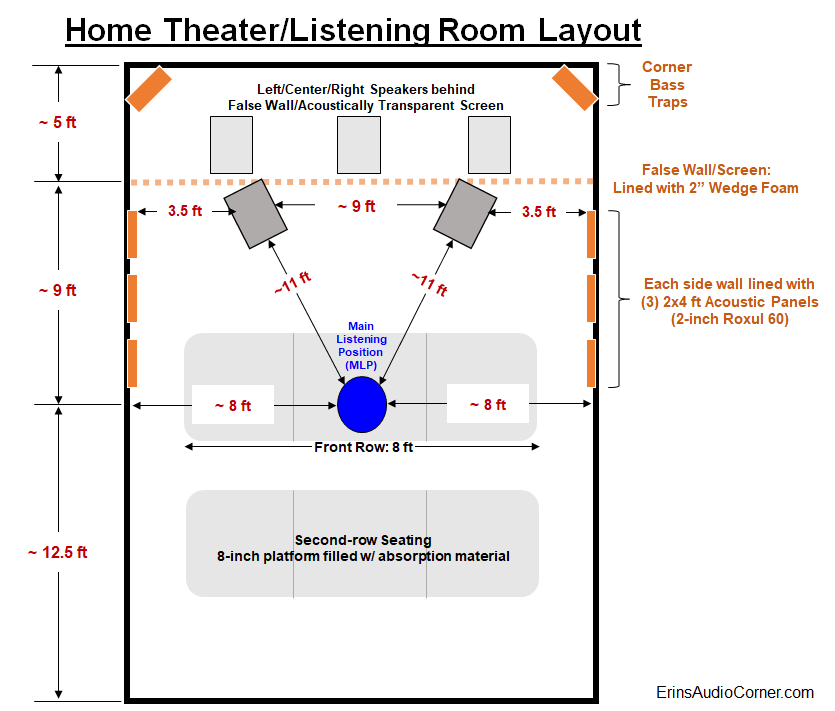
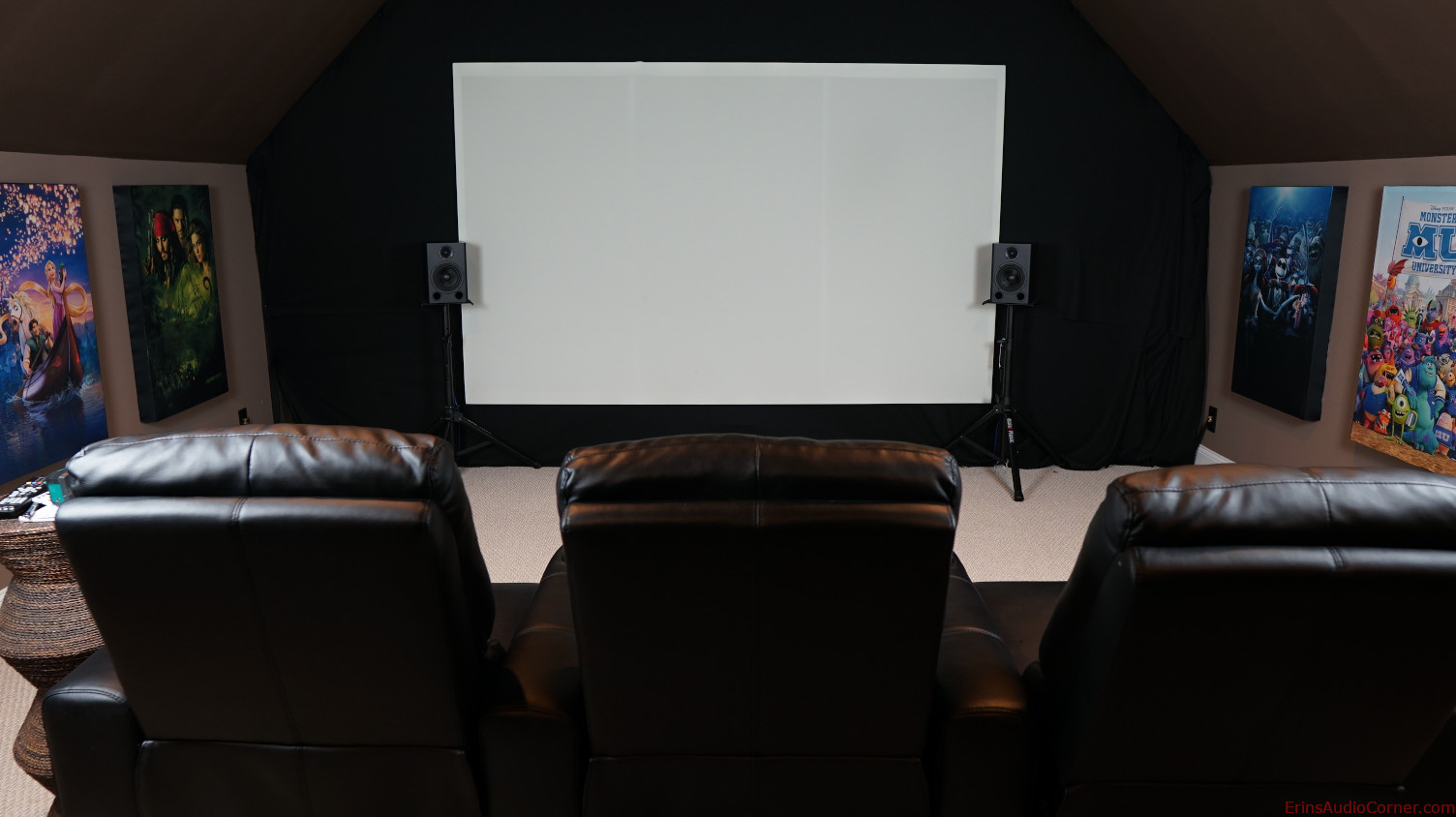
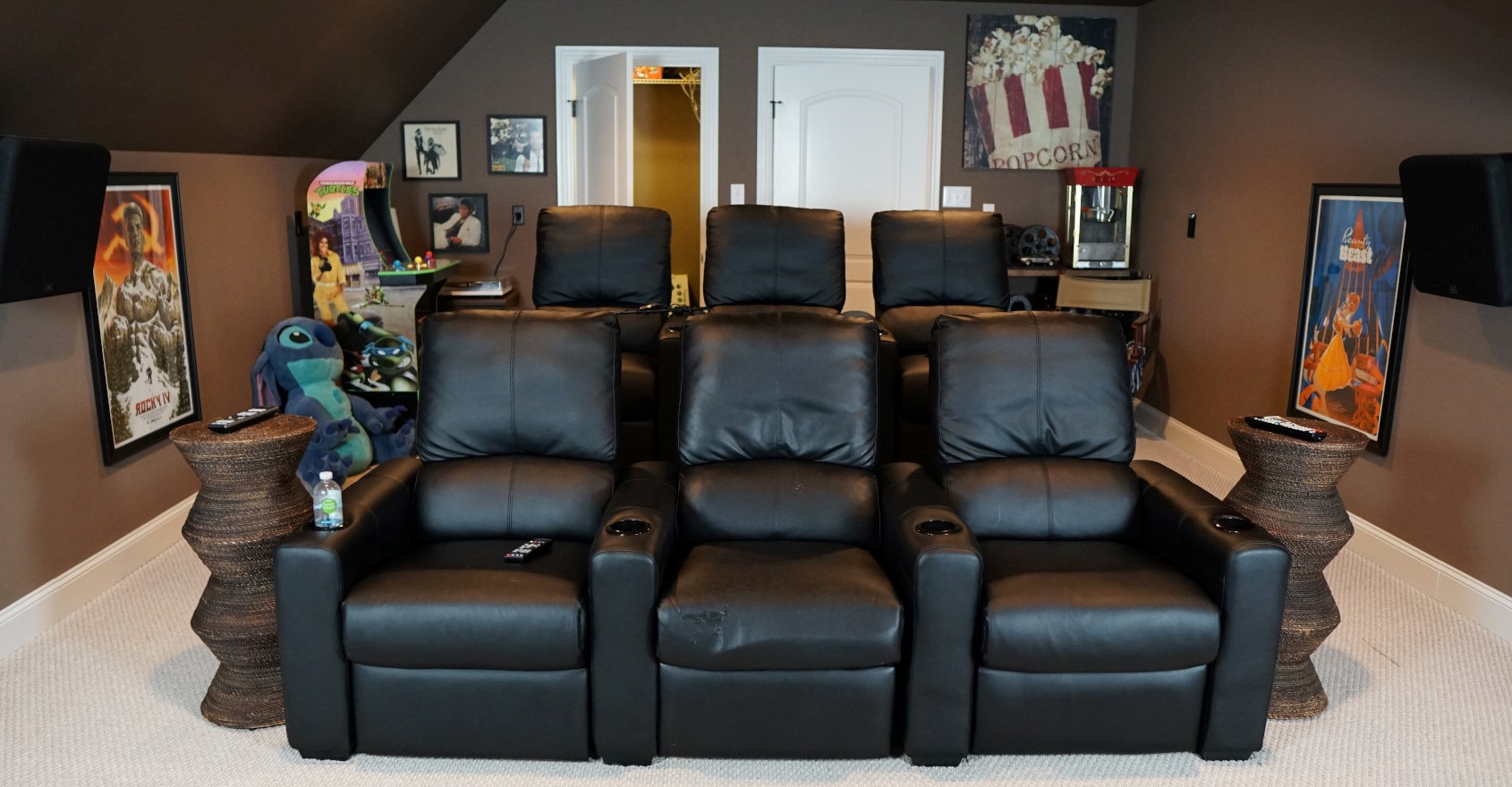
If the false wall part is odd to you, here's some background. I don't like seeing speakers when watching a movie. So, I built a false wall and used an acoustically transparent screen with speakers behind it. The wall is only 2x4's; no panels of wood or anything. Just a skeleton of a wall to give me something to attach the screen and acoustic treatment to. There is 2-inch wedge foam affixed to the 2x4 studs and between the false wall and back of the room are the front speakers (L/C/R & 18-inch subwoofers).
My demo music:
| Title | Artist | Album |
|---|---|---|
| Let It Whip | Dazz Band | 20th Century Masters: The Best Of Dazz Band |
| These Dreams | Heart | Heart (MFSL) |
| Cherry Bomb | John Cougar Mellencamp | The Lonesome Jubilee |
| I Don’t Care Anymore | Phil Collins | Hello, I Must Be Going! |
| Enjoy The Silence | Depeche Mode | Best Of Depeche Mode, Vol. 1 |
| Higher Love | Steve Winwood | Back In The High Life (MFSL UDCD-611) |
| 24K Magic | Bruno Mars | 24K Magic |
| Magic | The Cars | Heartbeat City (MFSL) |
| Something About You | Level 42 | The Very Best Of |
| Everlasting Love | Howard Jones | The Best of Howard Jones |
| Everybody Wants To Rule The World | Tears for Fears | Songs from the Big Chair (2014 Deluxe Edition - Disc 1) |
| Head Over Heels/Broken | Tears for Fears | Songs from the Big Chair (2014 Deluxe Edition - Disc 1) |
| Know Your Enemy | Rage Against The Machine | Rage Against The Machine (Hybrid SACD) |
| You’re My Best Friend | Queen | A Night at the Opera |
| Heartbreaker | Pat Benatar | In the Heat of the Night (DCC) |
| Doo Wop (That Thing) | Lauryn Hill | The Miseducation of Lauryn Hill |
| The Way You Make Me Feel | Michael Jackson | Bad |
| You Don’t Mess Around With Jim | Jim Croce | 24 karat Gold In A Bottle (DCC) |
Like we all do, I got tired of hearing the same songs, so I made a second CD which includes these tracks:
| Title | Artist | Album |
|---|---|---|
| Enjoy The Silence | Depeche Mode | Best Of Depeche Mode, Vol. 1 |
| Higher Love | Steve Winwood | Back In The High Life (MFSL UDCD-611) |
| 24K Magic | Bruno Mars | 24K Magic |
| Magic | The Cars | Heartbeat City (MFSL) |
| Everlasting Love | Howard Jones | The Best of Howard Jones |
| Kodachrome | Paul Simon | There Goes Rhymin’ Simon |
| Everybody Wants To Rule The World | Tears for Fears | Songs from the Big Chair (2014 Deluxe Edition - Disc 1) |
| Know Your Enemy | Rage Against The Machine | Rage Against The Machine (Hybrid SACD) |
| Doo Wop (That Thing) | Lauryn Hill | The Miseducation of Lauryn Hill |
| Tell Yer Mama | Norah Jones | The Fall |
| Don’t Save Me | HAIM | Days Are Gone |
| He Mele No Lilo | Mark Keali’i Ho’omalu and Kamehameha Schools Children’s Chorus | Lilo And Stitch |
| Wrapped Around Your Finger | The Police | Synchronicity |
| Sledgehammer | Peter Gabriel | So |
| Feel It Still | Portugal. The Man | Woodstock |
| Free Fallin | John Mayer | Where The Light Is |
| Whiplash | The Swampers | Muscle Shoals Has Got The Swampers |
Note: I don’t generally audition speakers with the typical “audiophile” music. I have thousands of high-quality albums ranging from pop to metal to jazz and all around. I don’t typically listen to “audiophile” music because I just don’t enjoy it. It is far more important that your evaluation music be something you are familiar with than it is to be esoteric for the sake of being esoteric. You also want to listen to music you enjoy because auditioning a stereo system shouldn’t feel like a chore. Such is the case in my evaluations. Besides, the subjective evaluation is purely to help tie to the objective data and make sense of what I am hearing to help you all get an understanding of how relevant the data is. As you will see below, my music selection did a great job at providing enough range for me to identify the issues that readily appear in the data.
Subjective Analysis Setup:
- The speaker was aimed on-axis with the vertical listening axis between the mid and tweeter per Neumi’s manual.
- I used Room EQ Wizard (REW) and my calibrated MiniDSP UMIK-1 to get the volume on my AVR relative to what the actual measured SPL was in the MLP (~11 feet from the speakers). I varied it between 85-90dB, occasionally going up to the mid 90’s to see what the output capability was. In a poll I found most listen to music in this range. Realistically, 90dB is loud for long-term listening volume and I find most overestimate their listening volume until an SPL microphone is used to determine the actual level.
- All speakers are provided a relatively high level of Pseudo Pink-Noise for a day or two - with breaks in between - in order to calm any “break-in” concerns.
- I demoed these speakers without a crossover and without EQ.
I listened to these speakers and made my subjective notes before I started measuring objectively. I did not want my knowledge of the measurements to influence my subjective opinion. This is important because I want to try to correlate the objective data with what I hear in my listening space in order to determine the validity of the measurement process. I try to do a few listening sessions over a couple days so I can give my ears a break and come back “fresh”. I also want to be as transparent to you as I can be so below are my subjective evaluations made before I began any measurements.
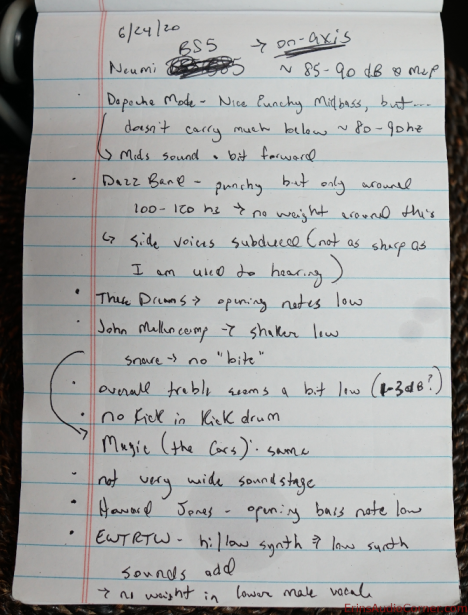
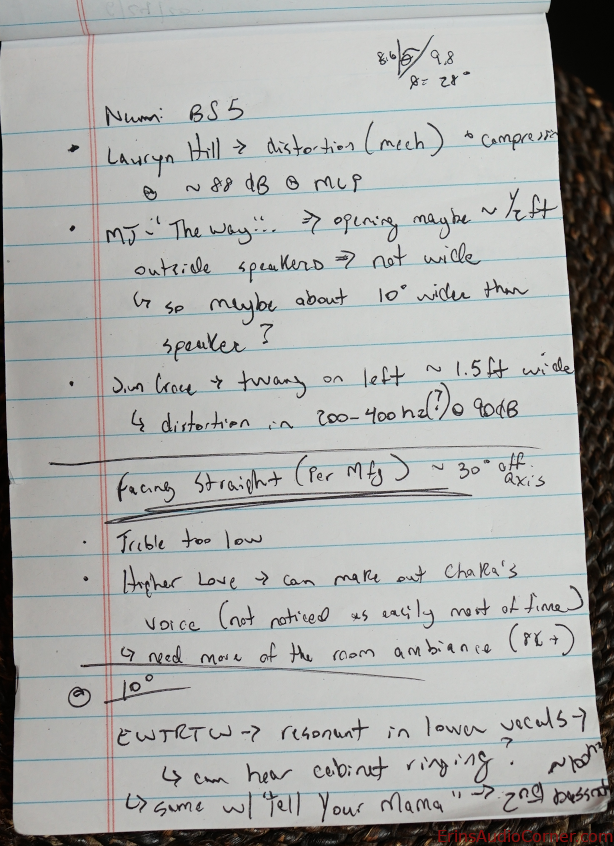
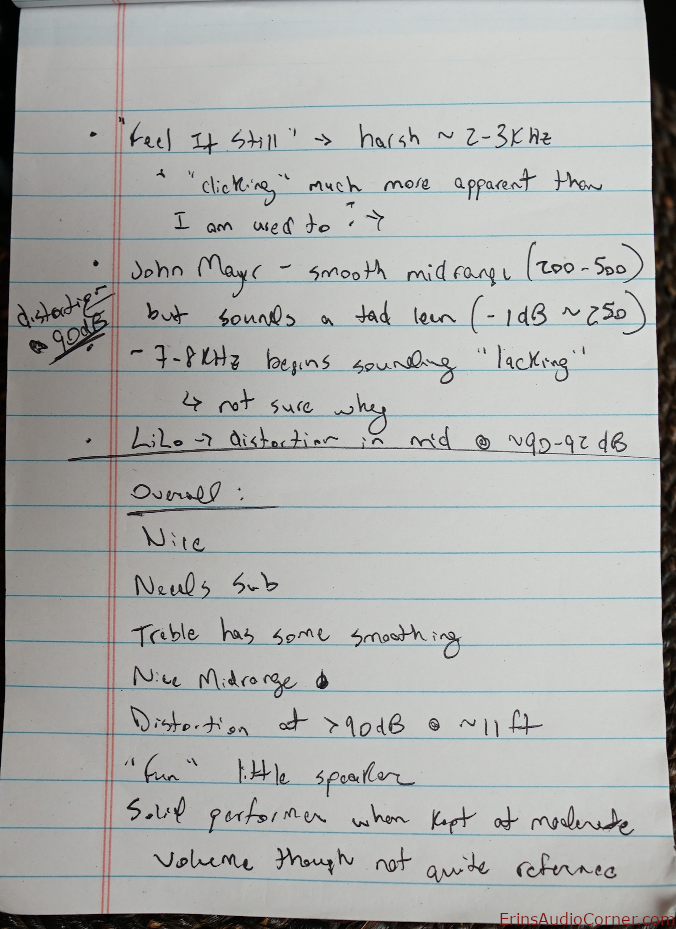
You may notice that I am more descriptive of frequencies than sounds. Many reviewers will quantify their evaluation discussing how a tone sounded or an instrument sounded. My history has always been in relating the sounds to frequencies so I can understand where I need to EQ. So, I’m no good at telling you a cello didn’t sound like it should with a certain fellow of a certain weight playing it. I just go off relative sounds, basically evaluating performance by “How does this frequency sound compared to another”. But I use this method along with this Interactive Frequency Chart and it works out in the end.
Let’s look again at the measured in-room response I provided above. Notice how well it matches the predicted in-room response.
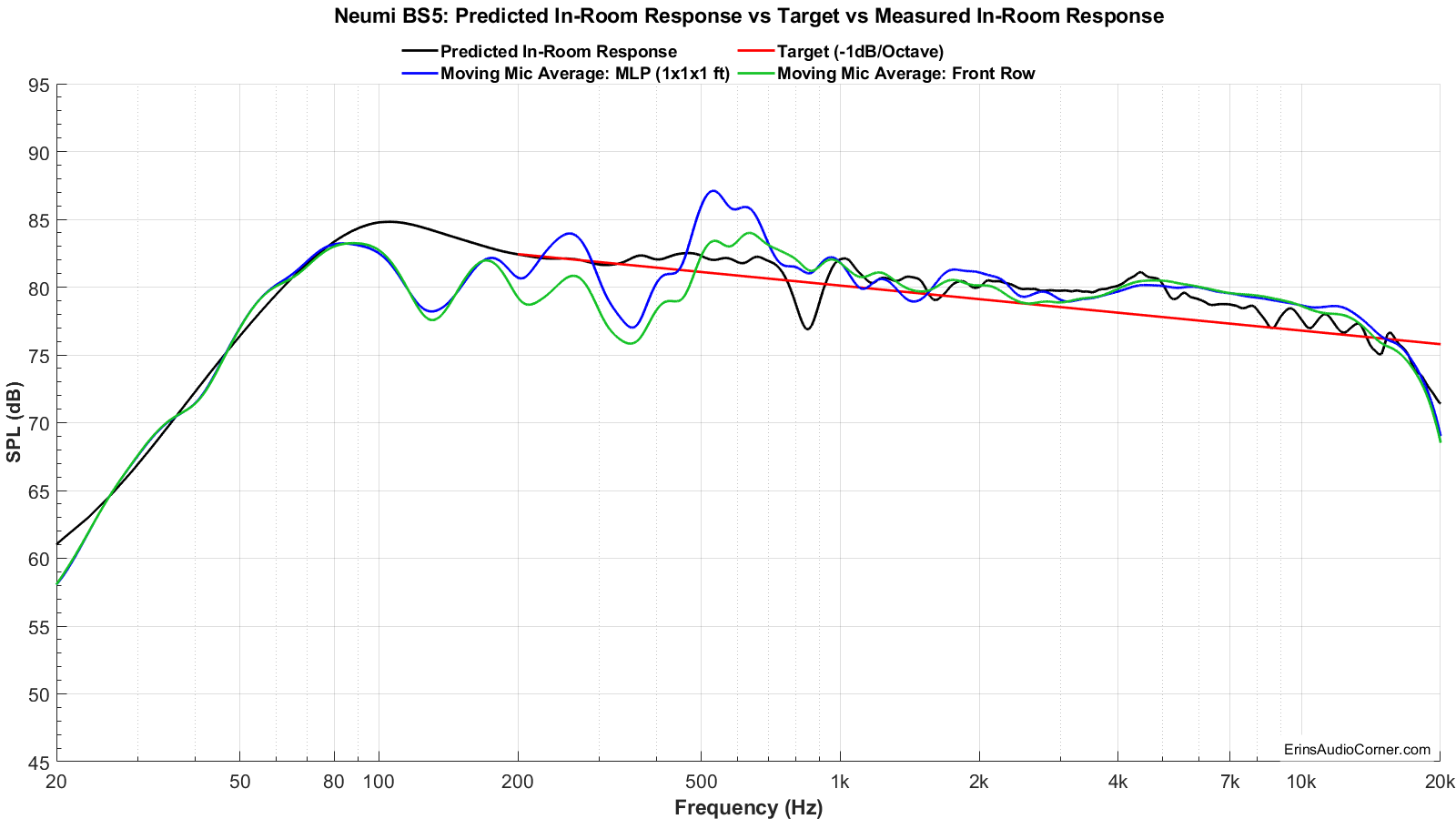
Here’s the rundown of my subjective notes (in quotes) and where it fits with objective:
- Overall, I found the max SPL I could drive the speakers to was around 90-92dB at my listening position, depending on the music. That’s loud. But once I got past this point the compression was very audible and all the dynamics went away. This was most evident on the opening bass notes of Lauryn Hill’s song. It was very evident that I had reached the “brick wall” output here, even though the woofers weren’t mechanically falling apart like I would have expected.
- In my listening tests the main thing that stood out to me was the high-frequency balance being off. In some cases it sounded about 1-3dB too low. In a few cases I heard some ‘sizzle’ on instruments that I do not believe are correct (I didn’t make the album; I can’t know for sure). The data tends to agree with that in relation to the rest of the spectrum. There are some hot spots here and there discussed previously.
- I felt room ambiance was lacking in some recordings. For example, I noted this in “Higher Love”.
- I made a few notes about resonance in lower vocals and questioned if I could “hear cabinet ringing”. I noticed this primarily in “Everybody Wants to Rule the World” and “Tell Yer Mama”.
- I noted midrange distortion at ~ 90dB (at 11 feet) in both Jim Croce’s and John Mayer’s tracks. I wasn’t sure what this was when I listened the first time, but the data clearly shows an increased level of distortion smack in the middle of the midrange. I went back through a final round of listening after I saw the data and on the “He Mele No Lilo” track, at the end, I could hear distortion in the singer’s voice. It seems I noticed this distortion in male vocals.
- I noted some things that I hadn’t heard or wasn’t used to hearing with other speakers. For example, Chaka Khan’s voice as background singer in Steve Winwood’s “Higher Love” was more present. I don’t know what to attribute this to… is it a distortion in the midrange? Is it the breakup from the midwoofer at higher frequencies? Is it a relative thing; the dips at ~800Hz and ~1600Hz causing other areas to be more noticeable than a more flat speaker?
- The bass was punchy; the harmonics of kickdrums and synth sounded good. But there was no weight to those because the speaker just doesn’t play that well below about 100Hz.
- The stage width was a weird one. In some songs it didn’t seem wider than 10° outside the speakers (so, about 40° total) where with other songs it was wider than this. Each recording is different, and you do want a stereo system that expands and contracts proportionately with the music. But I believe the variance in this case is more attributable to the directivity changes caused by the crossover and resonances.
I also turned the speakers to be about 10 to 30° off-axis to see if I could get rid of the harsh treble. That didn’t help much at all and when you view the data you can see the off-axis response has low directivity around 4kHz (meaning, the sound is more omnidirectional at this frequency) which indicates the bright 4kHz region would be noticeable through a wider region of angles. I believe this explains the “biting” noise I was hearing as well.
I didn’t have a chance to run Dirac Live so I can’t speak to what the sound would be post room correction.
Bottom Line
This speaker doesn’t measure perfectly. And, for the most part, I was able to match areas of concern between my subjective listening session and my measurements. Though, I didn’t have any significant gripes about the sound. The one main dislike for me was the reduced treble compared to the midrange. The bass is pretty well blended to the midrange despite the moderate bump in response around 100Hz. There is not much output below this at higher levels, but I can forgive the shortcomings in the bass department because the BS5 isn’t trying to pretend that it can play like a subwoofer. I have seen other 5-inch woofers with higher linear excursion than what these woofers are seemingly capable of but just one of those drive-units alone costs more than this pair of speakers. The midrange distortion is an issue if you’re going to listen at high levels; for me being at 90dB at 11 feet (which is about 93dB at 8 feet per this awesome calculator). These aren’t reference level speakers. But I think anyone buying them understands the implicit output limitations. Under 90dB at 11 feet, the sound is more balanced and undistorted.
Neumi’s manual states to place these “At least 6 inches away from the back wall”. That’s typical of speaker recommendations and is so in order to keep from boundary interferance, which would result in comb filtering of the response (peaks/dips) and would mar the sound. Personally, however, I think these speakers would be better suited as desktop/computer speakers sealed (stuff the ports) and against a wall. The wall would give you a +6dB increase on the lower end to help make up for the plugged ports but plugging the ports would get rid of the nasty resonances that plague this speaker. I would not place these in a corner in a small room, though. Doing so creates a combing effect you do not want. Alternatively, you can use these as small satellite speakers for a budget-minded home theater. However, if you want ultimate hi-fidelity at reference levels on a shoestring budget then these speakers are not it. The frequency response deviations and distortion keep it from that goal. But, when used within reasonable limits, this is a “fun” little speaker that is enjoyable and a great entry into the hi-fi realm at $90/pair. I hate using the “but it’s cheap” argument but, really, this is a $90 pair of bookshelf speakers. More than that, though, there’s no marketing language by Neumi to suggest they are the best speakers ever. Nothing that overstates their capabilities that I have seen. I think Neumi had a target in mind with this price and performance and I believe they hit it.
I’m going to plug my Amazon affiliate link one last time just in case you want to buy these. I know, I know… I’m a sellout.
The End
If you like what you see here and want to help me keep it going, you can donate via the PayPal Contribute button at the bottom of each page. Testing and reporting the data and analysis takes me approximately 8-10 hours each. It’s definitely a labor of love. That said, there’s no fame or fortune in this and all my test speakers are typically purchased and paid for by myself with help from contributions or purchases made through my affiliate links (which is negligible). Your donations help me pay for new test items, shipping costs, hardware to build and test, etc. Even a few dollars is more helpful than nothing. If you don’t mind chipping in a few bucks now and again it would truly be appreciated.
You can also join my Facebook and YouTube pages via the links at the bottom of the page if you’d like to follow along with updates.
Thanks!


